Paul van Yperen's Blog, page 241
March 12, 2019
Mae Murray
American actress and dancer Mae Murray (1885-1965) was a strikingly exotic beauty with frizzy blonde hair. She had her breakthrough on Broadway at the Ziegfeld Follies. Her film debut was in To Have and to Hold (1916). In the following years, Murray became one of the biggest stars of Universal. At the height of her career, she founded her own company, Tiffany, together with director and husband Robert Z. Leonard. While her films with Leonard were very successful at the box office, critics didn’t like them. However, they hailed Murray’s most famous part, the title role in Erich von Stroheim’s masterpiece The Merry Widow (1925).
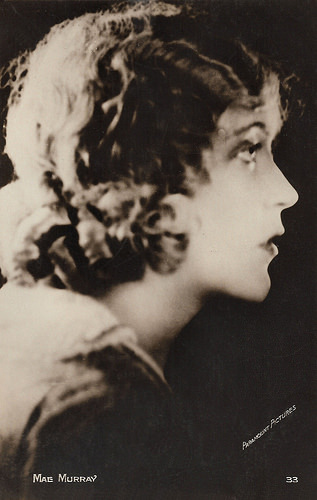
French postcard by Cinémagazine-Edition, Paris, no. 33. Photo: Paramount Pictures.
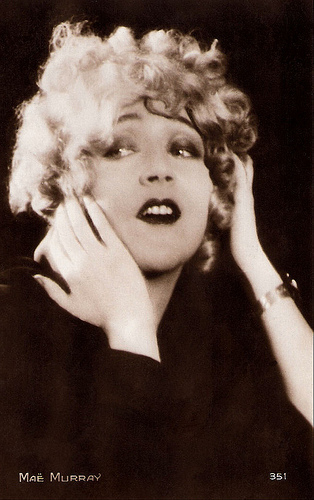
French postcard by Cinémagazine-Edition, Paris, no. 351.
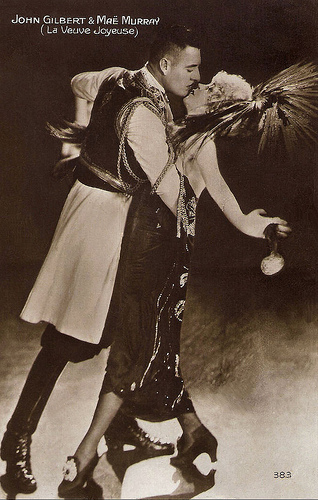
French postcard by Cinémagazine-Edition, Paris, no. 383. Photo: Metro-Goldwyn-Film. Publicity still for The Merry Widow (Erich von Stroheim, 1925) with John Gilbert.
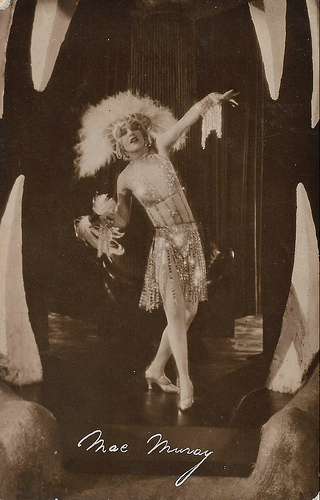
French postcard, editor unknown. Publicity still for The Masked Bride (Christy Cabanne, Josef von Sternberg, 1925).
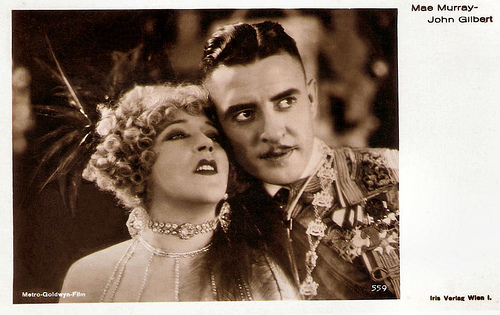
Austrian postcard by Iris Verlag, no. 559. Photo: Metro-Goldwyn-Film. Publicity still for The Merry Widow (Erich von Stroheim, 1925) with John Gilbert.

Austrian postcard by Iris Verlag, no. 794/2. Photo: Fanamet.
Lifting up her nose and showing her teeth
Mae Murray was born as Marie Adrienne Koenig in Portsmouth in 1885. She was the second-oldest child of Joseph and Mary (née Miller) Koenig, both children of European emigres. In May 1896, Joseph Koenig died from acute gastritis due to his alcoholism. To support the family, Mary Koenig took a job as a housekeeper for businessman Harry Payne Whitney.
Marie began studying dance at a young age. In Chicago, she was employed by a number of nightclubs as a chorus girl. In pursuit of the dream of stage stardom, she moved to New York. Reportedly, she created her stage name May Murray there by taking 'May' from the month she was born and 'Murray' from one of her favourite hangouts, Murray's Restaurant on 42nd Street.
In 1906, Murray had her debut on Broadway as the partner of ballroom dancing extraordinaire Vernon Castle in Irving Berlin’s first musical About Town. She was an emergency replacement for Irene Castle. In 1908 she became a chorus girl at the Ziegfeld Follies, and in 1915 she became the leading lady at Ziegfeld. Her first number imediately stunned the star-studded opening night audience. People screamed and threw flowers at her feet on the stage. Next, Murray became a star of the club circuit in both the United States and Europe, performing with many dance partners including Clifton Webb, Rudolph Valentino, and John Gilbert.
Mae soon became accustomed to her own celebrity, the companionship of high society, and the attention of millionaires anxious to be seen with the latest toast of Manhattan on their arms. In September 1908, in Hoboken, New Jersey, while she was appearing in the Follies of 1908, Murray married William M. Schwenker, Jr., the unemployed son of a brewery-supply dealer, who cut off his son's allowance upon news of the wedding. The pair divorced in 1910. In 1916, she married former dancer and future Olympic bobsled champion Jay O'Brien. They divorced in 1918.
Adolph Zukor signed her to a screen contract with Paramount. Her film debut was in the silent adventure drama To Have and to Hold (George Melford, 1916) with Wallace Reid. In the following years, Murray acted in a string of box office hits, including The Dream Girl (Cecil B. DeMille, 1916) with Theodore Roberts , and A Mormon Maid (Robert Z. Leonard, 1917), in which she played alongside then-actor Frank Borzage. Director and producer Robert Z. Leonard became her third husband.
With Robert Z. Leonard, she joined Universal to open her own production unit, Bluebird, and Leonard directed most of Murray’s films in the late 1910s and early 1920s. Many of their films, contained dance sequences which were designed especially for her. In 1919, she paired up with friend and former dance partner Rudolph Valentino in The Delicious Little Devil (Robert Z. Leonard, 1919) and Big Little Person (Robert Z. Leonard, 1919). These 'silent musicals' were usually constructed on a framework of light romance or comedy set in exotic locales or historical settings. Elaborate decor and magnificent costumes enriched the visuals. Their success made Mae Murray into one of Universal's biggest stars.
Mae became a defining example of silent film excess. She was promoted in all the fanzines flaunting the lifestyle expected of Hollywood royalty, spending her millions on jewelry, motorcars, race horses, couture. In 1922, 'The Girl with the Bee-Stung Lips' started acting at Metro (later MGM). With husband Robert Z. Leonard and M.H. Hoffman, she had founded Tiffany Productions (1921-1933). Murray and Leonard signed with Louis B. Mayer to make films for Metro under the Tiffany label. They made eight films together, showcases for Murray’s extravagant and florid performance style. After Circe the Enchantress (Robert Z. Leonard, 1924), Murray and Leonard parted. They officially divorced in 1925.
While her films with Leonard were successful at the box office, the critics didn’t like them, because of her exaggerated emotions and her over-the-top costumes. Her overacting, lifting up her nose and showing her teeth, was parodied by Marion Davies in the delicious comedy The Patsy (King Vidor, 1928). Although Murray’s presence can be considered excessive and baroque, her fans called her 'The Gardenia of the Screen'. She pleasurably perfumed and intensified audience experience of her 'silent musicals', of which the scores were performed by large orchestras in the movie palaces in the cities, while smaller venues used giant Wurlitzer organs. Her many fans revelled thus in her colourful performances.
Her most famous role is The Merry Widow (Erich von Stroheim, 1925). John Gilbert plays a prince, who must woo the now wealthy dancer he once abandoned in order to keep her money in the country in order to keep it from crashing economically. The reception for the film was superlative. Critics praised the artistic choices, such as the colours in the wedding sequence at the film’s end. Mordaunt Hall in The New York Times : "The Widow is, of course, impersonated by Mae Murray, who demonstrates true acting ability in this effort. Hitherto she was like a top, and one seldom caught much more than a flash of her face. Here she stands still; she wears her costumes with a full realization of their splendor." The Merry Widow boasted the largest box office for any Hollywood studio in 1925, and would remain the most successful film both Murray and von Stroheim ever made.
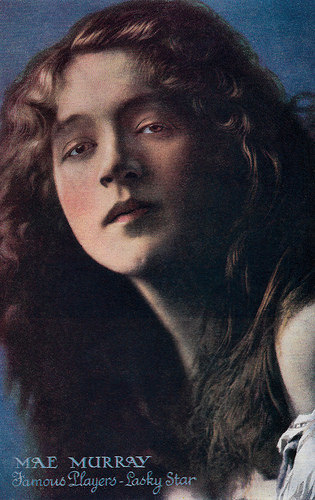
British postcard. Photo: Famous Players-Lasky.
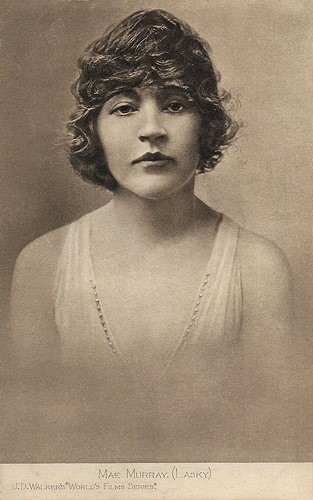
British postcard in J.D. Walker's "World's Film Series". Photo: Lasky.
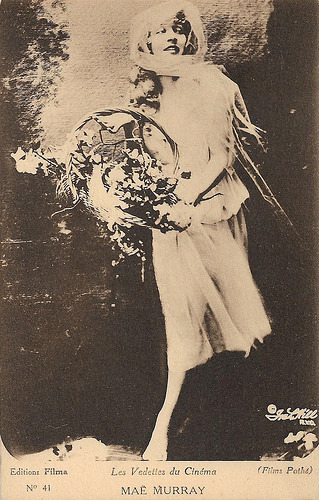
French postcard by Editions Filma in the Les Vedettes du Cinéma series, no. 41. Photo: John Hill / Films Pathé.
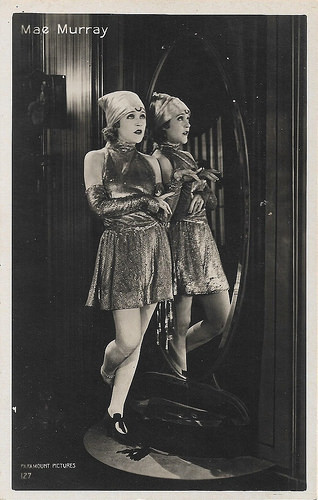
Italian postcard by Vettori, Bologna, no. 127. Photo: Paramount Pictures.
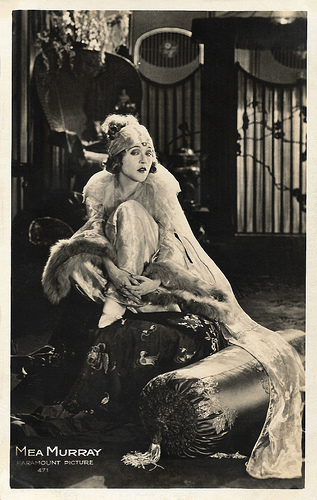
Italian postcard by G. Vettori, Bologna, no. 471. Photo: Ernest Bachrach / Paramount Pictures. Publicity still for The Gilded Lily (Robert Z. Leonard, 1921).
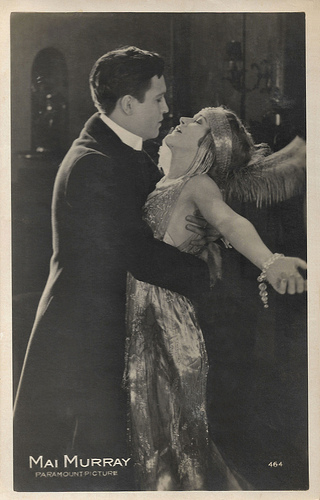
Italian postcard by G. Vettori, Bologna, no. 464. Photo: Ernest Bachrach / Paramount Pictures. Publicity still for The Gilded Lily (Robert Z. Leonard, 1921) with Monte Blue.
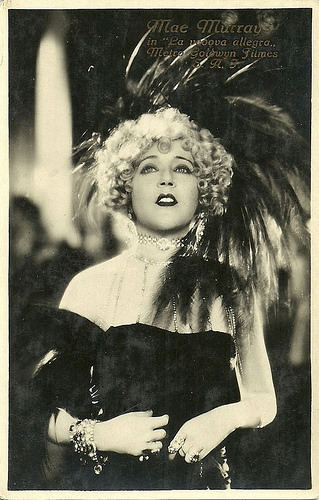
Italian postcard by G.B. Falci, Milano. Photo: MGM. Publicity still for The Merry Widow (Erich von Stroheim, 1925).
Doing all to mask her age
Mae Murray's fourth husband was ‘Prince’ David Mdivani, a Georgian man of minor aristocratic roots, whose brothers Serge and Alexis married actress Pola Negri and the heiress Barbara Hutton respectively. The father of the 'marrying Mdivani' trio, later admitted that he was the only Prince to ever inherit a title from his sons. When Mae let her prince take control over her business affairs, he ill-advised her to quit MGM. So, Murray made a scene at the studio, stepped out of her contract, and left Louis B. Mayer in 1927. Later, blacklisted by Mayer, she sorely regretted this.
When sound film came along, Mae Murray’s voice didn’t fit her image. Murray made an insecure sound debut in Peacock Alley (Marcel de Sano, 1930), a remake of her silent hit Peacock Alley (Robert Z. Leonard, 1921). Produced by Tiffany Pictures, the film was lavishly produced with elaborate sets despite its low budget. But the fortunes of Tiffany Pictures had now come to an end.
In her next sound film, Bachelor Apartment (Lowell Sherman, 1931), she co-starred with newcomer Irene Dunne, Lowell Sherman, and Norman Kerry. After another RKO production, High Stakes (Lowell Sherman, 1931), she left the film business for good. At Silents Are Golden , J. Stephen Walters writes about her final films: "In these, a capable voice proves equal to sound, but the films otherwise present Mae disastrously - badly photographed low-budget productions, clearly showing her age."
Prince Mdivani had spent all of her money and the couple divorced in 1934. Later, there was a nasty custody battle about their son Koran David Mdivani, born in 1927. After two years, when she finally was given custody, she was unable to care for her son due to financial and personal problems. In 1940, he was adopted by his foster family and his name was changed to Daniel Michael Cunning.
In 1934, Murray returned to Broadway briefly to perform in The Milky Way. In the 1940s, she performed an act at the Times Square establishment Billy Rose's Diamond Horseshoe nightclub. Her dancing in the Merry Widow Waltz was well received, but she was criticised for her youthful costumes and heavy makeup application, doing all to mask her age. In 1946, she taught ballroom dancing to young teenagers at a dance studio in Los Angeles.
In her later years, Mae Murray suffered from financial problems and lived in poverty. In 1959, she was the subject of an authorised biography, 'Mae Murray - The Self-Enchanted', written by Jane Ardmore. Reportedly it sold poorly. Mae ended her days in the Motion Picture Country Home in Woodland Hills in Los Angeles. There she passed away of heart failure in 1965 at the age of 79. She only left a trunk containing clothing and keepsakes.
In the early 1990s the Dutch EYE Film Institute (Nederlands Filmmuseum) found two early Mae Murray films, which she made for Universal: The Delicious Little Devil (Robert Z. Leonard, 1919), with the young Rudolph Valentino , and The ABC of Love (Léonce Perret, 1919). EYE also found and restored Murray’s film The Right to Love (George Fitzmaurice, 1920), a Famous Players-Lasky production.
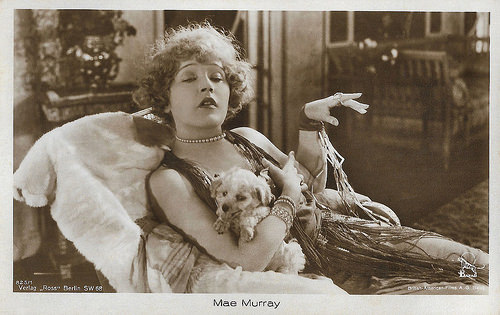
German postcard by Ross Verlag, no. 825/1, 1925-1926. Photo: British-American-Films A.G. (Bafag). Publicity still for Peacock Alley (Robert Z. Leonard, 1922).
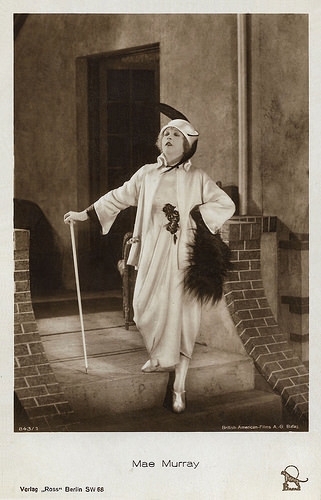
German postcard by Ross Verlag, no. 843/1, 1925-1926. Photo: British-American-Films A.G. (Bafag). Publicity still for Broadway Rose (Robert Z. Leonard, 1922).
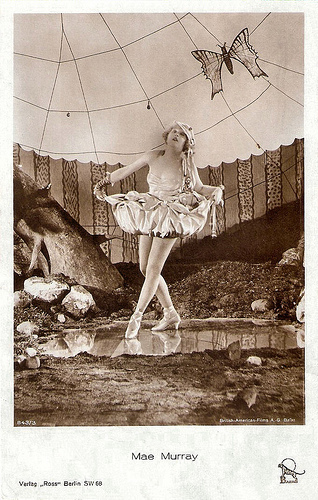
German postcard by Ross Verlag, no. 843/3, 1925-1926. Photo: British-American Film A.G., Berlin (BAFAG). Publicity still for Broadway Rose (Robert Z. Leonard, 1922).
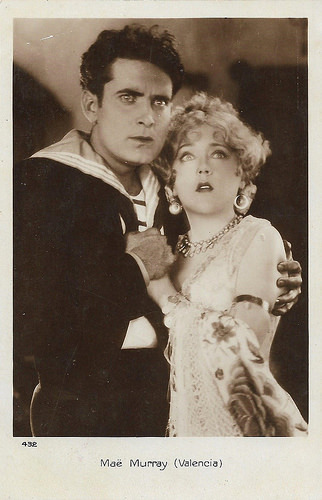
Probably a French postcard, no. 432. Mae Murray and Lloyd Hughes in Valencia (Dimitri Buchowetzki, 1926).
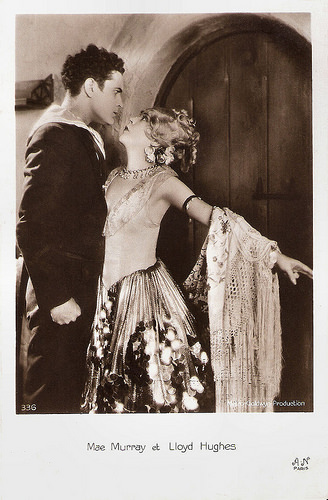
French postcard by A.N, Paris, no. 36. Photo: Metro-Goldwyn Production. Publicity still for Valencia (Dimitri Buchowetzki, 1926) with Lloyd Hughes.
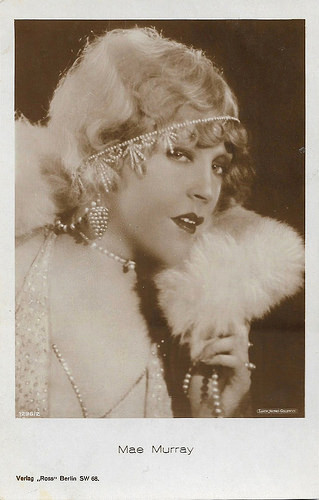
German postcard by Ross Verlag, no. 1296/2, 1927-1928. Photo: Loew-Metro-Goldwyn.
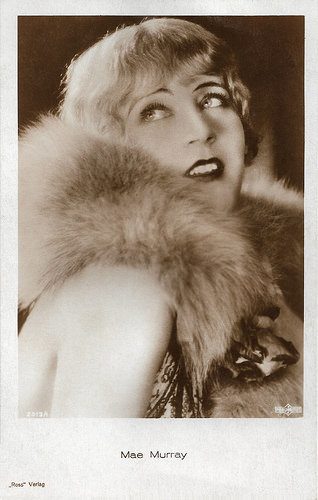
German postcard by Ross Verlag, no. 2013/1, 1927-1928. Photo: Parufamet.
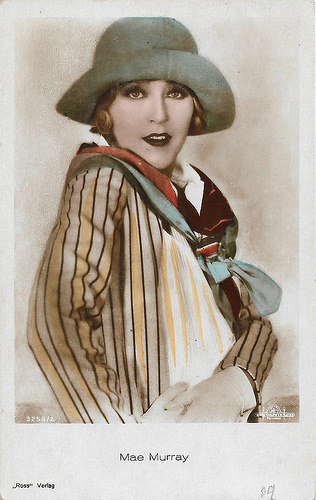
German postcard by Ross Verlag, no. 3253/2, 1928-1929. Photo: Metro-Goldwyn-Mayer.
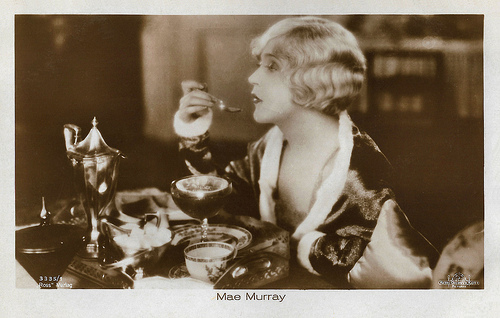
German postcard by Ross Verlag, no. 3335/1, 1928-1929. Photo: Metro-Goldwyn-Mayer.
Sources: Mordaunt Hall (The New York Times), Artemis Willis (Women Film Pioneers Project), J. Stephen Walters (Silent Are Golden), Jimmy Bangley (Classic Images), (IMDb), Wikipedia (English and Dutch), and .

French postcard by Cinémagazine-Edition, Paris, no. 33. Photo: Paramount Pictures.

French postcard by Cinémagazine-Edition, Paris, no. 351.

French postcard by Cinémagazine-Edition, Paris, no. 383. Photo: Metro-Goldwyn-Film. Publicity still for The Merry Widow (Erich von Stroheim, 1925) with John Gilbert.

French postcard, editor unknown. Publicity still for The Masked Bride (Christy Cabanne, Josef von Sternberg, 1925).

Austrian postcard by Iris Verlag, no. 559. Photo: Metro-Goldwyn-Film. Publicity still for The Merry Widow (Erich von Stroheim, 1925) with John Gilbert.

Austrian postcard by Iris Verlag, no. 794/2. Photo: Fanamet.
Lifting up her nose and showing her teeth
Mae Murray was born as Marie Adrienne Koenig in Portsmouth in 1885. She was the second-oldest child of Joseph and Mary (née Miller) Koenig, both children of European emigres. In May 1896, Joseph Koenig died from acute gastritis due to his alcoholism. To support the family, Mary Koenig took a job as a housekeeper for businessman Harry Payne Whitney.
Marie began studying dance at a young age. In Chicago, she was employed by a number of nightclubs as a chorus girl. In pursuit of the dream of stage stardom, she moved to New York. Reportedly, she created her stage name May Murray there by taking 'May' from the month she was born and 'Murray' from one of her favourite hangouts, Murray's Restaurant on 42nd Street.
In 1906, Murray had her debut on Broadway as the partner of ballroom dancing extraordinaire Vernon Castle in Irving Berlin’s first musical About Town. She was an emergency replacement for Irene Castle. In 1908 she became a chorus girl at the Ziegfeld Follies, and in 1915 she became the leading lady at Ziegfeld. Her first number imediately stunned the star-studded opening night audience. People screamed and threw flowers at her feet on the stage. Next, Murray became a star of the club circuit in both the United States and Europe, performing with many dance partners including Clifton Webb, Rudolph Valentino, and John Gilbert.
Mae soon became accustomed to her own celebrity, the companionship of high society, and the attention of millionaires anxious to be seen with the latest toast of Manhattan on their arms. In September 1908, in Hoboken, New Jersey, while she was appearing in the Follies of 1908, Murray married William M. Schwenker, Jr., the unemployed son of a brewery-supply dealer, who cut off his son's allowance upon news of the wedding. The pair divorced in 1910. In 1916, she married former dancer and future Olympic bobsled champion Jay O'Brien. They divorced in 1918.
Adolph Zukor signed her to a screen contract with Paramount. Her film debut was in the silent adventure drama To Have and to Hold (George Melford, 1916) with Wallace Reid. In the following years, Murray acted in a string of box office hits, including The Dream Girl (Cecil B. DeMille, 1916) with Theodore Roberts , and A Mormon Maid (Robert Z. Leonard, 1917), in which she played alongside then-actor Frank Borzage. Director and producer Robert Z. Leonard became her third husband.
With Robert Z. Leonard, she joined Universal to open her own production unit, Bluebird, and Leonard directed most of Murray’s films in the late 1910s and early 1920s. Many of their films, contained dance sequences which were designed especially for her. In 1919, she paired up with friend and former dance partner Rudolph Valentino in The Delicious Little Devil (Robert Z. Leonard, 1919) and Big Little Person (Robert Z. Leonard, 1919). These 'silent musicals' were usually constructed on a framework of light romance or comedy set in exotic locales or historical settings. Elaborate decor and magnificent costumes enriched the visuals. Their success made Mae Murray into one of Universal's biggest stars.
Mae became a defining example of silent film excess. She was promoted in all the fanzines flaunting the lifestyle expected of Hollywood royalty, spending her millions on jewelry, motorcars, race horses, couture. In 1922, 'The Girl with the Bee-Stung Lips' started acting at Metro (later MGM). With husband Robert Z. Leonard and M.H. Hoffman, she had founded Tiffany Productions (1921-1933). Murray and Leonard signed with Louis B. Mayer to make films for Metro under the Tiffany label. They made eight films together, showcases for Murray’s extravagant and florid performance style. After Circe the Enchantress (Robert Z. Leonard, 1924), Murray and Leonard parted. They officially divorced in 1925.
While her films with Leonard were successful at the box office, the critics didn’t like them, because of her exaggerated emotions and her over-the-top costumes. Her overacting, lifting up her nose and showing her teeth, was parodied by Marion Davies in the delicious comedy The Patsy (King Vidor, 1928). Although Murray’s presence can be considered excessive and baroque, her fans called her 'The Gardenia of the Screen'. She pleasurably perfumed and intensified audience experience of her 'silent musicals', of which the scores were performed by large orchestras in the movie palaces in the cities, while smaller venues used giant Wurlitzer organs. Her many fans revelled thus in her colourful performances.
Her most famous role is The Merry Widow (Erich von Stroheim, 1925). John Gilbert plays a prince, who must woo the now wealthy dancer he once abandoned in order to keep her money in the country in order to keep it from crashing economically. The reception for the film was superlative. Critics praised the artistic choices, such as the colours in the wedding sequence at the film’s end. Mordaunt Hall in The New York Times : "The Widow is, of course, impersonated by Mae Murray, who demonstrates true acting ability in this effort. Hitherto she was like a top, and one seldom caught much more than a flash of her face. Here she stands still; she wears her costumes with a full realization of their splendor." The Merry Widow boasted the largest box office for any Hollywood studio in 1925, and would remain the most successful film both Murray and von Stroheim ever made.

British postcard. Photo: Famous Players-Lasky.

British postcard in J.D. Walker's "World's Film Series". Photo: Lasky.

French postcard by Editions Filma in the Les Vedettes du Cinéma series, no. 41. Photo: John Hill / Films Pathé.

Italian postcard by Vettori, Bologna, no. 127. Photo: Paramount Pictures.

Italian postcard by G. Vettori, Bologna, no. 471. Photo: Ernest Bachrach / Paramount Pictures. Publicity still for The Gilded Lily (Robert Z. Leonard, 1921).

Italian postcard by G. Vettori, Bologna, no. 464. Photo: Ernest Bachrach / Paramount Pictures. Publicity still for The Gilded Lily (Robert Z. Leonard, 1921) with Monte Blue.

Italian postcard by G.B. Falci, Milano. Photo: MGM. Publicity still for The Merry Widow (Erich von Stroheim, 1925).
Doing all to mask her age
Mae Murray's fourth husband was ‘Prince’ David Mdivani, a Georgian man of minor aristocratic roots, whose brothers Serge and Alexis married actress Pola Negri and the heiress Barbara Hutton respectively. The father of the 'marrying Mdivani' trio, later admitted that he was the only Prince to ever inherit a title from his sons. When Mae let her prince take control over her business affairs, he ill-advised her to quit MGM. So, Murray made a scene at the studio, stepped out of her contract, and left Louis B. Mayer in 1927. Later, blacklisted by Mayer, she sorely regretted this.
When sound film came along, Mae Murray’s voice didn’t fit her image. Murray made an insecure sound debut in Peacock Alley (Marcel de Sano, 1930), a remake of her silent hit Peacock Alley (Robert Z. Leonard, 1921). Produced by Tiffany Pictures, the film was lavishly produced with elaborate sets despite its low budget. But the fortunes of Tiffany Pictures had now come to an end.
In her next sound film, Bachelor Apartment (Lowell Sherman, 1931), she co-starred with newcomer Irene Dunne, Lowell Sherman, and Norman Kerry. After another RKO production, High Stakes (Lowell Sherman, 1931), she left the film business for good. At Silents Are Golden , J. Stephen Walters writes about her final films: "In these, a capable voice proves equal to sound, but the films otherwise present Mae disastrously - badly photographed low-budget productions, clearly showing her age."
Prince Mdivani had spent all of her money and the couple divorced in 1934. Later, there was a nasty custody battle about their son Koran David Mdivani, born in 1927. After two years, when she finally was given custody, she was unable to care for her son due to financial and personal problems. In 1940, he was adopted by his foster family and his name was changed to Daniel Michael Cunning.
In 1934, Murray returned to Broadway briefly to perform in The Milky Way. In the 1940s, she performed an act at the Times Square establishment Billy Rose's Diamond Horseshoe nightclub. Her dancing in the Merry Widow Waltz was well received, but she was criticised for her youthful costumes and heavy makeup application, doing all to mask her age. In 1946, she taught ballroom dancing to young teenagers at a dance studio in Los Angeles.
In her later years, Mae Murray suffered from financial problems and lived in poverty. In 1959, she was the subject of an authorised biography, 'Mae Murray - The Self-Enchanted', written by Jane Ardmore. Reportedly it sold poorly. Mae ended her days in the Motion Picture Country Home in Woodland Hills in Los Angeles. There she passed away of heart failure in 1965 at the age of 79. She only left a trunk containing clothing and keepsakes.
In the early 1990s the Dutch EYE Film Institute (Nederlands Filmmuseum) found two early Mae Murray films, which she made for Universal: The Delicious Little Devil (Robert Z. Leonard, 1919), with the young Rudolph Valentino , and The ABC of Love (Léonce Perret, 1919). EYE also found and restored Murray’s film The Right to Love (George Fitzmaurice, 1920), a Famous Players-Lasky production.

German postcard by Ross Verlag, no. 825/1, 1925-1926. Photo: British-American-Films A.G. (Bafag). Publicity still for Peacock Alley (Robert Z. Leonard, 1922).

German postcard by Ross Verlag, no. 843/1, 1925-1926. Photo: British-American-Films A.G. (Bafag). Publicity still for Broadway Rose (Robert Z. Leonard, 1922).

German postcard by Ross Verlag, no. 843/3, 1925-1926. Photo: British-American Film A.G., Berlin (BAFAG). Publicity still for Broadway Rose (Robert Z. Leonard, 1922).

Probably a French postcard, no. 432. Mae Murray and Lloyd Hughes in Valencia (Dimitri Buchowetzki, 1926).

French postcard by A.N, Paris, no. 36. Photo: Metro-Goldwyn Production. Publicity still for Valencia (Dimitri Buchowetzki, 1926) with Lloyd Hughes.

German postcard by Ross Verlag, no. 1296/2, 1927-1928. Photo: Loew-Metro-Goldwyn.

German postcard by Ross Verlag, no. 2013/1, 1927-1928. Photo: Parufamet.

German postcard by Ross Verlag, no. 3253/2, 1928-1929. Photo: Metro-Goldwyn-Mayer.

German postcard by Ross Verlag, no. 3335/1, 1928-1929. Photo: Metro-Goldwyn-Mayer.
Sources: Mordaunt Hall (The New York Times), Artemis Willis (Women Film Pioneers Project), J. Stephen Walters (Silent Are Golden), Jimmy Bangley (Classic Images), (IMDb), Wikipedia (English and Dutch), and .
Published on March 12, 2019 23:00
March 11, 2019
Soava Gallone
Polish actress Soava Gallone (1880-1957) was directed in one silent film after another by her husband, Carmine Gallone. From the mid-1910s onwards, she appeared in more than 40 films between 1913 and 1931. The delicate diva starred in many Italian films as the 'femme fragile'.
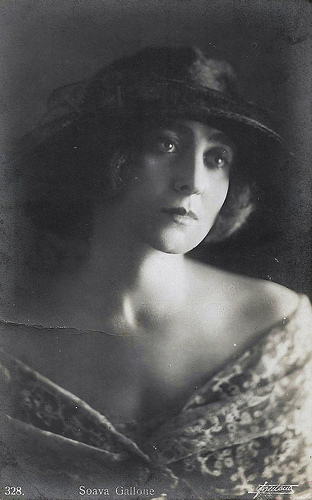
Italian postcard by Ed. A. Traldi, Milano, no. 328. Photo: Fontana.
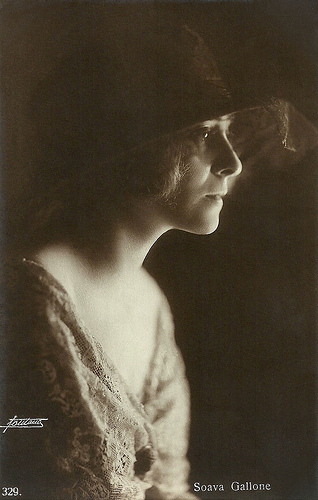
Italian postcard by Ed. A. Traldi, Milano, no. 329. Photo: Fontana, Roma.
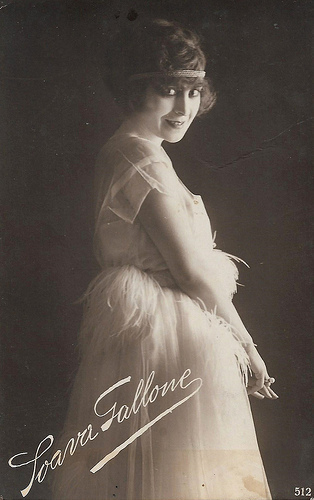
Italian postcard by Ed. A. Traldi, Milano, no. 512.
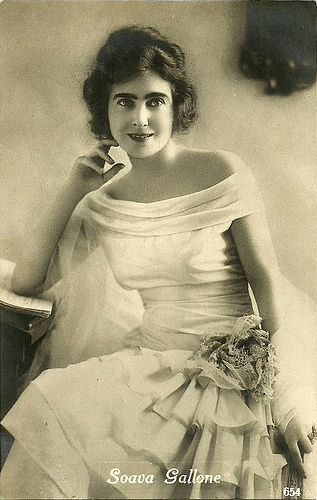
Italian postcard by Ed. A. Traldi, Milano, no. 654.
A wild girl from the woods
Soava Gallone was born Stanislawa Winawerówna in 1880 in Warsaw, Poland, then part of the Russian Empire. She left Poland for Italy, together with her mother and brother, in order to forget the bitterness of her previous marriage.
In Sorrento, Stanislawa, now known as Soave, met a young man with high hopes: Carmine Gallone. While he wrote her poems, she hoped to perform in his stage plays. The two married in 1911 and left for Rome. Their start was not a success, as Gallone’s Coriolano was not well received.
Soava was a stunning beauty but lacked correct Italian diction, so the two started to work at the Cines film company. In 1913, she appeared together with her husband in the films Il romanzo/The Romance by Nino Martoglio, and the drama I corvi/The Crows. From 1914, Carmine Callone became film director, and started to direct his wife in his films. Their first feature was the comedy Il bel gesto/The Nice Gesture (Carmine Gallone, 1914) for the Società Italiana Cines.
The couple managed to shoot a series of films, set on their beloved coast around Amalfi, Sorrento and Capri. Soava played the fiancee of a sailor, a fisherman, a coastguard, a pirate etc., all with the local scenery as asset. Cines exported these films which international critics praised for their scenic beauty. However the films didn’t become box office hits within Italy.
In 1914, Soava Gallone also started a stage career, which explains why she did not appear in many films in the years 1915 and 1916. In the theatre, she worked with the new company of the Teatro Manzoni of Milan, lead by Marco Praga.
In 1916, she finally became a big success in her own country, both critical and in audience response with Avatar/The Magician (Carmine Gallone, 1916) with André Habay , and subsequently with La chiamavano Cosetta/They Call Her Cosetta (Eugenio Perego, 1917), which was especially written for Soava by Lucio d’Ambra. A copy of La chiamavano Cosetta/They Call Her Cosetta has been traced by the film archive of Bologna, but still waits restoration.
The dramatic story of La chiamavano Cosetta is about the writer Marco ( Amleto Novelli ), deluded by his rich girlfriend, who dreams of being Pygmalion. He meets his Galatea when he sees Cosetta (Soava), a wild girl from the woods, and makes her his model, becoming a sculptor himself. Matters run out of hand when Soava falls in love with Marco, who still loves his old girlfriend, while instead Marco’s son loves Cosetta and kills himself out of love for her when she refuses him. The devastated father kills his model with the marble.
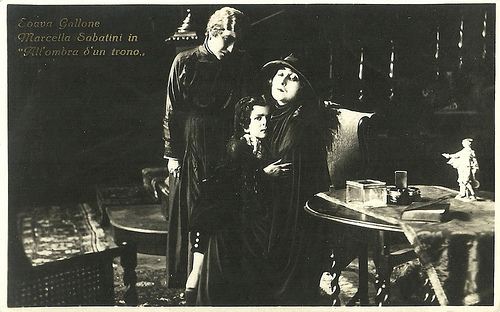
Italian postcard by G.B. Falci, Milano. Photo: Films Gallone. Publicity still of Soava Gallone and Marcella Sabbatini in All'ombra di un trono (Carmine Gallone, 1921). Other actors were Umberto Casilini and Piero Schiavazzi. The film was based on a novel by Charles Folly, Fleur d'ombre.
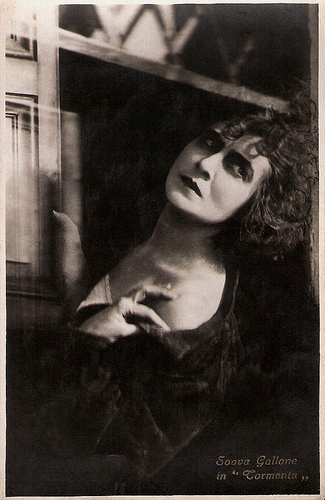
Italian postcard by G.B. Falci Editori, Milano / La Fotominio, no. 71. Photo: Soava Gallone in La Tormenta/The Storm (Carmine Gallone, 1922).
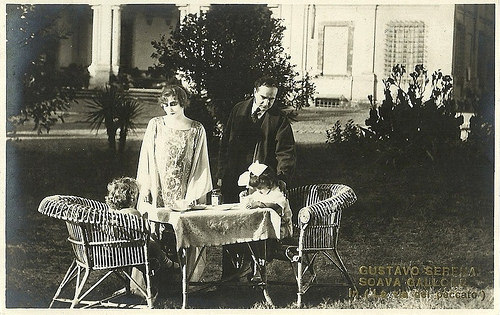
Italian postcard. Photo: A.P. Film. Publicity still of Soava Gallone and Gustavo Serena in La via del peccato/The Way of Sin (Amleto Palermi, 1925).
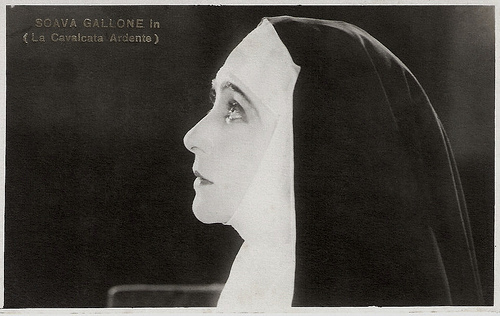
Italian Postcard by G.B. Falci Editori, Milano. Photo: still from La Cavalcata Ardente (Carmine Gallone, 1925).
Femme Fragile
Carmine Gallone had the intelligence to pick films that fully sustained the image of Soava Gallone as a refined, delicate soul. He limited her performances to no more than two per year.
Among her best films are La storia di un peccato/The story of a sin (1918), and in particular Madame Poupée/A Doll Wife (1919), based on an original script by Washington Borg. In the latter Soava plays a young mother whose happiness is destroyed by the evil scheming of a rival. The film offers a touching and delicate portrait by Gallone as 'femme fragile'.
For D'Ambra film she appeared in the drama Il bacio di Cirano/Cyrano's Kiss (Carmine Gallone, 1919), written by Lucio D'Ambra. Memorable as well are Amleto e il suo clown/On with the Motley (1920) and especially La cavalcata ardente/The Fiery Cavalcade (1925). This highly successful melodrama was set against the background of the conquest of Naples by Garibaldi's volunteers.
In La cavalcata ardente, Soava plays an aristocratic who is forced into marriage with an old prince ( Emilio Ghione ), but secretly, she is in love with a patriot ( Gabriel de Gravone ). Masked, the lover leads a cavalry to save the girl during the betrothal party (hence the arduous cavalcade of the title), which leads to the girl hiding in a convent and the lover reaching for the troupes of Garibaldi. He is arrested, however, and the girl can only save his life by accepting marriage with the old prince. For the second time she is saved, however, when Garibaldi’s troupes are before Naples, the old prince dies in the following fight, and the two lovers are finally reunited.
The crisis in the Italian cinema in the late 1920s forced Soava and Carmine Gallone to work abroad. Carmine worked in France, Germany and the United Kingdom, but Soava only played in one final silent film in France, Celle qui domine/Crossroad of Love (1927), which her husband co-directed with French director Léon Mathot , who also played the lead.
In 1930, Soava Gallone played in an early sound film, Il segreto del dottore/The Doctor's Secret (1931), directed by Jack Salvatori and shot at the Paramount Studios near Paris. It was her last film.
While her husband pursued a successful career in sound cinema, Soava Gallone remained a star from the silent era. She died in 1957 in Rome, Italy, at the age of 77.
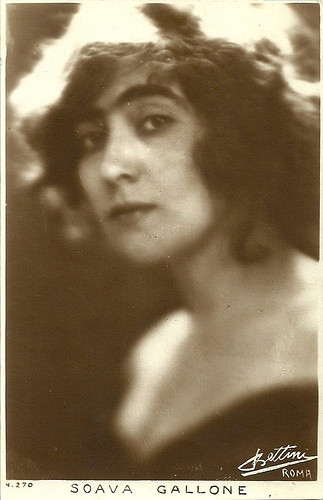
Italian postcard, no. 270. Photo Bettini, Roma.
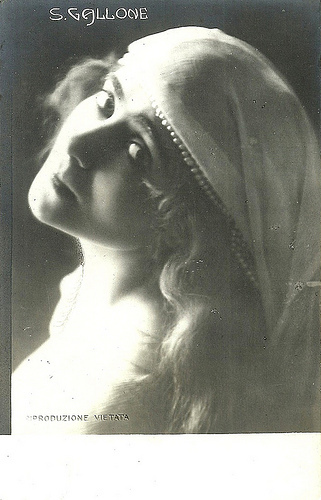
Italian postcard. Editor and photographer unknown.
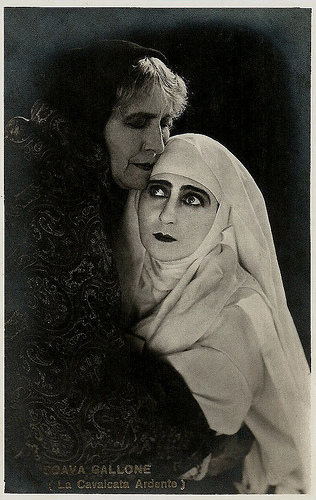
Italian postcard by G.B. Falci Editori, Milano. Photo: still from La Cavalcata Ardente/The Fiery Cavalcade (Carmine Gallone, 1925) with Jeanne Brindeau.
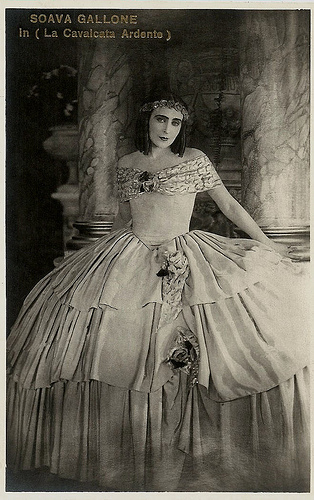
Italian postcard by G.B. Falci, Milano. Photo: publicity still for La cavalcata ardente/The Fiery Cavalcade (Carmine Gallone, 1925).
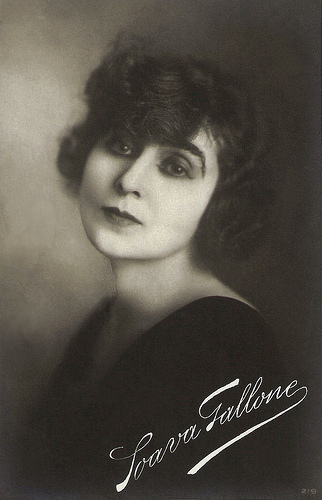
Italian postcard by Fotocelere, no. 219.
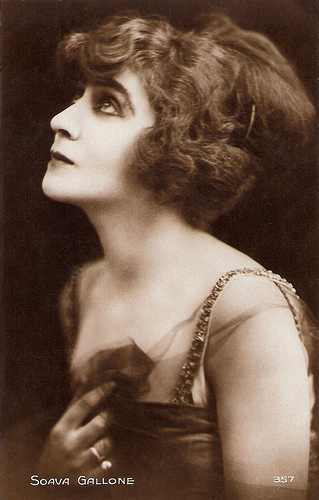
Italian postcard by Editions Cinemagazine, Paris, no. 357.
Sources: Aldo Bernardini (Cinema muto Italiano - Protagonisti - Italian), Vittorio Martinelli (Le dive del silenzio), Vittorio Martinelli (Il cinema muto italiano), Wikipedia and .

Italian postcard by Ed. A. Traldi, Milano, no. 328. Photo: Fontana.

Italian postcard by Ed. A. Traldi, Milano, no. 329. Photo: Fontana, Roma.

Italian postcard by Ed. A. Traldi, Milano, no. 512.

Italian postcard by Ed. A. Traldi, Milano, no. 654.
A wild girl from the woods
Soava Gallone was born Stanislawa Winawerówna in 1880 in Warsaw, Poland, then part of the Russian Empire. She left Poland for Italy, together with her mother and brother, in order to forget the bitterness of her previous marriage.
In Sorrento, Stanislawa, now known as Soave, met a young man with high hopes: Carmine Gallone. While he wrote her poems, she hoped to perform in his stage plays. The two married in 1911 and left for Rome. Their start was not a success, as Gallone’s Coriolano was not well received.
Soava was a stunning beauty but lacked correct Italian diction, so the two started to work at the Cines film company. In 1913, she appeared together with her husband in the films Il romanzo/The Romance by Nino Martoglio, and the drama I corvi/The Crows. From 1914, Carmine Callone became film director, and started to direct his wife in his films. Their first feature was the comedy Il bel gesto/The Nice Gesture (Carmine Gallone, 1914) for the Società Italiana Cines.
The couple managed to shoot a series of films, set on their beloved coast around Amalfi, Sorrento and Capri. Soava played the fiancee of a sailor, a fisherman, a coastguard, a pirate etc., all with the local scenery as asset. Cines exported these films which international critics praised for their scenic beauty. However the films didn’t become box office hits within Italy.
In 1914, Soava Gallone also started a stage career, which explains why she did not appear in many films in the years 1915 and 1916. In the theatre, she worked with the new company of the Teatro Manzoni of Milan, lead by Marco Praga.
In 1916, she finally became a big success in her own country, both critical and in audience response with Avatar/The Magician (Carmine Gallone, 1916) with André Habay , and subsequently with La chiamavano Cosetta/They Call Her Cosetta (Eugenio Perego, 1917), which was especially written for Soava by Lucio d’Ambra. A copy of La chiamavano Cosetta/They Call Her Cosetta has been traced by the film archive of Bologna, but still waits restoration.
The dramatic story of La chiamavano Cosetta is about the writer Marco ( Amleto Novelli ), deluded by his rich girlfriend, who dreams of being Pygmalion. He meets his Galatea when he sees Cosetta (Soava), a wild girl from the woods, and makes her his model, becoming a sculptor himself. Matters run out of hand when Soava falls in love with Marco, who still loves his old girlfriend, while instead Marco’s son loves Cosetta and kills himself out of love for her when she refuses him. The devastated father kills his model with the marble.

Italian postcard by G.B. Falci, Milano. Photo: Films Gallone. Publicity still of Soava Gallone and Marcella Sabbatini in All'ombra di un trono (Carmine Gallone, 1921). Other actors were Umberto Casilini and Piero Schiavazzi. The film was based on a novel by Charles Folly, Fleur d'ombre.

Italian postcard by G.B. Falci Editori, Milano / La Fotominio, no. 71. Photo: Soava Gallone in La Tormenta/The Storm (Carmine Gallone, 1922).

Italian postcard. Photo: A.P. Film. Publicity still of Soava Gallone and Gustavo Serena in La via del peccato/The Way of Sin (Amleto Palermi, 1925).

Italian Postcard by G.B. Falci Editori, Milano. Photo: still from La Cavalcata Ardente (Carmine Gallone, 1925).
Femme Fragile
Carmine Gallone had the intelligence to pick films that fully sustained the image of Soava Gallone as a refined, delicate soul. He limited her performances to no more than two per year.
Among her best films are La storia di un peccato/The story of a sin (1918), and in particular Madame Poupée/A Doll Wife (1919), based on an original script by Washington Borg. In the latter Soava plays a young mother whose happiness is destroyed by the evil scheming of a rival. The film offers a touching and delicate portrait by Gallone as 'femme fragile'.
For D'Ambra film she appeared in the drama Il bacio di Cirano/Cyrano's Kiss (Carmine Gallone, 1919), written by Lucio D'Ambra. Memorable as well are Amleto e il suo clown/On with the Motley (1920) and especially La cavalcata ardente/The Fiery Cavalcade (1925). This highly successful melodrama was set against the background of the conquest of Naples by Garibaldi's volunteers.
In La cavalcata ardente, Soava plays an aristocratic who is forced into marriage with an old prince ( Emilio Ghione ), but secretly, she is in love with a patriot ( Gabriel de Gravone ). Masked, the lover leads a cavalry to save the girl during the betrothal party (hence the arduous cavalcade of the title), which leads to the girl hiding in a convent and the lover reaching for the troupes of Garibaldi. He is arrested, however, and the girl can only save his life by accepting marriage with the old prince. For the second time she is saved, however, when Garibaldi’s troupes are before Naples, the old prince dies in the following fight, and the two lovers are finally reunited.
The crisis in the Italian cinema in the late 1920s forced Soava and Carmine Gallone to work abroad. Carmine worked in France, Germany and the United Kingdom, but Soava only played in one final silent film in France, Celle qui domine/Crossroad of Love (1927), which her husband co-directed with French director Léon Mathot , who also played the lead.
In 1930, Soava Gallone played in an early sound film, Il segreto del dottore/The Doctor's Secret (1931), directed by Jack Salvatori and shot at the Paramount Studios near Paris. It was her last film.
While her husband pursued a successful career in sound cinema, Soava Gallone remained a star from the silent era. She died in 1957 in Rome, Italy, at the age of 77.

Italian postcard, no. 270. Photo Bettini, Roma.

Italian postcard. Editor and photographer unknown.

Italian postcard by G.B. Falci Editori, Milano. Photo: still from La Cavalcata Ardente/The Fiery Cavalcade (Carmine Gallone, 1925) with Jeanne Brindeau.

Italian postcard by G.B. Falci, Milano. Photo: publicity still for La cavalcata ardente/The Fiery Cavalcade (Carmine Gallone, 1925).

Italian postcard by Fotocelere, no. 219.

Italian postcard by Editions Cinemagazine, Paris, no. 357.
Sources: Aldo Bernardini (Cinema muto Italiano - Protagonisti - Italian), Vittorio Martinelli (Le dive del silenzio), Vittorio Martinelli (Il cinema muto italiano), Wikipedia and .
Published on March 11, 2019 23:00
March 10, 2019
Mary Johnson
Mary Johnson (1896-1975) was an angelic Swedish actress, who peaked in the Swedish cinema of the 1910s and early 1920s and also in German silent films of the later 1920s. Her most well-known parts were in Herr Arnes pengar/Sir Arne's Treasure (1919) and Geschlecht in Fesseln/Sex in Chains (1928). After her marriage to Rudolf Klein-Rogge, she retired.

Swedish postcard by Förlag Nordisk Konst, Stockholm, no. 1055. Photo: A.B. Svenska Biografteatern, Stockholm.
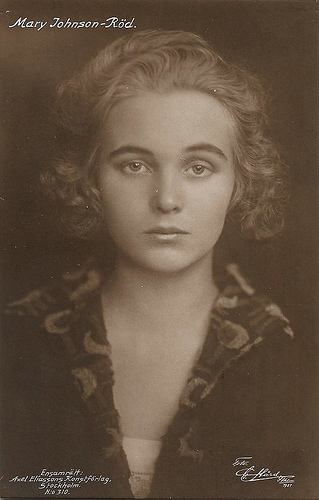
Swedish postcard by Axel Eliassons Konstförlag, Stockholm, no. 310. Photo: Gösta Hard, Stockholm, 1927. On this postcard, Johnson is indicated with the name of her second husband.
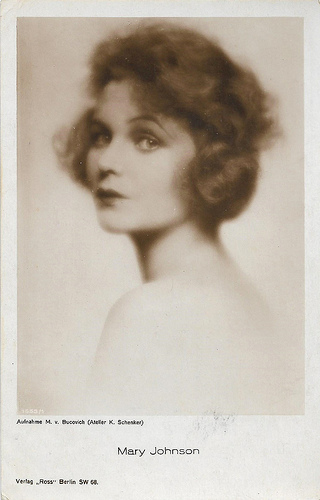
German postcard by Ross Verlag, no. 1653/1, 1927-1928. Photo: M. v. Bucovich (Atelier K. Schenker).
The theatre's prima donna
Mary Johnson was born Astrid Maria Carlsson, in 1896 in Eskilstuna, Sweden. She was born into a working-class family.
She made her first apprenticeship as an actress in Karin Swanström's company, where she made her debut in the spring of 1913 in a dramatisation of the classic novel 'Rosen pa Tistelön' (The Rose of Tistelön). However, a contemporary newspaper claims that she already joined this company in 1911. On tour, she met Karl Gerhard, then called Karl Emil Georg Johnson, who became her first husband.
Already in 1913, Gerhard and she made their film debut with small film roles in Mauritz Stiller's unfinished film Mannekängen/The Model but they were then away from the film set till 1916. In 1914, the two became involved with Hjalmar Selander at the Nya Teatern in Gothenburg, where Mary Johnson became the theatre's prima donna. She was later often associated with one of her major roles there, namely the title role in 'Dunungen' (1915), which drew the critics’ attention to her. Later, 'Dunungen' would be adapted for film with Renée Björling in the lead.
During this time, Johnson was engaged by the Gothenburg based company Hasselblads Fotografiska AB, and she acted in a string of 12 films all but one directed by Georg af Klercker: e.g. Ministerpresidenten/The Prime Minister (1916), Nattens barn/Child of the Night (1916) in which she had the lead, the censorship-forbidden Mysteriet natten till den 25:e/The Mystery of the Night of the 25th (1917), Mellan liv och död/Between Life and Death (1917), and Fyrvaktarens dotter/The Four Guardian's Daughter (1918), and Förstadsprästen/The Suburban Vicar (1917). Fyrvaktarens dotter/The Daughter of the Lighthouse Keeper (1918) was Hasselblad’s last film before it merged with the new company Skandia.
In addition, until 1917 Johnson toured with Skådebanan, a theatre company founded 1910, and set on popular education. She appeared in the season of 1917-1918 at its new fixed stage at Folkets Hus theatre in Stockholm. Karl Gerhard then broke with Skådebanan and started with his own tour activity in 1918 and 1919, where Mary Johnson and Richard Lund became his stars. In 1920 Johnson played at Folkteatern in Gothenburg.
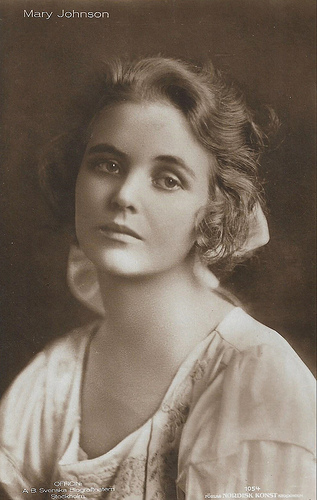
Swedish postcard by Förlag Nordisk Konst, Stockholm, no. 1054. Photo: A.B. Svenska Biografteatern.

Swedish postcard by Nordisk Konst, Stockholm, no. 1078/12. Richard Lund and Mary Johnson in the Swedish silent film Herr Arnes pengar/Sir Arne's Treasure (Mauritz Stiller, 1919). Caption: They have come now to arrest you, escape!
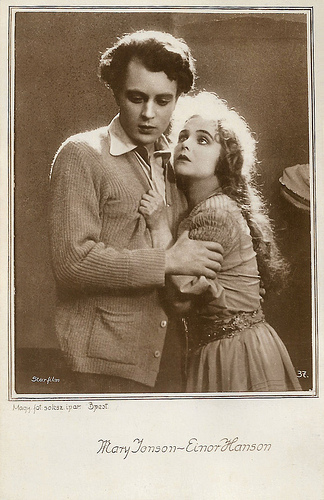
Hungarian postcard by Magy. fot. soksz ipar., Budapest, no. 37. Photo: Star-film. Publicity still for Gunnar Hedes saga/Snowbound (Mauritz Stiller, 1923) with Einar Hanson .
A more versatile actress
After Hasselblad's merger with Skandia in 1918, Mary Johnson came over to this company and had a big breakthrough with the film Mästerkatten/Puss in Boots (John W. Brunius, 1918) and when that company in its turn in 1919 formed Svensk Filmindustri, Mary got her perhaps most famous Swedish film role as Elsalill in the rural drama Herr Arnes pengar/Sir Arne’s Treasure (1919).
Mary played the young girl, whose whole family is murdered by three treasure hunting Scottish officers. She is torn between justice and her love for the leader of the gang, Sir Archi (Richard Lund). The international success of Herr Arnes pengar resulted in films such as En lyckoriddare/A Happy Knight (John W. Brunius, 1921), with a dashing Gösta Ekman opposite an ethereal Johnson.
At about the same time Johnson divorced Gerhard Johnson and married the Norwegian actor Einar Rød and started to work in Norway as an actress, where a.o. she did a tour in 1922 and acted at the Chat Noir in Oslo in 1922-1923. In 1923 she shortly worked for Svenska Biografteatern, acting in Gunnar Hedes saga/Snowbound (Mauritz Stiller, 1923), adapted from Selma Lagerlöf’s novel, and starring Einar Hanson as the title character, and in Johan Ulfstjerna (John W. Brunius, 1923), starring Einar Hanson and Ivan Hedqvist.
In 1924 she moved to Germany, where she worked in films in the later 1920s. Her first film in Germany was Hanns Schwarz's Die Stimme des Herzens/The Voice of the Heart (1924), in which also her second husband, the Norwegian actor Einar Röd, appeared. When the film’s production company, Trianon, collapsed, she moved over to Rex Film, which gave her a big role as Werner Krauss ’ character’s daughter in Das Haus der Lüge/The House of Lies (Lupu Pick 1926), based on Henrik Ibsen’s play The Wild Duck.
This also meant her abandon of the ingenue type, developing into a more versatile actress, able to play both in tragedy and comedy. In Das Haus der Lüge, she became an excellent interpreter of the shy and weak as the protagonist who eventually becomes a victim. Filming in Germany also meant that Johnson became one of the Swedish films' first international stars. In Germany, she eventually met her third man, actor Rudolf Klein-Rogge . They married in 1932.
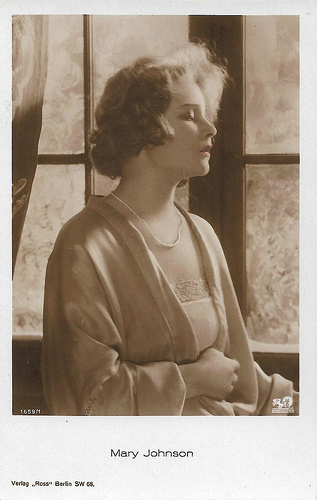
German postcard by Ross Verlag, no. 1659/1, 1927-1928. Photo: Phoebus Film.
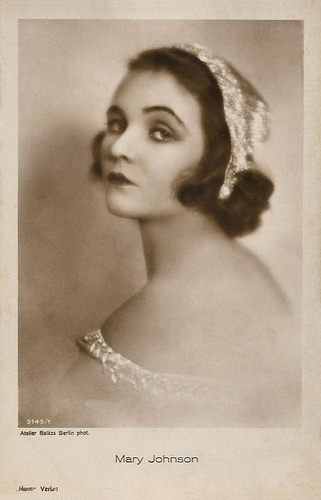
German postcard by Ross Verlag, no. 3145/1, 1928-1929. Photo: Atelier Balàzs, Berlin.
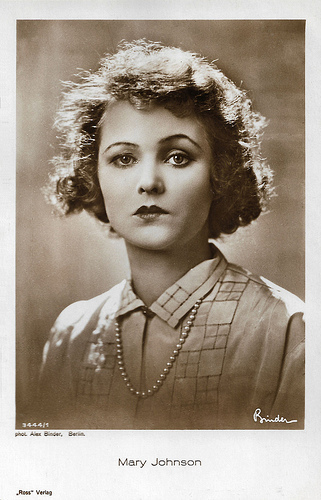
German postcard by Ross Verlag, no. 3444/1, 1928-1929. Photo: Alex Binder, Berlin.
Sex in chains
In Germany, Mary Johnson played supporting parts in films with Paul Richter , Paul Wegener , and Marcella Albani . She also starred in leading roles in Staatsanwalt Jordan/State Attorney Jordan (Joe May, 1926) with Hans Mierendorff , in Manege/Life's Circus (Max Reichmann, 1927/1928), with Ernst von Düren, and in two films by the Munich director Franz Osten: Was Kinder den Eltern verschweigen/What Children Conceal From Their Parents (1927), a film banned in several European countries, and Die raffinierteste Frau Berlins/The most refined woman of Berlin (1927), with Luigi Serventi and André Mattoni .
Johnson’s most well-known film in the late 1920s was William Dieterle 's Geschlecht in Fesseln/Sex in Chains (1928), in which she played the female lead opposite Dieterle. While her husband is in jail, sentenced for manslaughter, and is being seduced by an inmate, she herself has an affair with a former inmate of her man, who gets her a job. When the husband is finally released, man and woman feel guilty and commit suicide.
After a relatively diligent film career during the 1920s, Johnson disappeared from the film sets after one bit part in 1931, while Rudolf Klein-Rogge continued to act all through the 1930s. The Second World War hit the two spouses very hard and they lost virtually all their assets besides a summer place outside Graz in Austria, where they settled after the end of the war. Klein-Rogge died there in 1955.
Mary Johnson spent her last few years in utmost oblivion and she died in Stockholm. She seems to have been very shy of publicity and there is very little written about her. Johnson has been regarded as one of the Swedish film's most beautiful actresses and was similar in many places to a crisp and beautiful porcelain doll. When she broke through in 'Dunungen', one critic meant that by being small and thin, blond and blue-eyed, she fulfilled the demands of being a real kid. Her first man, Karl Gerhard, described her as angelic and shy and said she instantly awakened his instincts of protection.
Zarah Leander described Johnson in her memoirs as ethereal and angelic. There was also something androgynous about her appearance and it was claimed that she received as much admiration from female as from male spectators. Mary Johnson died on 7 (or perhaps 15) May 1975 in Hägersten, Stockholm, or according to others in Brännkyrka, Sweden. She was 78.
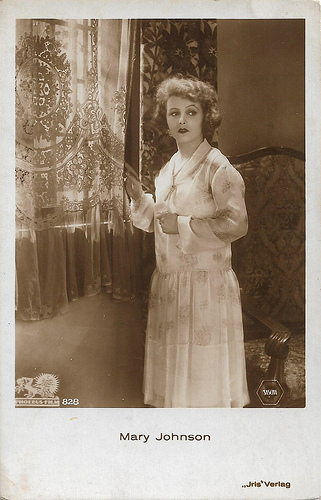
Austrian postcard by Iris Verlag, no. 828. Photo: Sascha Film / Phoebus Film.
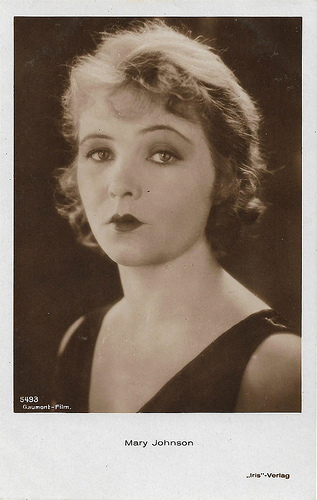
Austrian postcard by Iris-Verlag, no. 5493. Photo: Gaumont-Film.
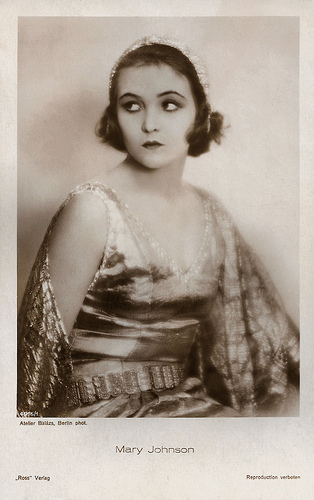
German postcard by Ross Verlag, no. 4916/1, 1929-1930. Photo: Atelier Balàzs, Berlin.
Sources: This biography is largely based on the one written by P.O. Qvist (2004) on the Swedish Film Database, Svenskfilmdatabas. Additional information came from and Swedish Wikipedia.

Swedish postcard by Förlag Nordisk Konst, Stockholm, no. 1055. Photo: A.B. Svenska Biografteatern, Stockholm.

Swedish postcard by Axel Eliassons Konstförlag, Stockholm, no. 310. Photo: Gösta Hard, Stockholm, 1927. On this postcard, Johnson is indicated with the name of her second husband.

German postcard by Ross Verlag, no. 1653/1, 1927-1928. Photo: M. v. Bucovich (Atelier K. Schenker).
The theatre's prima donna
Mary Johnson was born Astrid Maria Carlsson, in 1896 in Eskilstuna, Sweden. She was born into a working-class family.
She made her first apprenticeship as an actress in Karin Swanström's company, where she made her debut in the spring of 1913 in a dramatisation of the classic novel 'Rosen pa Tistelön' (The Rose of Tistelön). However, a contemporary newspaper claims that she already joined this company in 1911. On tour, she met Karl Gerhard, then called Karl Emil Georg Johnson, who became her first husband.
Already in 1913, Gerhard and she made their film debut with small film roles in Mauritz Stiller's unfinished film Mannekängen/The Model but they were then away from the film set till 1916. In 1914, the two became involved with Hjalmar Selander at the Nya Teatern in Gothenburg, where Mary Johnson became the theatre's prima donna. She was later often associated with one of her major roles there, namely the title role in 'Dunungen' (1915), which drew the critics’ attention to her. Later, 'Dunungen' would be adapted for film with Renée Björling in the lead.
During this time, Johnson was engaged by the Gothenburg based company Hasselblads Fotografiska AB, and she acted in a string of 12 films all but one directed by Georg af Klercker: e.g. Ministerpresidenten/The Prime Minister (1916), Nattens barn/Child of the Night (1916) in which she had the lead, the censorship-forbidden Mysteriet natten till den 25:e/The Mystery of the Night of the 25th (1917), Mellan liv och död/Between Life and Death (1917), and Fyrvaktarens dotter/The Four Guardian's Daughter (1918), and Förstadsprästen/The Suburban Vicar (1917). Fyrvaktarens dotter/The Daughter of the Lighthouse Keeper (1918) was Hasselblad’s last film before it merged with the new company Skandia.
In addition, until 1917 Johnson toured with Skådebanan, a theatre company founded 1910, and set on popular education. She appeared in the season of 1917-1918 at its new fixed stage at Folkets Hus theatre in Stockholm. Karl Gerhard then broke with Skådebanan and started with his own tour activity in 1918 and 1919, where Mary Johnson and Richard Lund became his stars. In 1920 Johnson played at Folkteatern in Gothenburg.

Swedish postcard by Förlag Nordisk Konst, Stockholm, no. 1054. Photo: A.B. Svenska Biografteatern.

Swedish postcard by Nordisk Konst, Stockholm, no. 1078/12. Richard Lund and Mary Johnson in the Swedish silent film Herr Arnes pengar/Sir Arne's Treasure (Mauritz Stiller, 1919). Caption: They have come now to arrest you, escape!

Hungarian postcard by Magy. fot. soksz ipar., Budapest, no. 37. Photo: Star-film. Publicity still for Gunnar Hedes saga/Snowbound (Mauritz Stiller, 1923) with Einar Hanson .
A more versatile actress
After Hasselblad's merger with Skandia in 1918, Mary Johnson came over to this company and had a big breakthrough with the film Mästerkatten/Puss in Boots (John W. Brunius, 1918) and when that company in its turn in 1919 formed Svensk Filmindustri, Mary got her perhaps most famous Swedish film role as Elsalill in the rural drama Herr Arnes pengar/Sir Arne’s Treasure (1919).
Mary played the young girl, whose whole family is murdered by three treasure hunting Scottish officers. She is torn between justice and her love for the leader of the gang, Sir Archi (Richard Lund). The international success of Herr Arnes pengar resulted in films such as En lyckoriddare/A Happy Knight (John W. Brunius, 1921), with a dashing Gösta Ekman opposite an ethereal Johnson.
At about the same time Johnson divorced Gerhard Johnson and married the Norwegian actor Einar Rød and started to work in Norway as an actress, where a.o. she did a tour in 1922 and acted at the Chat Noir in Oslo in 1922-1923. In 1923 she shortly worked for Svenska Biografteatern, acting in Gunnar Hedes saga/Snowbound (Mauritz Stiller, 1923), adapted from Selma Lagerlöf’s novel, and starring Einar Hanson as the title character, and in Johan Ulfstjerna (John W. Brunius, 1923), starring Einar Hanson and Ivan Hedqvist.
In 1924 she moved to Germany, where she worked in films in the later 1920s. Her first film in Germany was Hanns Schwarz's Die Stimme des Herzens/The Voice of the Heart (1924), in which also her second husband, the Norwegian actor Einar Röd, appeared. When the film’s production company, Trianon, collapsed, she moved over to Rex Film, which gave her a big role as Werner Krauss ’ character’s daughter in Das Haus der Lüge/The House of Lies (Lupu Pick 1926), based on Henrik Ibsen’s play The Wild Duck.
This also meant her abandon of the ingenue type, developing into a more versatile actress, able to play both in tragedy and comedy. In Das Haus der Lüge, she became an excellent interpreter of the shy and weak as the protagonist who eventually becomes a victim. Filming in Germany also meant that Johnson became one of the Swedish films' first international stars. In Germany, she eventually met her third man, actor Rudolf Klein-Rogge . They married in 1932.

German postcard by Ross Verlag, no. 1659/1, 1927-1928. Photo: Phoebus Film.

German postcard by Ross Verlag, no. 3145/1, 1928-1929. Photo: Atelier Balàzs, Berlin.

German postcard by Ross Verlag, no. 3444/1, 1928-1929. Photo: Alex Binder, Berlin.
Sex in chains
In Germany, Mary Johnson played supporting parts in films with Paul Richter , Paul Wegener , and Marcella Albani . She also starred in leading roles in Staatsanwalt Jordan/State Attorney Jordan (Joe May, 1926) with Hans Mierendorff , in Manege/Life's Circus (Max Reichmann, 1927/1928), with Ernst von Düren, and in two films by the Munich director Franz Osten: Was Kinder den Eltern verschweigen/What Children Conceal From Their Parents (1927), a film banned in several European countries, and Die raffinierteste Frau Berlins/The most refined woman of Berlin (1927), with Luigi Serventi and André Mattoni .
Johnson’s most well-known film in the late 1920s was William Dieterle 's Geschlecht in Fesseln/Sex in Chains (1928), in which she played the female lead opposite Dieterle. While her husband is in jail, sentenced for manslaughter, and is being seduced by an inmate, she herself has an affair with a former inmate of her man, who gets her a job. When the husband is finally released, man and woman feel guilty and commit suicide.
After a relatively diligent film career during the 1920s, Johnson disappeared from the film sets after one bit part in 1931, while Rudolf Klein-Rogge continued to act all through the 1930s. The Second World War hit the two spouses very hard and they lost virtually all their assets besides a summer place outside Graz in Austria, where they settled after the end of the war. Klein-Rogge died there in 1955.
Mary Johnson spent her last few years in utmost oblivion and she died in Stockholm. She seems to have been very shy of publicity and there is very little written about her. Johnson has been regarded as one of the Swedish film's most beautiful actresses and was similar in many places to a crisp and beautiful porcelain doll. When she broke through in 'Dunungen', one critic meant that by being small and thin, blond and blue-eyed, she fulfilled the demands of being a real kid. Her first man, Karl Gerhard, described her as angelic and shy and said she instantly awakened his instincts of protection.
Zarah Leander described Johnson in her memoirs as ethereal and angelic. There was also something androgynous about her appearance and it was claimed that she received as much admiration from female as from male spectators. Mary Johnson died on 7 (or perhaps 15) May 1975 in Hägersten, Stockholm, or according to others in Brännkyrka, Sweden. She was 78.

Austrian postcard by Iris Verlag, no. 828. Photo: Sascha Film / Phoebus Film.

Austrian postcard by Iris-Verlag, no. 5493. Photo: Gaumont-Film.

German postcard by Ross Verlag, no. 4916/1, 1929-1930. Photo: Atelier Balàzs, Berlin.
Sources: This biography is largely based on the one written by P.O. Qvist (2004) on the Swedish Film Database, Svenskfilmdatabas. Additional information came from and Swedish Wikipedia.
Published on March 10, 2019 23:00
March 9, 2019
Danny Kaye
Danny Kaye (1911-1987) was an American actor, singer, dancer, comedian and musician. His performances featured physical comedy, idiosyncratic pantomimes and tongue-twisting songs. Kaye starred in 17 films like Wonder Man (1945), The Secret Life of Walter Mitty (1947), and White Christmas (1954).
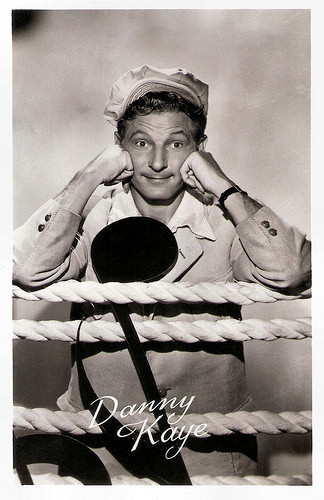
Dutch postcard, no. 3166. Photo: publicity still for The Kid from Brooklyn (Norman Z. McLeod, 1946).
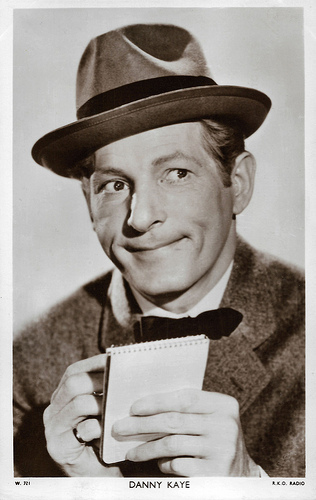
British postcard in the Picturegoer Series, London, no. W 721. Photo: RKO Radio. Publicity still for A Song Is Born (Howard Hawks, 1948).
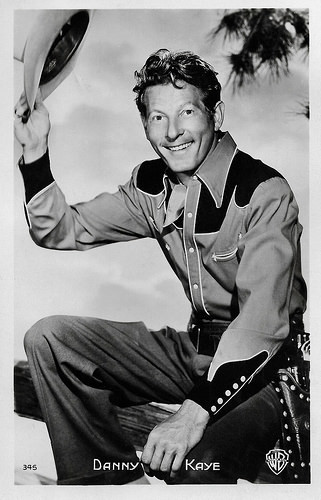
French postcard by Editions P.I., Paris, no. 345. Photo: Warner Bros.
Singing the names of Russian composers at breakneck speed
Danny Kaye was born David Daniel Kaminsky in 1911 in Brooklyn, New York. He was the youngest of three sons of Ukrainian Jewish immigrants Jacob and Clara (née Nemerovsky) Kaminsky. Kaye always publicly claimed that he was born in 1913. After his death, daughter Dena revealed that her father's birth certificate indicates that he was born in 1911, and that no one in the family knows why he made this alteration to his age.
At school, Danny began entertaining his classmates with songs and jokes. His mother died when he was in his early teens. Not long after his mother's death, the 13-years-old Kaye and his friend Louis ran away to Florida. Danny sang while Louis played the guitar and the pair eked out a living for a while. Later, after a series of odd jobs, he worked as an entertainer in the so-called Borscht Belt of Jewish resorts in the Catskill Mountains. It was there he learned the basics of show biz.
Kaye's first break came in 1933 when he joined the Three Terpsichoreans, a vaudeville dance act. They opened in Utica, New York, where he used the name Danny Kaye for the first time. The act toured the United States, then performed in Asia with the show La Vie Paree.
In 1935, Danny Kaye made his film debut in the comedy short Moon Over Manhattan (Al Christie, 1935). In 1937 he signed with New York–based Educational Pictures for a series of two-reel comedies. He usually played a manic, dark-haired, fast-talking Russian in these low-budget shorts, opposite young hopefuls June Allyson and Imogene Coca. The Kaye series ended abruptly when the studio shut down in 1938.
In 1939, he made his Broadway debut in Straw Hat Revue, a short-lived Broadway show with Sylvia Fine as the pianist, lyricist, and composer. Sylvia discovered that Danny once had worked for her father Samuel Fine, a dentist. In 1940, he married Sylvia Fine, who went on to manage his career. The reviews for the show brought an offer for both Kaye and his bride to work at La Martinique, a New York City nightclub. Kaye performed there with Sylvia as his accompanist.
At La Martinique playwright Moss Hart saw Danny perform, and that led to Harts casting him as Russell Paxton in the hit Broadway comedy Lady in the Dark (1941), starring Gertrude Lawrence. At age 30, Kaye scored a triumph. His show-stopping number was 'Tchaikovsky' by Kurt Weill and Ira Gershwin in which he sang the names of a string of Russian composers at breakneck speed, seemingly without taking a breath. In the next Broadway season he was the star of a show about a young man who is drafted called Let's Face It!
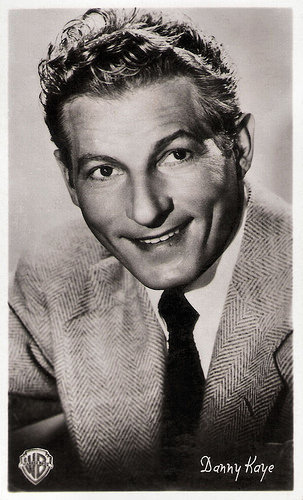
Belgian collectors card by Fotoprim offered b De Beukelaer, Antwerp, no. A 21. Photo: Warner Bros.
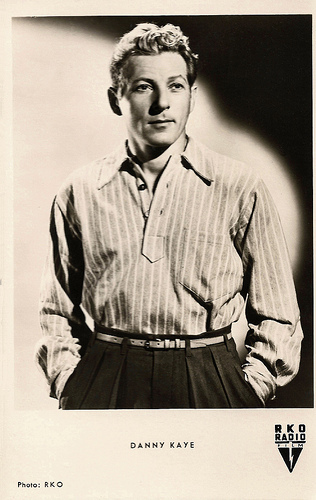
German postcard by Kunst und Bild, no. A 444. Photo: RKO Radio Film. Publicity still for The Secret Life of Walter Mitty (Norman Z. MacLeod, 1947).
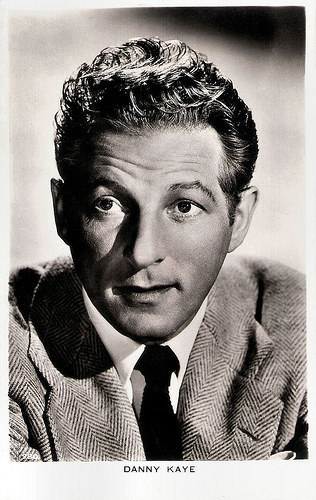
British Real Photograph postcard, no. 280.
A pair of estranged twins
Producer Samuel Goldwyn put Danny Kaye in a series of Technicolor musicals. Goldwyn had asked him to get his nose fixed so it would look less Jewish, but Kaye refused. His feature-film debut was in the Technicolor comedy Up in Arms (Elliott Nugent, 1944) with Dinah Shore. It was a remake of Goldwyn's comedy Whoopee! (Thornton Freeland, 1930) with Eddie Cantor. Up in Arms was nominated for two Academy Awards in 1945.
With Up in Arms, Kaye had become an international success and rival producer Robert M. Savini cashed in with the patchwork feature The Birth of a Star (William Watson, 1945). He had edited the compilation from three of Kaye's Educational Pictures shorts, Dime a Dance (Al Christie, 1937), Getting an Eyeful (William Watson, 1938) and Cupid Takes a Holiday (William Watson, 1938).
In 1945–1946, Kaye starred in a radio program, The Danny Kaye Show, on CBS. The program's popularity rose quickly. Before a year he tied with Jimmy Durante for fifth place in the Radio Daily popularity poll.
He went on to do four more pictures in succession with Sam Goldwyn before moving on to Warner Brothers, 20th Century-Fox and Paramount. For Goldwyn, Kaye played a pair of estranged twins with very similar looks, but very different personalities in the musical Wonder Man (H. Bruce Humberstone, 1945). Then he appeared as a milkman who becomes world boxing champion in The Kid from Brooklyn (Norman Z. McLeod, 1946). In both films Virginia Mayo was his love interest.
In the popular hit The Secret Life of Walter Mitty (Norman Z. McLeod, 1947), he played a young daydreaming proof reader (later associate editor) for a magazine publishing firm and Virginia Mayo as the girl of his dreams. Kaye and Mayo co-starred for the fourth and last time for Goldwyn in the Technicolor musical A Song Is Born (Howard Hawks, 1948), with famous musicians as Benny Goodman, Tommy Dorsey, Louis Armstrong , Lionel Hampton and Charlie Barnet playing themselves.
Another success was the Technicolor musical comedy The Inspector General (Henry Koster, 1949) in which Danny Kaye starred opposite Walter Slezak . The film is loosely based on Nikolai Gogol's play The Inspector General, but the plot is re-located from the Russian Empire into an unspecified corrupted region of a country that suddenly finds itself under the supervision of the First French Empire.
Kaye was a liberal Democrat who opposed the Hollywood blacklist. In 1953 Kaye started a production company, Dena Pictures, named for his daughter. The comedy Knock on Wood (Melvin Frank, Norman Panama, 1954), with Mai Zetterling , was the first film produced by his firm. The firm expanded into television in 1960 under the name Belmont Television.
In total, Kaye starred in 17 films, including the biopic Hans Christian Andersen (Charles Vidor, 1952) with Farley Granger , White Christmas (Michael Curtiz, 1954) with Bing Crosby, and The Court Jester (Melvin Frank, Norman Panama, 1956) with Glynis Johns . Kaye received a Golden Globe nomination for his role, but the costly The Court Jester bombed at the box office. His final starring role in a film was in The Man from the Diners' Club (Frank Tashlin, 1963).
On TV, he appeared in The Danny Kaye Show (1963–1967). The show won four Emmy awards and a Peabody award. In 1976 he played Mister Geppetto in a television musical adaptation of Pinocchio (Ron Field, Sid Smith, 1976) with Sandy Duncan in the title role. Kaye portrayed Captain Hook opposite Mia Farrow in a musical version of Peter Pan (Dwight Hemion, 1976).
He later guest-starred in episodes of The Muppet Show (1978), the revival of Twilight Zone (1985) and The Cosby Show (1986). He played one of his few dramatic roles in Skokie (Herbert Wise, 1981), as a Holocaust survivor protesting a planned march by Neo-Nazis in the predominately Jewish community of Skokie.
He showed his serious side as ambassador for UNICEF. In 1954, Kaye became the first ambassador-at-large of UNICEF and in 1986, he received the French Legion of Honour for his years of work with the organisation. Before his death in 1987, Kaye conducted an orchestra during a comical series of concerts organised for UNICEF fundraising.
Danny Kaye died of heart failure in 1987, brought on by internal bleeding and complications of hepatitis C. In 1983, Kaye had had quadruple bypass heart surgery and had contracted hepatitis C from a blood transfusion. Kaye was 76. His only child was daughter Dena, born in 1946.
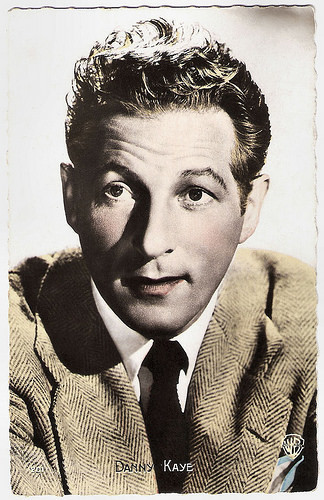
French postcard by Editions P.I., Paris, no. 201. Photo: Warner Bros.
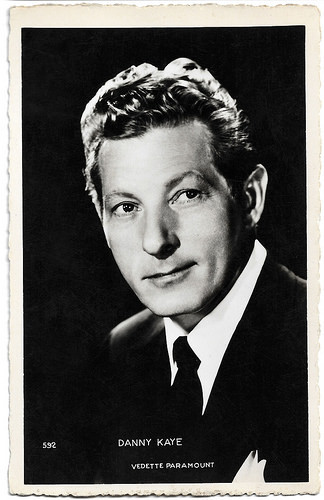
French postcard by Edit. P.I., Paris, no. 592 Photo: Paramount, 1954.
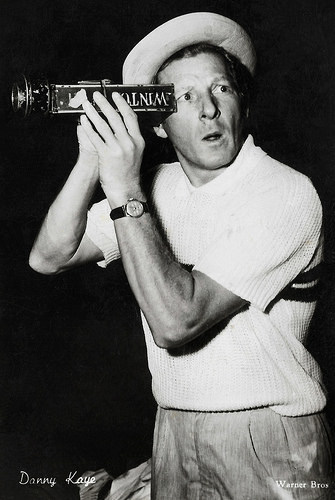
Dutch card. Photo: Warner Bros.
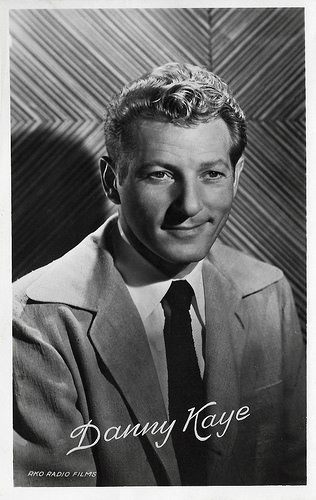
Dutch postcard by Uitg. Takken, Utrecht, no. 3232. Photo: RKO Radio Films.
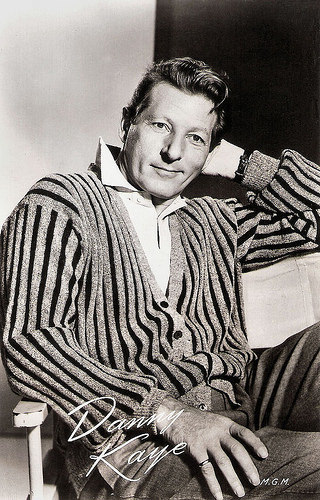
Dutch postcard by Uitg. Takken, Utrecht, no. AX 3869. Photo: M.G.M. Publicity still for Merry Andrew (Michael Kidd, 1958).
Sources: (IMDb), Wikipedia and .

Dutch postcard, no. 3166. Photo: publicity still for The Kid from Brooklyn (Norman Z. McLeod, 1946).

British postcard in the Picturegoer Series, London, no. W 721. Photo: RKO Radio. Publicity still for A Song Is Born (Howard Hawks, 1948).

French postcard by Editions P.I., Paris, no. 345. Photo: Warner Bros.
Singing the names of Russian composers at breakneck speed
Danny Kaye was born David Daniel Kaminsky in 1911 in Brooklyn, New York. He was the youngest of three sons of Ukrainian Jewish immigrants Jacob and Clara (née Nemerovsky) Kaminsky. Kaye always publicly claimed that he was born in 1913. After his death, daughter Dena revealed that her father's birth certificate indicates that he was born in 1911, and that no one in the family knows why he made this alteration to his age.
At school, Danny began entertaining his classmates with songs and jokes. His mother died when he was in his early teens. Not long after his mother's death, the 13-years-old Kaye and his friend Louis ran away to Florida. Danny sang while Louis played the guitar and the pair eked out a living for a while. Later, after a series of odd jobs, he worked as an entertainer in the so-called Borscht Belt of Jewish resorts in the Catskill Mountains. It was there he learned the basics of show biz.
Kaye's first break came in 1933 when he joined the Three Terpsichoreans, a vaudeville dance act. They opened in Utica, New York, where he used the name Danny Kaye for the first time. The act toured the United States, then performed in Asia with the show La Vie Paree.
In 1935, Danny Kaye made his film debut in the comedy short Moon Over Manhattan (Al Christie, 1935). In 1937 he signed with New York–based Educational Pictures for a series of two-reel comedies. He usually played a manic, dark-haired, fast-talking Russian in these low-budget shorts, opposite young hopefuls June Allyson and Imogene Coca. The Kaye series ended abruptly when the studio shut down in 1938.
In 1939, he made his Broadway debut in Straw Hat Revue, a short-lived Broadway show with Sylvia Fine as the pianist, lyricist, and composer. Sylvia discovered that Danny once had worked for her father Samuel Fine, a dentist. In 1940, he married Sylvia Fine, who went on to manage his career. The reviews for the show brought an offer for both Kaye and his bride to work at La Martinique, a New York City nightclub. Kaye performed there with Sylvia as his accompanist.
At La Martinique playwright Moss Hart saw Danny perform, and that led to Harts casting him as Russell Paxton in the hit Broadway comedy Lady in the Dark (1941), starring Gertrude Lawrence. At age 30, Kaye scored a triumph. His show-stopping number was 'Tchaikovsky' by Kurt Weill and Ira Gershwin in which he sang the names of a string of Russian composers at breakneck speed, seemingly without taking a breath. In the next Broadway season he was the star of a show about a young man who is drafted called Let's Face It!

Belgian collectors card by Fotoprim offered b De Beukelaer, Antwerp, no. A 21. Photo: Warner Bros.

German postcard by Kunst und Bild, no. A 444. Photo: RKO Radio Film. Publicity still for The Secret Life of Walter Mitty (Norman Z. MacLeod, 1947).

British Real Photograph postcard, no. 280.
A pair of estranged twins
Producer Samuel Goldwyn put Danny Kaye in a series of Technicolor musicals. Goldwyn had asked him to get his nose fixed so it would look less Jewish, but Kaye refused. His feature-film debut was in the Technicolor comedy Up in Arms (Elliott Nugent, 1944) with Dinah Shore. It was a remake of Goldwyn's comedy Whoopee! (Thornton Freeland, 1930) with Eddie Cantor. Up in Arms was nominated for two Academy Awards in 1945.
With Up in Arms, Kaye had become an international success and rival producer Robert M. Savini cashed in with the patchwork feature The Birth of a Star (William Watson, 1945). He had edited the compilation from three of Kaye's Educational Pictures shorts, Dime a Dance (Al Christie, 1937), Getting an Eyeful (William Watson, 1938) and Cupid Takes a Holiday (William Watson, 1938).
In 1945–1946, Kaye starred in a radio program, The Danny Kaye Show, on CBS. The program's popularity rose quickly. Before a year he tied with Jimmy Durante for fifth place in the Radio Daily popularity poll.
He went on to do four more pictures in succession with Sam Goldwyn before moving on to Warner Brothers, 20th Century-Fox and Paramount. For Goldwyn, Kaye played a pair of estranged twins with very similar looks, but very different personalities in the musical Wonder Man (H. Bruce Humberstone, 1945). Then he appeared as a milkman who becomes world boxing champion in The Kid from Brooklyn (Norman Z. McLeod, 1946). In both films Virginia Mayo was his love interest.
In the popular hit The Secret Life of Walter Mitty (Norman Z. McLeod, 1947), he played a young daydreaming proof reader (later associate editor) for a magazine publishing firm and Virginia Mayo as the girl of his dreams. Kaye and Mayo co-starred for the fourth and last time for Goldwyn in the Technicolor musical A Song Is Born (Howard Hawks, 1948), with famous musicians as Benny Goodman, Tommy Dorsey, Louis Armstrong , Lionel Hampton and Charlie Barnet playing themselves.
Another success was the Technicolor musical comedy The Inspector General (Henry Koster, 1949) in which Danny Kaye starred opposite Walter Slezak . The film is loosely based on Nikolai Gogol's play The Inspector General, but the plot is re-located from the Russian Empire into an unspecified corrupted region of a country that suddenly finds itself under the supervision of the First French Empire.
Kaye was a liberal Democrat who opposed the Hollywood blacklist. In 1953 Kaye started a production company, Dena Pictures, named for his daughter. The comedy Knock on Wood (Melvin Frank, Norman Panama, 1954), with Mai Zetterling , was the first film produced by his firm. The firm expanded into television in 1960 under the name Belmont Television.
In total, Kaye starred in 17 films, including the biopic Hans Christian Andersen (Charles Vidor, 1952) with Farley Granger , White Christmas (Michael Curtiz, 1954) with Bing Crosby, and The Court Jester (Melvin Frank, Norman Panama, 1956) with Glynis Johns . Kaye received a Golden Globe nomination for his role, but the costly The Court Jester bombed at the box office. His final starring role in a film was in The Man from the Diners' Club (Frank Tashlin, 1963).
On TV, he appeared in The Danny Kaye Show (1963–1967). The show won four Emmy awards and a Peabody award. In 1976 he played Mister Geppetto in a television musical adaptation of Pinocchio (Ron Field, Sid Smith, 1976) with Sandy Duncan in the title role. Kaye portrayed Captain Hook opposite Mia Farrow in a musical version of Peter Pan (Dwight Hemion, 1976).
He later guest-starred in episodes of The Muppet Show (1978), the revival of Twilight Zone (1985) and The Cosby Show (1986). He played one of his few dramatic roles in Skokie (Herbert Wise, 1981), as a Holocaust survivor protesting a planned march by Neo-Nazis in the predominately Jewish community of Skokie.
He showed his serious side as ambassador for UNICEF. In 1954, Kaye became the first ambassador-at-large of UNICEF and in 1986, he received the French Legion of Honour for his years of work with the organisation. Before his death in 1987, Kaye conducted an orchestra during a comical series of concerts organised for UNICEF fundraising.
Danny Kaye died of heart failure in 1987, brought on by internal bleeding and complications of hepatitis C. In 1983, Kaye had had quadruple bypass heart surgery and had contracted hepatitis C from a blood transfusion. Kaye was 76. His only child was daughter Dena, born in 1946.

French postcard by Editions P.I., Paris, no. 201. Photo: Warner Bros.

French postcard by Edit. P.I., Paris, no. 592 Photo: Paramount, 1954.

Dutch card. Photo: Warner Bros.

Dutch postcard by Uitg. Takken, Utrecht, no. 3232. Photo: RKO Radio Films.

Dutch postcard by Uitg. Takken, Utrecht, no. AX 3869. Photo: M.G.M. Publicity still for Merry Andrew (Michael Kidd, 1958).
Sources: (IMDb), Wikipedia and .
Published on March 09, 2019 22:00
March 8, 2019
Photo by Nordisk
Nordisk Films Kompagni or Nordisk Film is a Danish film company, established in 1906 by filmmaker Ole Olsen. It is the fourth oldest film studio in the world behind the Gaumont Film Company, Pathé, and Titanus, but the oldest continuously active. Olsen started his company in the Copenhagen suburb of Valby under the name Ole Olsen's Film Factory but soon changed it to the Nordisk Film Kompagni.
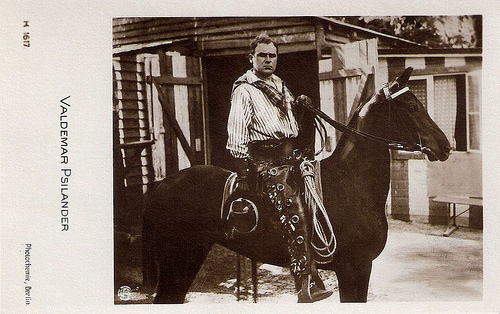
German postcard by Photochemie, Berlin, no. K 1617. Photo: Nordisk. Publicity still of Valdemar Psilander in Manden uden Fremtid/The man without a future (Holger-Madsen, 1916).

German postcard by Photochemie, Berlin, no. K. 1920. Photo: Nordisk Films. Gunnar Tolnaes in the Danish film Pjerrot (Hjalmar Davidsen, 1917).
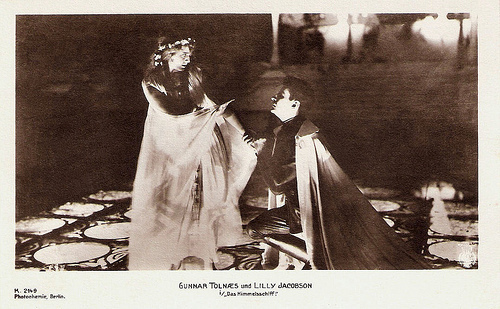
German postcard by Photochemie, Berlin, no. K. 2149. Photo: Nordisk. Publicity still for Himmelskibet/Das Himmelschiff (Holger-Madsen, 1918) with Lilly Jacobsson as Marya, the Martian leader's daughter, and Gunnar Tolnaes as Avanti Planetaros.
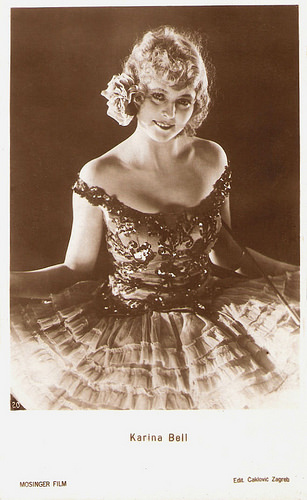
Yugoslavian postcard by Edit. Cakovic, Zagreb, no. 3747/1. Photo: Mosinger Film. Publicity still for Klovnen/The Clown (A.W. Sandberg, 1926) with Karina Bell.
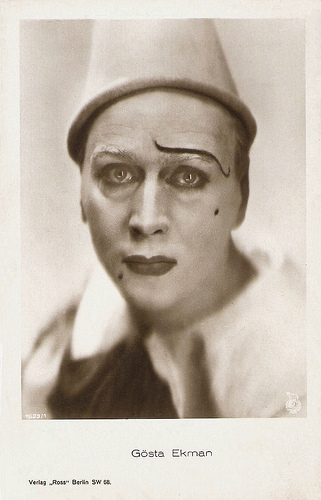
German postcard by Ross Verlag, no. 1623/1, 1927-1928. Photo: Nordisk. Publicity still for Klovnen/The Clown (A.W. Sandberg, 1926) with Gösta Ekman .
A polar bear atop a globe
In 1905, former circus impresario Ole Olsen (1863-1943) opened Biografteateret (The Biograph Theatre) - one of the first cinemas in Denmark - at Vimmelskaftet 47 in Copenhagen. A year later, Olsen began to produce films under the name of 'Ole Olsen’s Film Factory'. The first film is called Duer og måger/Pigeons and Sea Gulls (1906), a two minute reportage. However, right from the beginning dramatic films were made too – often starring the multi-talented draftsman, Robert Strom Petersen. 'Nordisk Films Kompagni' was officially founded on 6 November 1906. By the end of the year, the company has established offices at Vimmelskaftet, studios at a garden allotment in Valby, a copying lab in Frihavnen, an affilitate in Germany, an agent in Sweden – and a polar bear atop a globe as the company’s trademark.
Affiliates were established in Vienna and London in 1907. The film Løvejagten/Lion Hunting (Viggo Larsson, 1907) sold 256 copies and was very successful. However, as Ole Olsen refused to obey Minister of Justice, Alberti’s order to halt the shooting of Løvejagten in the wake of an animal cruelty charge, he lost his cinema license for 'Biografteatret'. Olsen just slipped the film across the border and premiered it in Sweden. Løvejagten/Lion Hunting was a huge international success and set Nordisk on its path to glory.
Nordisk continued to grow rapidly. In 1908, Studio 1 in Valby was opened, and the New York affiliate, 'Great Northern Film Company', was established. The opening of Studio 2 in Valby followed in 1910. The Aarhus-based company 'Fotorama' introduced multi-reel films with Den Hvide Slavehandel/The White Slavery Trade (1910). Ole Olsen adapted the idea by copying the Fotorama-film nearly shot by shot (and adding 100 meters). The same team of Løvejagten, writer Arnold Richard Nielsen, director/star Viggo Larsen and cinematographer Axel Graatkjær (Axel Sørensen), made this film titled Den hvide Slavinde (Viggo Larsen, 1907), about women being kidnapped and forced to prostitution. This lurid piece of sensationalism set off another international film fad, caused all sorts of rumpus over censorship and even contributed to a change in the law in the US (the Mann Act). A year later, Olsen committed Nordisk Films Kompagni – as the first company in the world to produce multi-reel films of approx. 45 minutes duration.
Nordisk Film became a public company, and Ole Olsen acquired the title of managing director (1911-1922). The actor Valdemar Psilander appeared in his first Nordisk Film feature, Ved fængslets port/Temptations of a Great City (August Blom, 1911). At the end of 1916, he had made more than eighty Nordisk Film features and was considered to be one of the greatest (and best paid) film stars of his time. Yet by the end of 1916, Psilander was demanding a salary of DKK 250,000 (34,000 EUR), which forced Nordisk Film into decline. The following year, Psilander suddenly passed away. Other major Nordisk film stars were Olaf Fønss , Clara Wieth Pontoppidan and the Norwegian Gunnar Tolnaes . Asta Nielsen also made two of her total of four Danish films for Nordisk Film: Balletdanserinden/The Ballet Dancer (August Blom, 1911), and Mod Lyset/Towards the Light (Holger-Madsen, 1919).
In 1912, Studio 3 in Valby was opened, and in 1914 Studio 4. Carl Th. Dreyer became a screenwriter and script consultant at Nordisk. In 1918, he directed his first film Præsidenten/The President, which premiered in Sweden in 1919 and Denmark in 1920. His ambitious film, Blade af Satans bog/Leaves from Satan’s Book premiered in 1921.
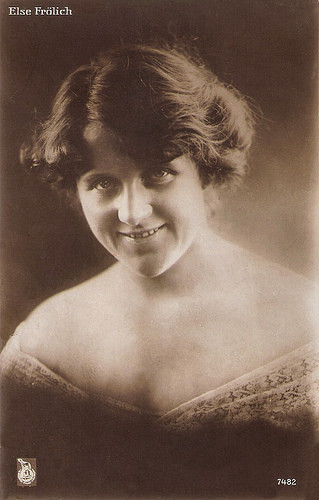
Else Frølich/Else Frölich . German postcard, no. 7482. Photo: Nordisk.
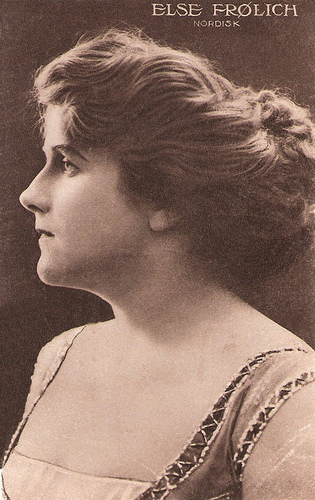
Else Frølich/Else Frölich . Danish postcard. Photo: Nordisk.
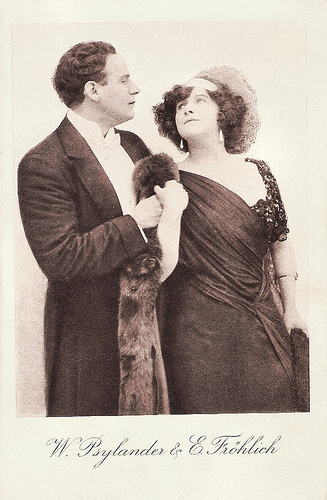
Austrian postcard by Edition Projectograph A.G., no. B.K.W.I. Kino 25. Photo: publicity still from Gæstespillet/Guest Game (Eduard Schnedler-Sørensen, 1913).
In the 1910s, Else Frølich/Else Frölich (1880-1960) was one of the leading actresses of the Danish Nordisk Company. She played in many Nordisk films and was often paired with the biggest male star of those years, Valdemar Psilander (1994-1917), such as in the beautifully restored Evangelimandens liv/The candle and the moth (Holger-Madsen, 1915). Frölich also often played in vehicles designed for herself.
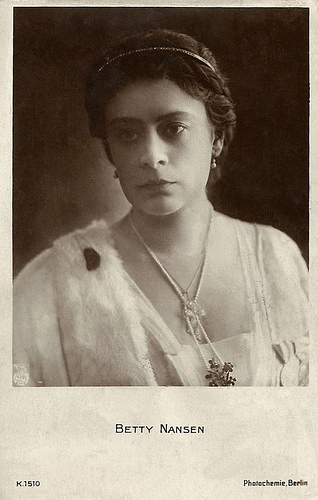
German postcard by Photochemie, Berlin, no. K 1510. Photo: Nordisk Films.
Betty Nansen (1873-1943) was a Danish stage and film actress who worked from 1913 on with prominent directors like August Blom, Holger Madsen and Robert Dinesen. Later she became the tdirector of the theatre that still carries her name, the Betty Nansen Theatre.
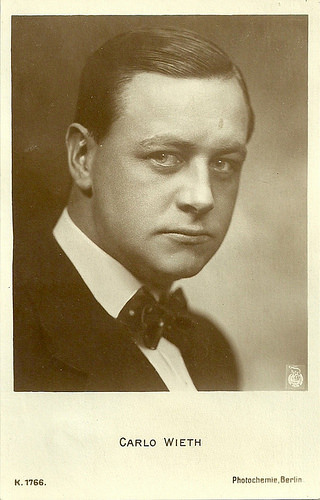
German postcard by Photochemie, Berlin, no. K. 1766. Photo: Nordisk.
Carlo Wieth (1885-1943) was a Danish actor, who starred in Danish and Swedish silent cinema of the 1910s and early 1920s, often paired with his then wife Clara (Pontoppidan) Wieth. After his start at Kinografen with Ekspeditricen/Salesgirl (August Blom, 1911), he played in some 18 films for Nordisk Film. With his somewhat boyish appearance and his fresh but gentle acting style, he soon became a popular actor.

German postcard by Photochemie, Berlin, no. K. 1662. Photo: Nordisk. Publicity still for Pjerrot/Pierrot (Hjalmar Davidsen, 1917) with Zanny Petersen and Gunnar Tolnaes .
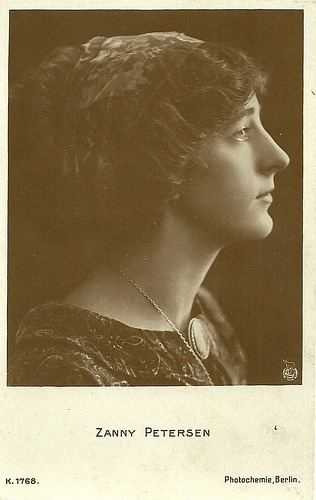
German postcard by Photochemie, Berlin, no. K. 1768. Photo: Nordisk Film.
Zanny Petersen (1892-1976) was a Danish stage and screen actress, who starred in Danish silent film since 1911. Between 1912 and 1917, she appeared in 40 films for Nordisk Film.
Huge and expensive costume dramas
In 1914, the peak of silent film production at Nordisk Films Kompagni was reached. 143 fiction and 46 non-fiction features were produced that year, and more than 7000 copies were sold. A year later, Studio 5 in Valby is opened, but the following year the New York affiliate was shut down.
World War I badly affected film distribution in Europe. The Russian market closed its borders due to the 1917 Revolution. Ole Olsen relinquished his German interests, now including sixty cinemas, a production company and various assets with a cumulative share capital of 30 million marks. Production was in decline and Nordisk Film lost millions.
Talented people left the company, including Lau Lauritzen, who directed more than 200 Nordisk Film faces. At Palladium, he created the biggest Danish film success of the 1920s: Fy og Bi (Fyrtårnet og Bivognen), the most famous comedy couple of the European silent cinema. Long Carl Schenstrom and short Harald Madsen became a hit with their short slapstick films, known under such different names as Pat & Patachon, Long & Short or Watt & Half-Watt.
A.W. Sandberg, who had been a successful director at Nordisk Film since 1914, became head of the production department in 1922. Throughout the 1920s, he directed a number of huge and expensive costume dramas, including the famous Charles Dickens’ adaptions, David Copperfield (A.W. Sandberg, 1922) and Lille Dorrit/Little Dorrit (A.W. Sandberg, 1924) with Karina Bell .
In 1923, H. Bloch-Jespersen became managing director of Nordisk Films Kompagni (1924-1926). From 1926 on, Nordisk Films Kompagni was controlled by the board. In 1928 Nordisk Films Kompagni suspended payments. At a general meeting it was decided that the company should be liquidated. In 1929 a wealthy stockbroker, Carl Bauder – the majority shareholder of both Nordisk and the Palads Teatret cinema since 1926 – acquired all the assets and reorganised the company under the name ‘Nordisk Films-Kompagni af 1929’. The company was known as ‘Nordisk Tone-film’ until the end of 1935, after which it reverted to its original name, Nordisk Films Kompagni.

German postcard by Photochemie, no. K. 1913. Photo: Nordisk Films. Gunnar Tolnaes in Pjerrot (Hjalmar Davidsen, 1917), with Ulla Nielsen as The Child.
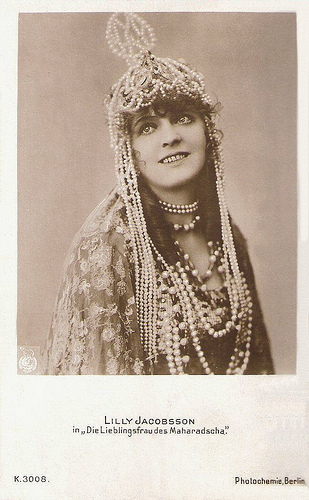
German postcard by Photochemie, Berlin, no. K. 3008. Photo: Nordisk. Lilly Jacobson in Maharadjahens Yndlingshustru/The Maharaja's Favourite Wife (Max Mack, 1917).
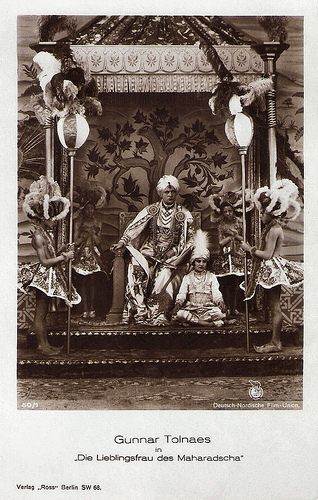
German postcard by Ross Verlag, no. 50/1. Photo: Deutsch Nordische Film Union / Nordisk. Gunnar Tolnaes in Maharadjahens Yndlingshustru/The Maharaja's Favourite Wife (Max Mack, 1917).
Gunnar Tolnaes (1879-1940) had his most famous performance as an Indian prince in the Danish orientalist melodrama Maharadjahens Yndlingshustru/The Maharaja's Favourite Wife (Max Mack, 1917), with Lilly Jacobson. It was so popular that it had a Danish sequel in 1919, and a German sequel in 1921.
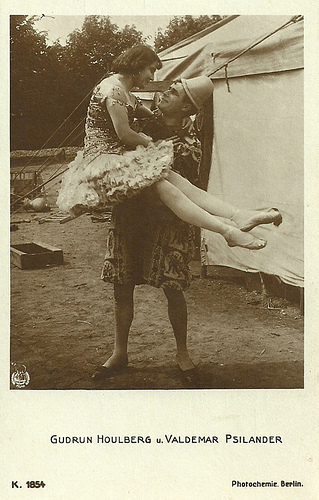
German postcard by Photochemie, Berlin, no. K. 1854. Photo: Nordisk Films. Valdemar Psilander and Gudrun Houlberg in Klovnen/The Clown (A.W. Sandberg, 1917).
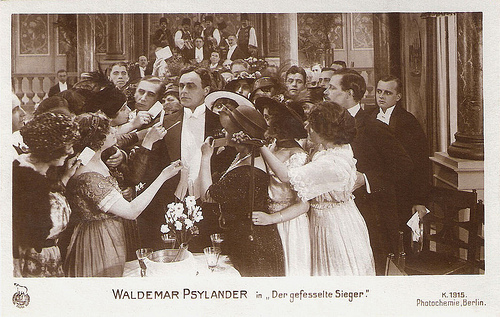
German postcard by Photochemie, Berlin, no. K.1915. Photo: Nordisk Films. Valdemar Psilander in Der gefesselte Sieger (The conqueror in chains), the German release title for Hvorledes jeg kom til filmen/The Mute (Robert Dinesen, 1919). Psilander plays a star of the silent pictures, so basically himself.
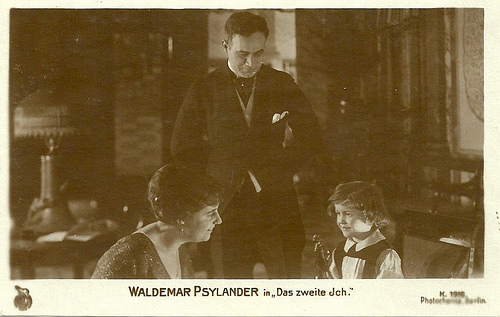
German postcard by Photochemie, Berlin, no. K. 1916. Photo: Nordisk Films. Valdemar Psilander and Ebba Thomsen in Das zweite Ich, German release title for Lykken/The Road to Happiness (Holger-Madsen, 1918).
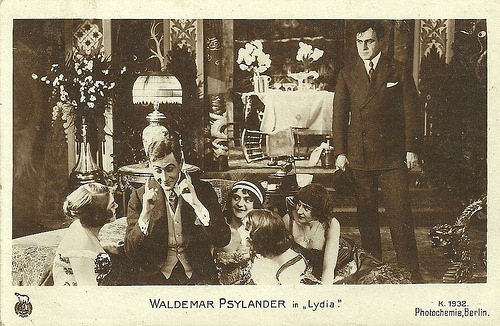
German postcard by Photochemie, Berlin, no. K. 1932. Photo: Nordisk Films. Valdemar Psilander in Lydia (Holger-Madsen, 1918).
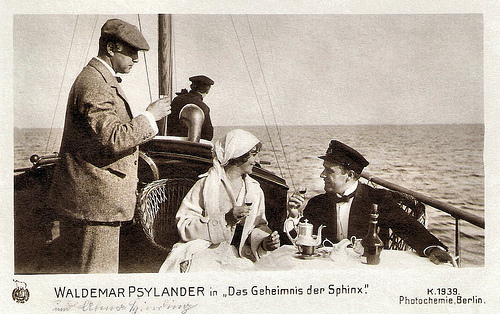
German postcard by Photochemie, Berlin, no. K. 1939. Photo: Nordisk Films. Valdemar Psilander in Das geheimnis des Sphinx, German release title for the Danish silent film Sfinxens Hemmelighed/The Secret of the Sphinx (Robert Dinesen, 1918).
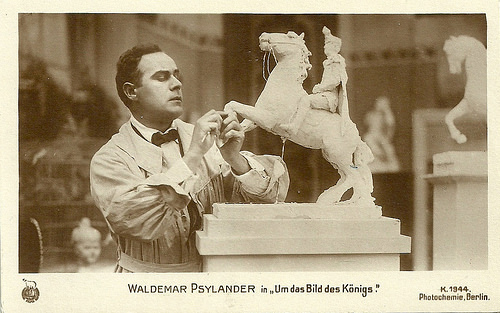
German postcard by Photochemie, Berlin, no. K. 1944. Photo: Nordisk Films. Valdemar Psilander in Rytterstatuen/For the king's statue (A.W. Sandberg, 1919). The German title is Um das Bild des Königs.
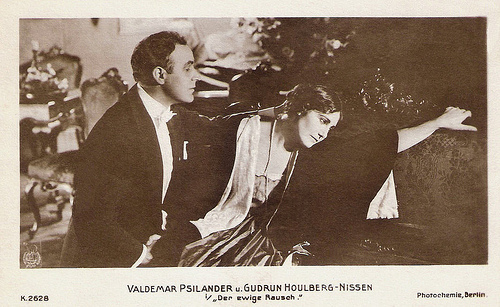
German postcard by Photochemie, Berlin, no. K. 2628. Photo: Nordisk Films. Publicity still of Valdemar Psilander and Gudrun Houlberg-Nissen in Kærlighedsleg/Der Ewige Rausch/Love (A.W. Sandberg, 1918).
Valdemar Psilander (1884-1917) was the most popular male actor in the Danish cinema of the 1910s. The charismatic Psilander took the German, Russian and Hungarian audiences by storm. At Nordisk he would play in six years in 83 films. Only 32 years old, Valdemar Psilander passed away in 1917. At the peak of his career. Some say he died of a cardiac affliction, others say it was suicide.
Insufficiently pro-German
Before, during and after the Nazi-German occupation of Denmark, Germany was one of the Danish film industry’s main trade partners. The scarcity of American films during the occupation opened up opportunities for Danish and German films. Carl Bauder, Nordisk Film’s shrewd owner, attempted unsuccessfully to monopolise German film distribution during the early years of the occupation. He failed because Nordisk Film was probably considered insufficiently pro-German. Like everyone else in the Danish film industry, Nordisk Film did business with the Germans during the occupation. Nordisk Film’s factory in the Frihavnen district of Copenhagen had a contract to copy German films, Nordisk Film rented out staff to produce the weekly newsreel Ugerevyen, and the company also exported Danish films to Germany.
During the occupation, Germans bomb the film studios in Valby, and Kino-Palæet (Nordisk Film’s cinema operating under Bauder’s licence) suffered extensive damage after being hit. In 1946, the rebuilt studio 4 was reopened. Erik Balling and Ove Sevel were employed as assistant directors. Balling later became director, screenwriter, producer and in 1957, his film Qivitoq (Erik Balling, 1957) was nominated for an Oscar. He became managing director of Nordisk Films Kompagni A/S from 1957 till 1989. In 1968, he had a box office hit with the comedy Olsen BandenThe Olsen Gang (Erik Balling, 1968). Two years later, he directed Huset på Christianshavn/Friends and Neighbours (Erik Balling, 1970-1977), a TV series in 84 episodes and the first fiction of the studio produced specifically for TV. While other film production companies shut down, Nordisk Film profits greatly on the TV series and avoids cutting down staff.
In the period 1971-1981, an 'Olsen Banden' film was produced every summer. The Olsen Gang became one of Denmark’s greatest film hits ever. In 1972, Studio 3 was rebuilt and became the biggest studio in Valby. Erik Balling made Matador/Monopoly (1978-1982) a TV series of 24 episodes which became the greatest TV success in Denmark to date. New directors such as Bille August, Kaspar Rostrup and Nils Malmros were making award-winning films at Nordisk.
In 1984, the young director Lars von Trier directed his first feature Forbrydelsens Element/The Element of Crime. The film won the Grand Prix du technique, Cannes, seven Danish Robert statuettes, and other awards. Another award winner was Tro, Håb og Kærlighed/Twist and Shout (Bille August, 1984). In 1987 followed Babettes Gæstebud/Babette’s Feast (Gabriel Axel, 1987), starring Stéphane Audran , which won the Academy Award for Best Foreign Film (1988), the first ever Danish Oscar.
The following year, Pelle Erobreren/Pelle the Conqueror (Bille August, 1988) won also the Academy Award for Best Foreign Film (1989), plus the Palme d´Or in Cannes, a Golden Globe Award, and eight Robert statuettes. Europa (Lars von Trier, 1991) with Barbara Sukowa and Jean-Marc Barr , was also awarded many prestigious prizes, including the Prix de la Commision & Special Prize in Cannes.
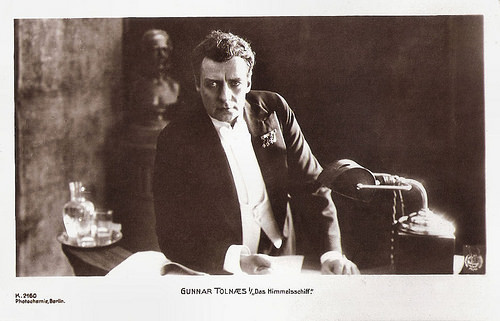
German postcard by Photochemie, Berlin, no. K. 2160. Photo: Nordisk. Publicity still for Himmelskibet/Das Himmelschiff (Holger-Madsen, 1918) with Gunnar Tolnaes as Avanti Planetaros.
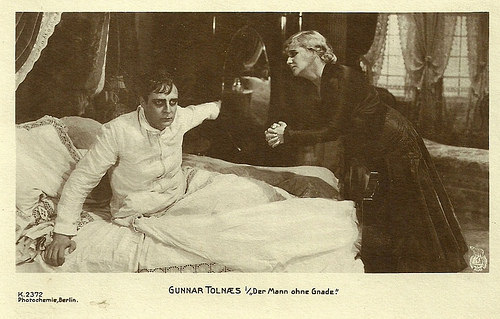
German postcard by Photochemie, no. K. 2372. Photo: Nordisk Films. Gunnar Tolnaes in Den Retfærdiges Hustru (A.W. Sandberg, 1917), co-starring Else Frölich .
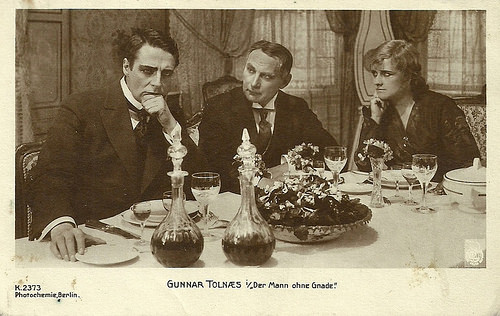
German postcard by Photochemie, no. K.2373. Photo: Nordisk Films. Gunnar Tolnaes in Den Retfærdiges Hustru (A.W. Sandberg, 1917), co-starring Else Frölich .
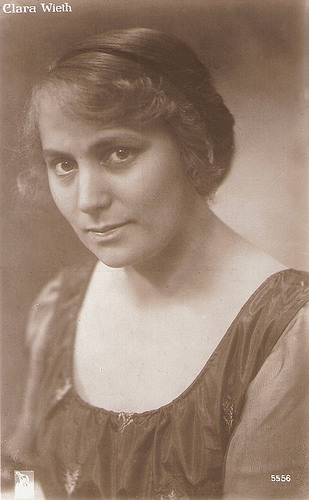
Clara Wieth . German postcard, no. 5556. Photo: Nordisk.
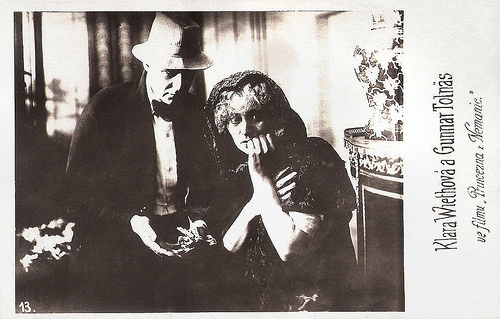
Latvian postcard, no. 13. Photo: Nordisk. Publicity still for Stodderprinsessen/Lumpen Princess (A.W. Sandberg, 1920) with Clara Wieth and Gunnar Tolnaes .
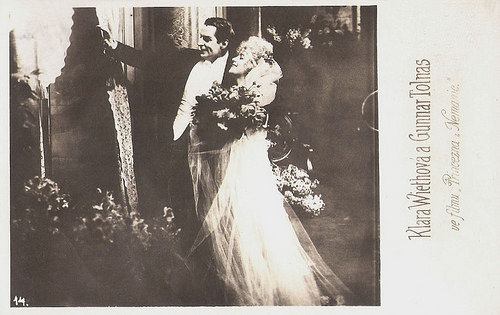
Latvian postcard, no. 14. Photo: Nordisk. Publicity still for Stodderprinsessen/Lumpen Princess (A.W. Sandberg, 1920) with Clara Wieth and Gunnar Tolnaes .
Clara Wieth (1883-1975), aka Clara Pontoppidan, was one the most active and popular actresses of the Danish silent cinema. Her breakthrough was with Den hvide Slavehandels sidste offer/The Last Victim of the White Slave Trade (August Blom, 1911), in which Clara plays an innocent girl who falls in the hand of white slavers who force girls into prostitution. Later she became a noted stage actress in Denmark and appeared in a number of Danish sound films.
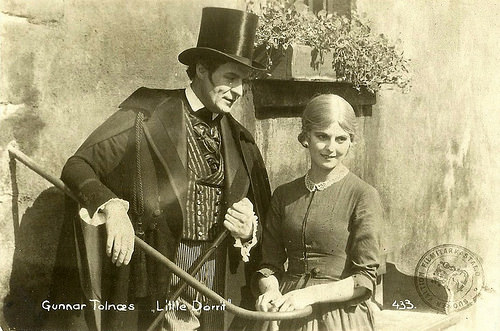
Finnish postcard, no. 433. The postcard carries a stamp of the Finnish film inspection office. Photo: publicity still for the Charles Dickens adaptation Lille Dorritt/Little Dorrit (A.W. Sandberg, 1924), starring Karina Bell as Little Dorrit and Gunnar Tolnaes as Arthur Clennam.
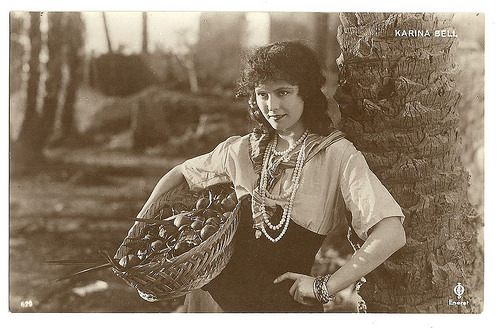
Danish postcard by Eneret, no. 629. Photo: Nordisk. Karina Bell in the romantic comedy Kan Kvinder fejle/Can women fail? (A.W. Sandberg, 1924), partly shot in Liguria, Italy.
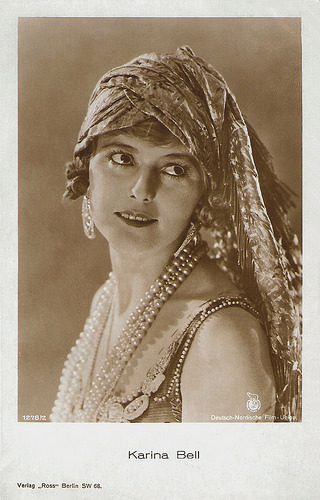
German postcard by Ross Verlag, no. 1278/2, 1927-1928. Photo: Nordisk Film / Deutsch-Nordische Film-Union. Publicity still for Maharadjahens yndlingshustru III/The Maharaja's Favourite Wife III (A.W. Sandberg, 1926) with Karina Bell .
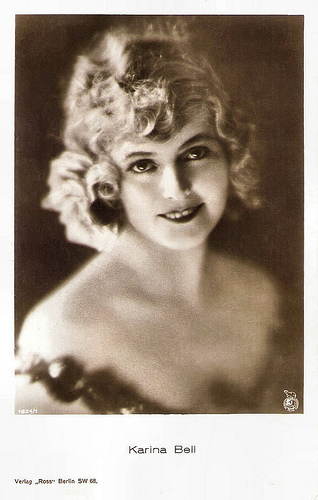
German postcard by Ross Verlag, no. 1624/1, 1927-1928. Photo: Nordisk Film. Publicity still for Klovnen/The Clown (A.W. Sandberg, 1926).
Charming Danish actress Karina Bell (1898-1979) was the most popular female star of the Nordisk Film Kompagni in the 1920s. The blond and slim actress was the beauty ideal of her generation. She also appeared in silent German and Swedish films. In later life she became the CEO of a Danish brewery.
The Polar Bear's Author Camp
In 1992, Nordisk merged with the Egmont media group and operates today as electronic media production and distribution group that employs 1,900 people. The total revenues in 2015 amounted to approximately €497 million. Today, Nordisk Film is the oldest film production company in operation in the world. Egmont Nordisk Film is the largest producer and distributor of electronic entertainment in the Nordic region.
The company produces and co-produces national and international feature films in Denmark, Norway and Sweden, which are distributed to cinemas around the Nordic countries, including Nordisk Film Cinemas in Denmark and Norway with 208 auditoriums. The films are also distributed internationally. Additionally, Nordisk Film produces animated content and feature films.
Through the Nordisk Film Foundation, Nordisk Film develop new talent. With an annual budget of approx. DKK 3.5 million, the Nordisk Film Foundation has also contributed to the development of the Danish film industry over the last 20 years by offering scholarships, project grants and awards. In 2015, the Nordisk Film Foundation launched the signature project 'The Polar Bear's Author Camp', bringing the total budget to EUR 4.5 million.
On 18 May 2012, Nordisk Film made a multi-year deal with Lionsgate to distribute their films (along with Summit Entertainment) in Scandinavia. In September 2012, DreamWorks signed a partnership with Nordisk Film for the distribution of DreamWorks' films in Scandinavia. On 31 March 2017, 20th Century Fox signed a distribution deal with Nordisk for Denmark and Sweden.
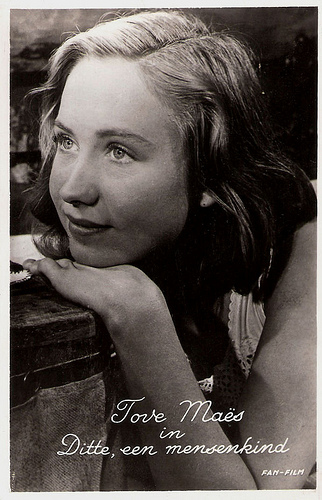
Dutch postcard. Photo: F.A.N. Film. Tove Maës in Ditte Menneskebarn/Ditte, Child of Man (Bjarne Henning-Jensen, 1946), released in the Netherlands as Ditte, een mensenkind.
Sources: Nordisk Film, Wikipedia and .

German postcard by Photochemie, Berlin, no. K 1617. Photo: Nordisk. Publicity still of Valdemar Psilander in Manden uden Fremtid/The man without a future (Holger-Madsen, 1916).

German postcard by Photochemie, Berlin, no. K. 1920. Photo: Nordisk Films. Gunnar Tolnaes in the Danish film Pjerrot (Hjalmar Davidsen, 1917).

German postcard by Photochemie, Berlin, no. K. 2149. Photo: Nordisk. Publicity still for Himmelskibet/Das Himmelschiff (Holger-Madsen, 1918) with Lilly Jacobsson as Marya, the Martian leader's daughter, and Gunnar Tolnaes as Avanti Planetaros.

Yugoslavian postcard by Edit. Cakovic, Zagreb, no. 3747/1. Photo: Mosinger Film. Publicity still for Klovnen/The Clown (A.W. Sandberg, 1926) with Karina Bell.

German postcard by Ross Verlag, no. 1623/1, 1927-1928. Photo: Nordisk. Publicity still for Klovnen/The Clown (A.W. Sandberg, 1926) with Gösta Ekman .
A polar bear atop a globe
In 1905, former circus impresario Ole Olsen (1863-1943) opened Biografteateret (The Biograph Theatre) - one of the first cinemas in Denmark - at Vimmelskaftet 47 in Copenhagen. A year later, Olsen began to produce films under the name of 'Ole Olsen’s Film Factory'. The first film is called Duer og måger/Pigeons and Sea Gulls (1906), a two minute reportage. However, right from the beginning dramatic films were made too – often starring the multi-talented draftsman, Robert Strom Petersen. 'Nordisk Films Kompagni' was officially founded on 6 November 1906. By the end of the year, the company has established offices at Vimmelskaftet, studios at a garden allotment in Valby, a copying lab in Frihavnen, an affilitate in Germany, an agent in Sweden – and a polar bear atop a globe as the company’s trademark.
Affiliates were established in Vienna and London in 1907. The film Løvejagten/Lion Hunting (Viggo Larsson, 1907) sold 256 copies and was very successful. However, as Ole Olsen refused to obey Minister of Justice, Alberti’s order to halt the shooting of Løvejagten in the wake of an animal cruelty charge, he lost his cinema license for 'Biografteatret'. Olsen just slipped the film across the border and premiered it in Sweden. Løvejagten/Lion Hunting was a huge international success and set Nordisk on its path to glory.
Nordisk continued to grow rapidly. In 1908, Studio 1 in Valby was opened, and the New York affiliate, 'Great Northern Film Company', was established. The opening of Studio 2 in Valby followed in 1910. The Aarhus-based company 'Fotorama' introduced multi-reel films with Den Hvide Slavehandel/The White Slavery Trade (1910). Ole Olsen adapted the idea by copying the Fotorama-film nearly shot by shot (and adding 100 meters). The same team of Løvejagten, writer Arnold Richard Nielsen, director/star Viggo Larsen and cinematographer Axel Graatkjær (Axel Sørensen), made this film titled Den hvide Slavinde (Viggo Larsen, 1907), about women being kidnapped and forced to prostitution. This lurid piece of sensationalism set off another international film fad, caused all sorts of rumpus over censorship and even contributed to a change in the law in the US (the Mann Act). A year later, Olsen committed Nordisk Films Kompagni – as the first company in the world to produce multi-reel films of approx. 45 minutes duration.
Nordisk Film became a public company, and Ole Olsen acquired the title of managing director (1911-1922). The actor Valdemar Psilander appeared in his first Nordisk Film feature, Ved fængslets port/Temptations of a Great City (August Blom, 1911). At the end of 1916, he had made more than eighty Nordisk Film features and was considered to be one of the greatest (and best paid) film stars of his time. Yet by the end of 1916, Psilander was demanding a salary of DKK 250,000 (34,000 EUR), which forced Nordisk Film into decline. The following year, Psilander suddenly passed away. Other major Nordisk film stars were Olaf Fønss , Clara Wieth Pontoppidan and the Norwegian Gunnar Tolnaes . Asta Nielsen also made two of her total of four Danish films for Nordisk Film: Balletdanserinden/The Ballet Dancer (August Blom, 1911), and Mod Lyset/Towards the Light (Holger-Madsen, 1919).
In 1912, Studio 3 in Valby was opened, and in 1914 Studio 4. Carl Th. Dreyer became a screenwriter and script consultant at Nordisk. In 1918, he directed his first film Præsidenten/The President, which premiered in Sweden in 1919 and Denmark in 1920. His ambitious film, Blade af Satans bog/Leaves from Satan’s Book premiered in 1921.

Else Frølich/Else Frölich . German postcard, no. 7482. Photo: Nordisk.

Else Frølich/Else Frölich . Danish postcard. Photo: Nordisk.

Austrian postcard by Edition Projectograph A.G., no. B.K.W.I. Kino 25. Photo: publicity still from Gæstespillet/Guest Game (Eduard Schnedler-Sørensen, 1913).
In the 1910s, Else Frølich/Else Frölich (1880-1960) was one of the leading actresses of the Danish Nordisk Company. She played in many Nordisk films and was often paired with the biggest male star of those years, Valdemar Psilander (1994-1917), such as in the beautifully restored Evangelimandens liv/The candle and the moth (Holger-Madsen, 1915). Frölich also often played in vehicles designed for herself.

German postcard by Photochemie, Berlin, no. K 1510. Photo: Nordisk Films.
Betty Nansen (1873-1943) was a Danish stage and film actress who worked from 1913 on with prominent directors like August Blom, Holger Madsen and Robert Dinesen. Later she became the tdirector of the theatre that still carries her name, the Betty Nansen Theatre.

German postcard by Photochemie, Berlin, no. K. 1766. Photo: Nordisk.
Carlo Wieth (1885-1943) was a Danish actor, who starred in Danish and Swedish silent cinema of the 1910s and early 1920s, often paired with his then wife Clara (Pontoppidan) Wieth. After his start at Kinografen with Ekspeditricen/Salesgirl (August Blom, 1911), he played in some 18 films for Nordisk Film. With his somewhat boyish appearance and his fresh but gentle acting style, he soon became a popular actor.

German postcard by Photochemie, Berlin, no. K. 1662. Photo: Nordisk. Publicity still for Pjerrot/Pierrot (Hjalmar Davidsen, 1917) with Zanny Petersen and Gunnar Tolnaes .

German postcard by Photochemie, Berlin, no. K. 1768. Photo: Nordisk Film.
Zanny Petersen (1892-1976) was a Danish stage and screen actress, who starred in Danish silent film since 1911. Between 1912 and 1917, she appeared in 40 films for Nordisk Film.
Huge and expensive costume dramas
In 1914, the peak of silent film production at Nordisk Films Kompagni was reached. 143 fiction and 46 non-fiction features were produced that year, and more than 7000 copies were sold. A year later, Studio 5 in Valby is opened, but the following year the New York affiliate was shut down.
World War I badly affected film distribution in Europe. The Russian market closed its borders due to the 1917 Revolution. Ole Olsen relinquished his German interests, now including sixty cinemas, a production company and various assets with a cumulative share capital of 30 million marks. Production was in decline and Nordisk Film lost millions.
Talented people left the company, including Lau Lauritzen, who directed more than 200 Nordisk Film faces. At Palladium, he created the biggest Danish film success of the 1920s: Fy og Bi (Fyrtårnet og Bivognen), the most famous comedy couple of the European silent cinema. Long Carl Schenstrom and short Harald Madsen became a hit with their short slapstick films, known under such different names as Pat & Patachon, Long & Short or Watt & Half-Watt.
A.W. Sandberg, who had been a successful director at Nordisk Film since 1914, became head of the production department in 1922. Throughout the 1920s, he directed a number of huge and expensive costume dramas, including the famous Charles Dickens’ adaptions, David Copperfield (A.W. Sandberg, 1922) and Lille Dorrit/Little Dorrit (A.W. Sandberg, 1924) with Karina Bell .
In 1923, H. Bloch-Jespersen became managing director of Nordisk Films Kompagni (1924-1926). From 1926 on, Nordisk Films Kompagni was controlled by the board. In 1928 Nordisk Films Kompagni suspended payments. At a general meeting it was decided that the company should be liquidated. In 1929 a wealthy stockbroker, Carl Bauder – the majority shareholder of both Nordisk and the Palads Teatret cinema since 1926 – acquired all the assets and reorganised the company under the name ‘Nordisk Films-Kompagni af 1929’. The company was known as ‘Nordisk Tone-film’ until the end of 1935, after which it reverted to its original name, Nordisk Films Kompagni.

German postcard by Photochemie, no. K. 1913. Photo: Nordisk Films. Gunnar Tolnaes in Pjerrot (Hjalmar Davidsen, 1917), with Ulla Nielsen as The Child.

German postcard by Photochemie, Berlin, no. K. 3008. Photo: Nordisk. Lilly Jacobson in Maharadjahens Yndlingshustru/The Maharaja's Favourite Wife (Max Mack, 1917).

German postcard by Ross Verlag, no. 50/1. Photo: Deutsch Nordische Film Union / Nordisk. Gunnar Tolnaes in Maharadjahens Yndlingshustru/The Maharaja's Favourite Wife (Max Mack, 1917).
Gunnar Tolnaes (1879-1940) had his most famous performance as an Indian prince in the Danish orientalist melodrama Maharadjahens Yndlingshustru/The Maharaja's Favourite Wife (Max Mack, 1917), with Lilly Jacobson. It was so popular that it had a Danish sequel in 1919, and a German sequel in 1921.

German postcard by Photochemie, Berlin, no. K. 1854. Photo: Nordisk Films. Valdemar Psilander and Gudrun Houlberg in Klovnen/The Clown (A.W. Sandberg, 1917).

German postcard by Photochemie, Berlin, no. K.1915. Photo: Nordisk Films. Valdemar Psilander in Der gefesselte Sieger (The conqueror in chains), the German release title for Hvorledes jeg kom til filmen/The Mute (Robert Dinesen, 1919). Psilander plays a star of the silent pictures, so basically himself.

German postcard by Photochemie, Berlin, no. K. 1916. Photo: Nordisk Films. Valdemar Psilander and Ebba Thomsen in Das zweite Ich, German release title for Lykken/The Road to Happiness (Holger-Madsen, 1918).

German postcard by Photochemie, Berlin, no. K. 1932. Photo: Nordisk Films. Valdemar Psilander in Lydia (Holger-Madsen, 1918).

German postcard by Photochemie, Berlin, no. K. 1939. Photo: Nordisk Films. Valdemar Psilander in Das geheimnis des Sphinx, German release title for the Danish silent film Sfinxens Hemmelighed/The Secret of the Sphinx (Robert Dinesen, 1918).

German postcard by Photochemie, Berlin, no. K. 1944. Photo: Nordisk Films. Valdemar Psilander in Rytterstatuen/For the king's statue (A.W. Sandberg, 1919). The German title is Um das Bild des Königs.

German postcard by Photochemie, Berlin, no. K. 2628. Photo: Nordisk Films. Publicity still of Valdemar Psilander and Gudrun Houlberg-Nissen in Kærlighedsleg/Der Ewige Rausch/Love (A.W. Sandberg, 1918).
Valdemar Psilander (1884-1917) was the most popular male actor in the Danish cinema of the 1910s. The charismatic Psilander took the German, Russian and Hungarian audiences by storm. At Nordisk he would play in six years in 83 films. Only 32 years old, Valdemar Psilander passed away in 1917. At the peak of his career. Some say he died of a cardiac affliction, others say it was suicide.
Insufficiently pro-German
Before, during and after the Nazi-German occupation of Denmark, Germany was one of the Danish film industry’s main trade partners. The scarcity of American films during the occupation opened up opportunities for Danish and German films. Carl Bauder, Nordisk Film’s shrewd owner, attempted unsuccessfully to monopolise German film distribution during the early years of the occupation. He failed because Nordisk Film was probably considered insufficiently pro-German. Like everyone else in the Danish film industry, Nordisk Film did business with the Germans during the occupation. Nordisk Film’s factory in the Frihavnen district of Copenhagen had a contract to copy German films, Nordisk Film rented out staff to produce the weekly newsreel Ugerevyen, and the company also exported Danish films to Germany.
During the occupation, Germans bomb the film studios in Valby, and Kino-Palæet (Nordisk Film’s cinema operating under Bauder’s licence) suffered extensive damage after being hit. In 1946, the rebuilt studio 4 was reopened. Erik Balling and Ove Sevel were employed as assistant directors. Balling later became director, screenwriter, producer and in 1957, his film Qivitoq (Erik Balling, 1957) was nominated for an Oscar. He became managing director of Nordisk Films Kompagni A/S from 1957 till 1989. In 1968, he had a box office hit with the comedy Olsen BandenThe Olsen Gang (Erik Balling, 1968). Two years later, he directed Huset på Christianshavn/Friends and Neighbours (Erik Balling, 1970-1977), a TV series in 84 episodes and the first fiction of the studio produced specifically for TV. While other film production companies shut down, Nordisk Film profits greatly on the TV series and avoids cutting down staff.
In the period 1971-1981, an 'Olsen Banden' film was produced every summer. The Olsen Gang became one of Denmark’s greatest film hits ever. In 1972, Studio 3 was rebuilt and became the biggest studio in Valby. Erik Balling made Matador/Monopoly (1978-1982) a TV series of 24 episodes which became the greatest TV success in Denmark to date. New directors such as Bille August, Kaspar Rostrup and Nils Malmros were making award-winning films at Nordisk.
In 1984, the young director Lars von Trier directed his first feature Forbrydelsens Element/The Element of Crime. The film won the Grand Prix du technique, Cannes, seven Danish Robert statuettes, and other awards. Another award winner was Tro, Håb og Kærlighed/Twist and Shout (Bille August, 1984). In 1987 followed Babettes Gæstebud/Babette’s Feast (Gabriel Axel, 1987), starring Stéphane Audran , which won the Academy Award for Best Foreign Film (1988), the first ever Danish Oscar.
The following year, Pelle Erobreren/Pelle the Conqueror (Bille August, 1988) won also the Academy Award for Best Foreign Film (1989), plus the Palme d´Or in Cannes, a Golden Globe Award, and eight Robert statuettes. Europa (Lars von Trier, 1991) with Barbara Sukowa and Jean-Marc Barr , was also awarded many prestigious prizes, including the Prix de la Commision & Special Prize in Cannes.

German postcard by Photochemie, Berlin, no. K. 2160. Photo: Nordisk. Publicity still for Himmelskibet/Das Himmelschiff (Holger-Madsen, 1918) with Gunnar Tolnaes as Avanti Planetaros.

German postcard by Photochemie, no. K. 2372. Photo: Nordisk Films. Gunnar Tolnaes in Den Retfærdiges Hustru (A.W. Sandberg, 1917), co-starring Else Frölich .

German postcard by Photochemie, no. K.2373. Photo: Nordisk Films. Gunnar Tolnaes in Den Retfærdiges Hustru (A.W. Sandberg, 1917), co-starring Else Frölich .

Clara Wieth . German postcard, no. 5556. Photo: Nordisk.

Latvian postcard, no. 13. Photo: Nordisk. Publicity still for Stodderprinsessen/Lumpen Princess (A.W. Sandberg, 1920) with Clara Wieth and Gunnar Tolnaes .

Latvian postcard, no. 14. Photo: Nordisk. Publicity still for Stodderprinsessen/Lumpen Princess (A.W. Sandberg, 1920) with Clara Wieth and Gunnar Tolnaes .
Clara Wieth (1883-1975), aka Clara Pontoppidan, was one the most active and popular actresses of the Danish silent cinema. Her breakthrough was with Den hvide Slavehandels sidste offer/The Last Victim of the White Slave Trade (August Blom, 1911), in which Clara plays an innocent girl who falls in the hand of white slavers who force girls into prostitution. Later she became a noted stage actress in Denmark and appeared in a number of Danish sound films.

Finnish postcard, no. 433. The postcard carries a stamp of the Finnish film inspection office. Photo: publicity still for the Charles Dickens adaptation Lille Dorritt/Little Dorrit (A.W. Sandberg, 1924), starring Karina Bell as Little Dorrit and Gunnar Tolnaes as Arthur Clennam.

Danish postcard by Eneret, no. 629. Photo: Nordisk. Karina Bell in the romantic comedy Kan Kvinder fejle/Can women fail? (A.W. Sandberg, 1924), partly shot in Liguria, Italy.

German postcard by Ross Verlag, no. 1278/2, 1927-1928. Photo: Nordisk Film / Deutsch-Nordische Film-Union. Publicity still for Maharadjahens yndlingshustru III/The Maharaja's Favourite Wife III (A.W. Sandberg, 1926) with Karina Bell .

German postcard by Ross Verlag, no. 1624/1, 1927-1928. Photo: Nordisk Film. Publicity still for Klovnen/The Clown (A.W. Sandberg, 1926).
Charming Danish actress Karina Bell (1898-1979) was the most popular female star of the Nordisk Film Kompagni in the 1920s. The blond and slim actress was the beauty ideal of her generation. She also appeared in silent German and Swedish films. In later life she became the CEO of a Danish brewery.
The Polar Bear's Author Camp
In 1992, Nordisk merged with the Egmont media group and operates today as electronic media production and distribution group that employs 1,900 people. The total revenues in 2015 amounted to approximately €497 million. Today, Nordisk Film is the oldest film production company in operation in the world. Egmont Nordisk Film is the largest producer and distributor of electronic entertainment in the Nordic region.
The company produces and co-produces national and international feature films in Denmark, Norway and Sweden, which are distributed to cinemas around the Nordic countries, including Nordisk Film Cinemas in Denmark and Norway with 208 auditoriums. The films are also distributed internationally. Additionally, Nordisk Film produces animated content and feature films.
Through the Nordisk Film Foundation, Nordisk Film develop new talent. With an annual budget of approx. DKK 3.5 million, the Nordisk Film Foundation has also contributed to the development of the Danish film industry over the last 20 years by offering scholarships, project grants and awards. In 2015, the Nordisk Film Foundation launched the signature project 'The Polar Bear's Author Camp', bringing the total budget to EUR 4.5 million.
On 18 May 2012, Nordisk Film made a multi-year deal with Lionsgate to distribute their films (along with Summit Entertainment) in Scandinavia. In September 2012, DreamWorks signed a partnership with Nordisk Film for the distribution of DreamWorks' films in Scandinavia. On 31 March 2017, 20th Century Fox signed a distribution deal with Nordisk for Denmark and Sweden.

Dutch postcard. Photo: F.A.N. Film. Tove Maës in Ditte Menneskebarn/Ditte, Child of Man (Bjarne Henning-Jensen, 1946), released in the Netherlands as Ditte, een mensenkind.
Sources: Nordisk Film, Wikipedia and .
Published on March 08, 2019 22:00
March 7, 2019
International Women's Day: Women Film Pioneers, Part 1: USA
It's 8 March and International Women's Day. For us, it is a day that celebrates womanhood and women's rights. One of our favourite sites is Women Pioneers Film Project, an incredible treasure of interesting essays, profiles and resources. For today's post, we selected 20 American women who both worked in front of and behind the camera during the silent film era, and whose profile can be found at WPFP. Part 2 of our post, on European women film pioneers, will be online at EFSP on 25 May, when the 10th Women and the Silent Screen Conference starts, hosted by Eye Filmmuseum in Amsterdam.
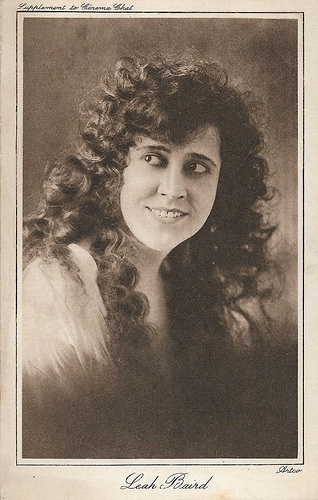
Leah Baird. British postcard by Cinema Chat. Photo: Artco. Baird was interested in bringing women’s issues to the screen, a commitment exemplified by such Leah Baird Productions, Inc. titles as The Bride’s Confession (1921), Don’t Doubt Your Wife (1922), When Husbands Deceive (1922), Destroying Angel (1923), and Is Divorce a Failure? (1923). For more on Leah Baird, see Women Pioneers Film Project
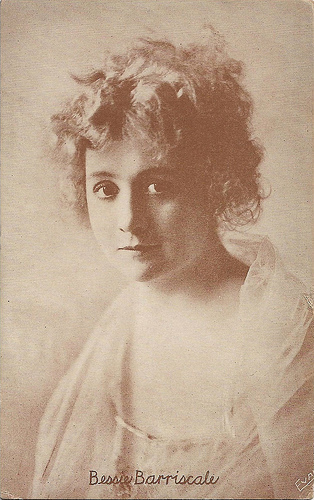
Bessie Barriscale. American postcard. Photo: Evans. Like many other film actresses, Barriscale capitalised on her fame and formed her own star company. The Bessie Barriscale Feature Company released eight films in 1918. It is difficult to determine Barriscale’s exact function within the company, beyond her role as leading lady and figurehead, but a newspaper suggested she had script control. See Women Pioneers Film Project
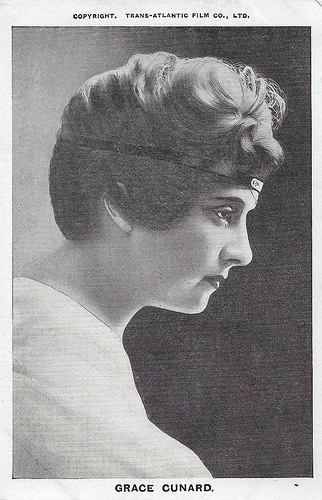
Grace Cunard. British postcard. Photo: Transatlantic-Film Co., Ltd., the British distributor for Europe for Universal's films in the 1910s. Cunard was one of Universal's most important serial queens in the 1910s. Typical for the pioneer years, Cunard also wrote some 100 film scripts, directed 11 films and produced two others. See Women Pioneers Film Project
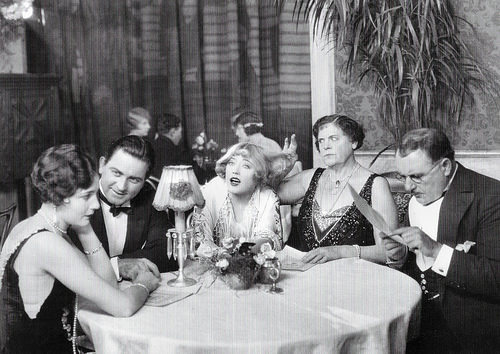
Marie Dressler. Promotion card for Il Cinema Ritrovato, Bologna, 2017. Photo: publicity still for The Patsy (King Vidor, 1928) with Marie Dressler (second from right) and with Jane Winton, Orville Caldwell, Marion Davies and Dell Henderson. See: Women Pioneers Film Project
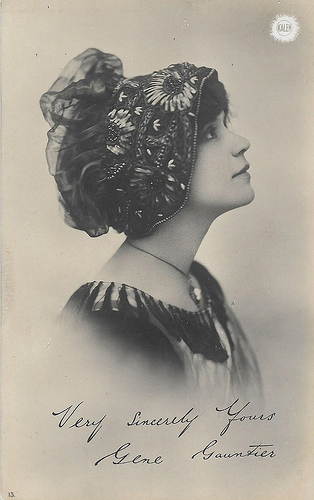
Gene Gauntier. American postcard. Photo: Kalem. During the years 1907-1912, Gene Gauntier, the first 'Kalem Girl', was the preeminent figure at the Kalem Film Manufacturing Company. She played key roles in the events that comprise established film history. She wrote the scenario for Ben Hur (1907), the work involved in the controversy that established the first copyright laws covering motion pictures, performed in 87 films and is credited as the director of The Grandmother (1909). See: Women Pioneers Film Project.
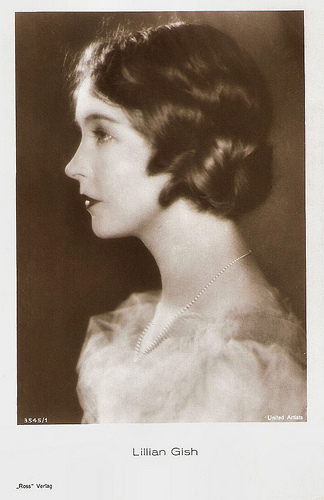
Lillian Gish . German postcard by Ross-Verlag, no. 3545/1, 1928-1929. Photo: United Artists. In 1920, Lillian Gish both delivered a landmark performance in D.W. Griffith’s Way Down East and directed her sister Dorothy Gish in Remodelling Her Husband. This was her sole director credit in a career as a screen actor that began with An Unseen Enemy in 1912 and ended with The Whales of August in 1987. See: Women Pioneers Film Project.
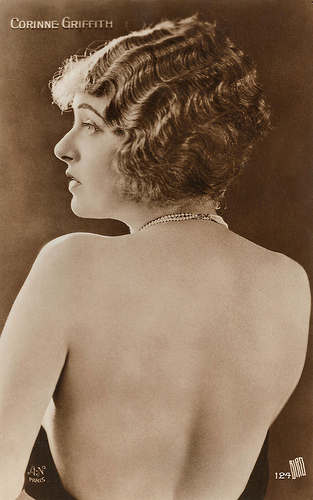
Corinne Griffith. French postcard by A.N. (A. Noyer), Paris, no. 124. Photo: Bird. Corinne Griffith found success as an actress, producer, author, real estate magnate, anti-income-tax crusader, painter, and composer. Contracts and letters on file in the Warner Brothers Archives show that arrangements between Corinne Griffith Productions and her distributors, First National Pictures and United Artists, awarded her a relatively high amount of oversight. See: Women Pioneers Film Project.
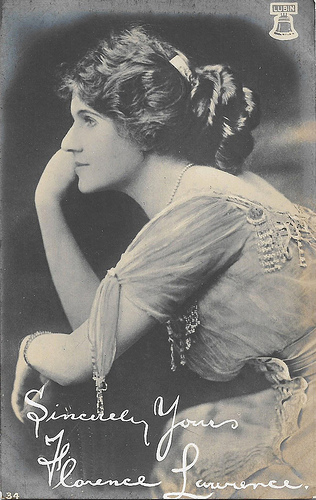
Florence Lawrence. British postcard, no. 34. Photo: Lubin. Lawrence was known as 'the Biograph girl'. With her husband, Harry Solter, she later started one of the first US film companies to be headed by a woman: the Victor Company. See Women Pioneers Film Project
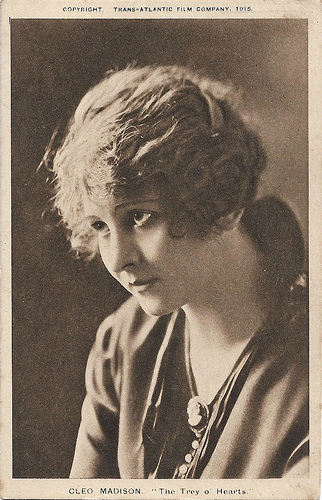
Cleo Madison. British postcard, 1915. Photo: Trans-Atlantic Film Company. Madison in The Trey o'Hearts (Wilfred Lucas, Henry MacRae, 1914). Madison’s acting career began in stock theatre and vaudeville. Universal hired her in 1913, and her performance in the dual role of good and evil twin sisters in the popular serial The Trey o’ Hearts (1914) secured her celebrity the following year. Beginning in 1915, she directed as well as acted in sixteen shorts and two features. See Women Pioneers Film Project.

Mae Murray. British postcard. Photo: Famous Players-Lasky. In 1922 Murray and her husband Robert Z. Leonard signed with Louis B. Mayer to make films for MGM under the Tiffany label, producing eight elaborate showcases for Murray’s extravagant and florid performance style. See Women Pioneers Film Project.
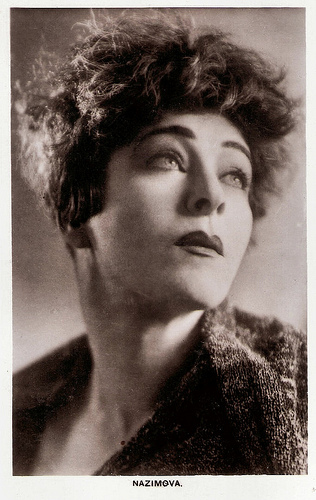
Alla Nazimova . British postcard in the Picturegoer series, London, no. 203. Working under contract with Metro Pictures Corporation between late 1917 and April 1921, her company, Nazimova Productions, produced nine largely profitable, feature-length films and brought along the writing talent of writer-producer June Mathis. See Women Pioneers Film Project.
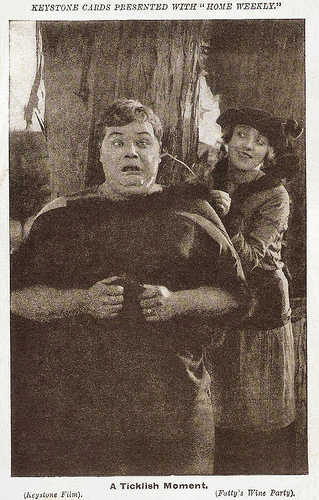
Mabel Normand. American postcard by Keystone cards, presented with Home Weekly. Photo: Keystone Film. Publicity still for Fatty's Wine Party (Roscoe 'Fatty' Arbuckle, 1914) with Normand and Fatty Arbuckle . Caption: A Ticklish Moment. Mabel Normand starred in at least one hundred and sixty-seven film shorts and twenty-three full-length features, mainly for Mack Sennett’s Keystone Film Company, and was one of the earliest silent actors to function as her own director. See Women Pioneers Film Project.
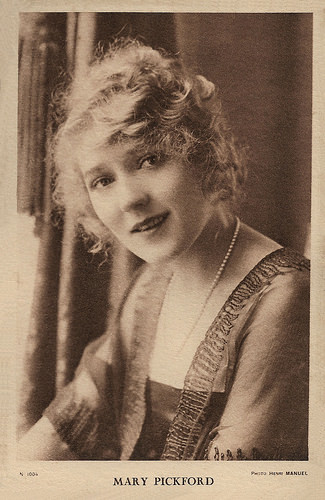
Mary Pickford. French postcard by Edition de la Cinématographie Française, Paris, no. 1004. Photo: Henri Manuel. In 1919, when she was only twenty-seven years old, Pickford cofounded United Artists, the first independent film distribution company along with Charlie Chaplin , D. W. Griffith, and her future husband Douglas Fairbanks . See Women Pioneers Film Project.
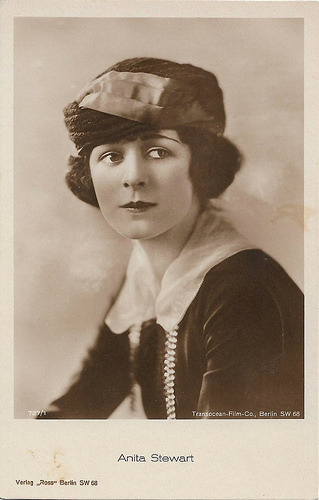
Anita Stewart. German postcard by Ross Verlag, no. 727/1. Photo: Transocean Film-Co, Berlin. Stewart began her career as an actress at the Vitagraph Company in 1911, and rose to become one of the most popular stars of the teens. In 1918 she started Anita Stewart Productions, in partnership with Louis B. Mayer, and began to produce her own feature films for First National Exhibitors Circuit. Anita Stewart Productions produced seventeen feature films between 1918 and 1922. See
Women Pioneers Film Project.
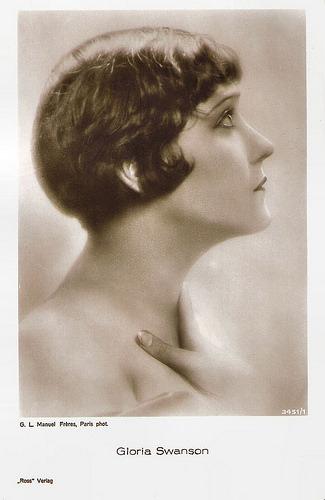
Gloria Swanson . German postcard by Ross Verlag, no. 3451/1, 1928-1929. Photo: G.L. Manuel Frères, Paris. By the time Swanson started her own production company, she had already been part of the film industry for over a decade. Many actresses started their own production companies in the 1920s and 1930s in an effort to gain more artistic freedom and a bigger percentage of the profits. Rarely, however, were actresses involved in the day-to-day workings of such an arrangement. Directors, husbands, or studio heads usually handled details. Gloria Swanson , however, remains an exception as she handled the business side of her first company; she did it not for 'artistic freedom' but, according to Swanson herself, in retaliation against Jesse Lasky. See Women Pioneers Film Project.
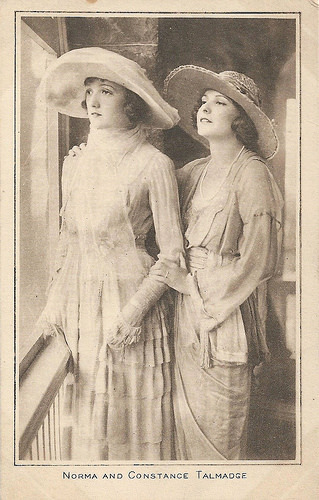
Constance and Norma Talmadge. British postcard by Pictures Ltd., London in the 'Pictures' Portrait Gallery, no. 195. The Talmadge sisters were two of the most beloved stars of the silent era. Norma’s career took an important turn when she met self-made millionaire Joseph M. Schenck, who wanted to produce motion pictures and was looking for a star. He set up the Norma Talmadge Film Corporation in New York. Their first production, Panthea (1917), about a young Russian pianist who gives up her honour to save her husband, was a huge popular and critical success. See Women Pioneers Film Project.
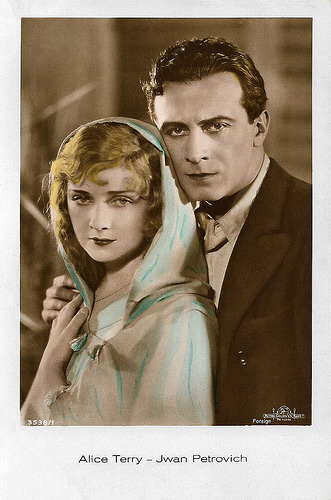
Alice Terry. British postcard by Ross Verlag, no. 3538/1. Photo: Metro-Goldwyn-Mayer. Publicity still for The Garden of Allah (Rex Ingram, 1927) with Ivan Petrovich . Alice Terry is probably best known to silent cinema historians in relation to the men with whom she frequently worked — Rudolph Valentino , in The Four Horsemen of the Apocalypse (1921) and The Conquering Power (1921); Ramon Novarro , in Scaramouche (1923) and The Arab (1924); and her husband, Rex Ingram, who directed Terry in all of these films as well as eight others. 'Rex and His Queen' were one of the more celebrated director-actress teams of the 1920s, but there are indications that performing was only one dimension of Terry’s contribution to their work together. The most concrete acknowledgement of this behind-the-camera labour is found in their last film, Baroud (1932), in which she did not appear but for which she received on-screen co-directorial credit. See: Women Pioneers Film Project.
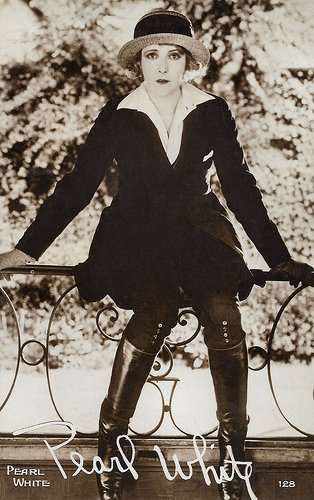
Pearl White. French postcard by Editions Cinémagazine, no. 128. Commonly known as the Pathé Frère company’s 'Peerless Fearless Girl', or the 'Heroine of a Thousand Stunts', Pearl White’s undaunted and adventurous persona became emblematic for her career and for serial queens by and large. She achieved her breakthrough in 1914 as Pauline in The Perils of Pauline, Pathé’s first serial. The Perils of Pauline is still the best-known production from the American serial craze featuring a new and independent female type of protagonist within a sensational, action-packed framework. See: Women Pioneers Film Project.
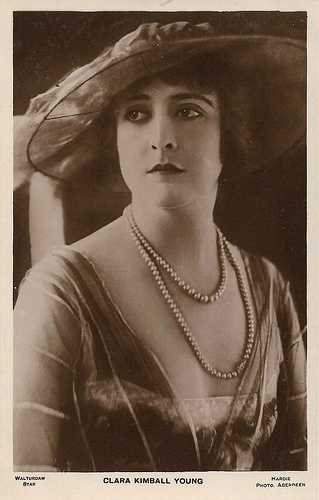
Clara Kimball Young. British (Scottish) postcard. Photo: Hardie, Aberdeen / Walturdaw. In 1916, Clara Kimball Young became only the second female film star, after Mary Pickford, to set up her own namesake production company: the Clara Kimball Young Film Corporation. Soon after this, there was a flood of female star-producers, initiating what I have called a 'second wave' of star companies, 1916–1923. See Women Pioneers Film Project.
Source: Women Film Pioneers Project.

Leah Baird. British postcard by Cinema Chat. Photo: Artco. Baird was interested in bringing women’s issues to the screen, a commitment exemplified by such Leah Baird Productions, Inc. titles as The Bride’s Confession (1921), Don’t Doubt Your Wife (1922), When Husbands Deceive (1922), Destroying Angel (1923), and Is Divorce a Failure? (1923). For more on Leah Baird, see Women Pioneers Film Project

Bessie Barriscale. American postcard. Photo: Evans. Like many other film actresses, Barriscale capitalised on her fame and formed her own star company. The Bessie Barriscale Feature Company released eight films in 1918. It is difficult to determine Barriscale’s exact function within the company, beyond her role as leading lady and figurehead, but a newspaper suggested she had script control. See Women Pioneers Film Project

Grace Cunard. British postcard. Photo: Transatlantic-Film Co., Ltd., the British distributor for Europe for Universal's films in the 1910s. Cunard was one of Universal's most important serial queens in the 1910s. Typical for the pioneer years, Cunard also wrote some 100 film scripts, directed 11 films and produced two others. See Women Pioneers Film Project

Marie Dressler. Promotion card for Il Cinema Ritrovato, Bologna, 2017. Photo: publicity still for The Patsy (King Vidor, 1928) with Marie Dressler (second from right) and with Jane Winton, Orville Caldwell, Marion Davies and Dell Henderson. See: Women Pioneers Film Project

Gene Gauntier. American postcard. Photo: Kalem. During the years 1907-1912, Gene Gauntier, the first 'Kalem Girl', was the preeminent figure at the Kalem Film Manufacturing Company. She played key roles in the events that comprise established film history. She wrote the scenario for Ben Hur (1907), the work involved in the controversy that established the first copyright laws covering motion pictures, performed in 87 films and is credited as the director of The Grandmother (1909). See: Women Pioneers Film Project.

Lillian Gish . German postcard by Ross-Verlag, no. 3545/1, 1928-1929. Photo: United Artists. In 1920, Lillian Gish both delivered a landmark performance in D.W. Griffith’s Way Down East and directed her sister Dorothy Gish in Remodelling Her Husband. This was her sole director credit in a career as a screen actor that began with An Unseen Enemy in 1912 and ended with The Whales of August in 1987. See: Women Pioneers Film Project.

Corinne Griffith. French postcard by A.N. (A. Noyer), Paris, no. 124. Photo: Bird. Corinne Griffith found success as an actress, producer, author, real estate magnate, anti-income-tax crusader, painter, and composer. Contracts and letters on file in the Warner Brothers Archives show that arrangements between Corinne Griffith Productions and her distributors, First National Pictures and United Artists, awarded her a relatively high amount of oversight. See: Women Pioneers Film Project.

Florence Lawrence. British postcard, no. 34. Photo: Lubin. Lawrence was known as 'the Biograph girl'. With her husband, Harry Solter, she later started one of the first US film companies to be headed by a woman: the Victor Company. See Women Pioneers Film Project

Cleo Madison. British postcard, 1915. Photo: Trans-Atlantic Film Company. Madison in The Trey o'Hearts (Wilfred Lucas, Henry MacRae, 1914). Madison’s acting career began in stock theatre and vaudeville. Universal hired her in 1913, and her performance in the dual role of good and evil twin sisters in the popular serial The Trey o’ Hearts (1914) secured her celebrity the following year. Beginning in 1915, she directed as well as acted in sixteen shorts and two features. See Women Pioneers Film Project.

Mae Murray. British postcard. Photo: Famous Players-Lasky. In 1922 Murray and her husband Robert Z. Leonard signed with Louis B. Mayer to make films for MGM under the Tiffany label, producing eight elaborate showcases for Murray’s extravagant and florid performance style. See Women Pioneers Film Project.

Alla Nazimova . British postcard in the Picturegoer series, London, no. 203. Working under contract with Metro Pictures Corporation between late 1917 and April 1921, her company, Nazimova Productions, produced nine largely profitable, feature-length films and brought along the writing talent of writer-producer June Mathis. See Women Pioneers Film Project.

Mabel Normand. American postcard by Keystone cards, presented with Home Weekly. Photo: Keystone Film. Publicity still for Fatty's Wine Party (Roscoe 'Fatty' Arbuckle, 1914) with Normand and Fatty Arbuckle . Caption: A Ticklish Moment. Mabel Normand starred in at least one hundred and sixty-seven film shorts and twenty-three full-length features, mainly for Mack Sennett’s Keystone Film Company, and was one of the earliest silent actors to function as her own director. See Women Pioneers Film Project.

Mary Pickford. French postcard by Edition de la Cinématographie Française, Paris, no. 1004. Photo: Henri Manuel. In 1919, when she was only twenty-seven years old, Pickford cofounded United Artists, the first independent film distribution company along with Charlie Chaplin , D. W. Griffith, and her future husband Douglas Fairbanks . See Women Pioneers Film Project.

Anita Stewart. German postcard by Ross Verlag, no. 727/1. Photo: Transocean Film-Co, Berlin. Stewart began her career as an actress at the Vitagraph Company in 1911, and rose to become one of the most popular stars of the teens. In 1918 she started Anita Stewart Productions, in partnership with Louis B. Mayer, and began to produce her own feature films for First National Exhibitors Circuit. Anita Stewart Productions produced seventeen feature films between 1918 and 1922. See
Women Pioneers Film Project.

Gloria Swanson . German postcard by Ross Verlag, no. 3451/1, 1928-1929. Photo: G.L. Manuel Frères, Paris. By the time Swanson started her own production company, she had already been part of the film industry for over a decade. Many actresses started their own production companies in the 1920s and 1930s in an effort to gain more artistic freedom and a bigger percentage of the profits. Rarely, however, were actresses involved in the day-to-day workings of such an arrangement. Directors, husbands, or studio heads usually handled details. Gloria Swanson , however, remains an exception as she handled the business side of her first company; she did it not for 'artistic freedom' but, according to Swanson herself, in retaliation against Jesse Lasky. See Women Pioneers Film Project.

Constance and Norma Talmadge. British postcard by Pictures Ltd., London in the 'Pictures' Portrait Gallery, no. 195. The Talmadge sisters were two of the most beloved stars of the silent era. Norma’s career took an important turn when she met self-made millionaire Joseph M. Schenck, who wanted to produce motion pictures and was looking for a star. He set up the Norma Talmadge Film Corporation in New York. Their first production, Panthea (1917), about a young Russian pianist who gives up her honour to save her husband, was a huge popular and critical success. See Women Pioneers Film Project.

Alice Terry. British postcard by Ross Verlag, no. 3538/1. Photo: Metro-Goldwyn-Mayer. Publicity still for The Garden of Allah (Rex Ingram, 1927) with Ivan Petrovich . Alice Terry is probably best known to silent cinema historians in relation to the men with whom she frequently worked — Rudolph Valentino , in The Four Horsemen of the Apocalypse (1921) and The Conquering Power (1921); Ramon Novarro , in Scaramouche (1923) and The Arab (1924); and her husband, Rex Ingram, who directed Terry in all of these films as well as eight others. 'Rex and His Queen' were one of the more celebrated director-actress teams of the 1920s, but there are indications that performing was only one dimension of Terry’s contribution to their work together. The most concrete acknowledgement of this behind-the-camera labour is found in their last film, Baroud (1932), in which she did not appear but for which she received on-screen co-directorial credit. See: Women Pioneers Film Project.

Pearl White. French postcard by Editions Cinémagazine, no. 128. Commonly known as the Pathé Frère company’s 'Peerless Fearless Girl', or the 'Heroine of a Thousand Stunts', Pearl White’s undaunted and adventurous persona became emblematic for her career and for serial queens by and large. She achieved her breakthrough in 1914 as Pauline in The Perils of Pauline, Pathé’s first serial. The Perils of Pauline is still the best-known production from the American serial craze featuring a new and independent female type of protagonist within a sensational, action-packed framework. See: Women Pioneers Film Project.

Clara Kimball Young. British (Scottish) postcard. Photo: Hardie, Aberdeen / Walturdaw. In 1916, Clara Kimball Young became only the second female film star, after Mary Pickford, to set up her own namesake production company: the Clara Kimball Young Film Corporation. Soon after this, there was a flood of female star-producers, initiating what I have called a 'second wave' of star companies, 1916–1923. See Women Pioneers Film Project.
Source: Women Film Pioneers Project.
Published on March 07, 2019 22:00
March 6, 2019
Valor civile (1916)
In 1915-1916, the Italian company Gloria Film made a series of nine short silent films based on the stories in the book 'Cuore' (Heart) by Edmondo De Amicis. Last Friday, we did a post on the seventh film, Il piccolo patriota padovano/The little patriot from Padua (Leopoldo Carlucci, 1915). Today follows the eighth film of the series, Valor civile/Civic Value (Umberto Paradisi, 1916), again with child actor Ermanno Roveri in the lead role. Stabilimenti Alterocca in Terni published another series of postcards to promote the film. Next Friday follows a post on the ninth and final part of this film series.
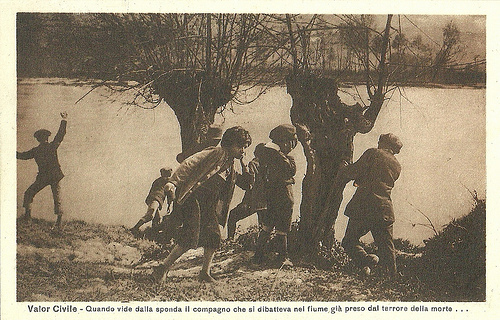
Italian postcard. Alterocca, Terni. Gloria Film. Card for Valor civile/Civic Value (Umberto Paradisi, 1916). Caption: When he saw from the river bank that his friend was fighting in the river, already taken by the terror of death...
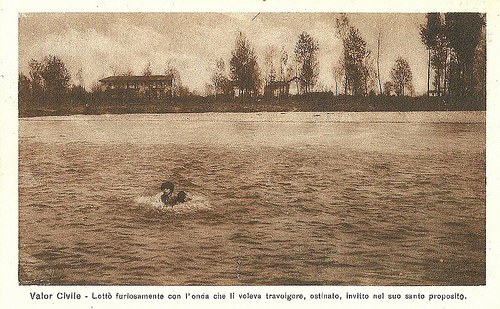
Italian postcard by Alterocca, Terni. Photo: Gloria Film. Card for Valor civile/Civic Value (Umberto Paradisi, 1916). Caption: he furiously fought with the wave that wanted to tear him down, he remained obstinate, invincible in his holy plight.
Risking his life to save that of a fellow
In the silent short Valor civile/Civic Value (Umberto Paradisi, 1916), Ermanno Roveri plays a Piedmont boy who risks his life to save that of a fellow (Antonio Monti) who is drowning in the river Po.
Later in the town hall, there is a solemn ceremony of handing over the medal for civil valour. And the winner is ...
Roveri and Monti had also appeared together in another short film of the Cuore series, Il piccolo scrivano fiorentino/The little scribe from Florence (Leopoldo Carlucci, 1915). Monti would also play in the diva film La Moglie di Claudio/The Wife of Claudius (Gero Zambuto, Giovanni Pastrone, 1918) starring Pina Menichelli, and a dozen other films till 1924.
In the Cuore films, the heroes are young Italian school boys who sacrifice themselves for their country and fight against the enemies at all time, even in distant wars. The Piedmont boy however survives his courageous action.
Valor civile/Civic Value (Umberto Paradisi, 1916) was again produced by Film Artistica Gloria and the cinematography was done by Giacomo Farò.
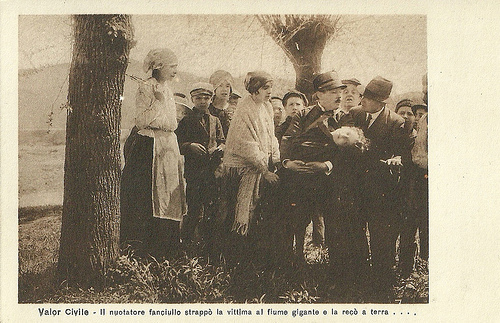
Italian postcard by Alterocca, Terni. Photo: Gloria Film. Card for Valor civile/Civic Value (Umberto Paradisi 1916). Caption: The young swimmer liberated the victim from the giant river and brought him to the river's edge.
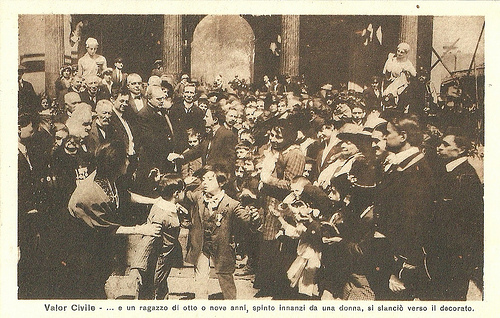
Italian postcard by Alterocca, Terni. Photo: Gloria Film. Card for Valor civile/Civic Value (Umberto Paradisi 1916). Caption: ... and a boy of eight or nine years old, pushed forward by a woman, threw himself on the decorated one.
Inspired by his own children
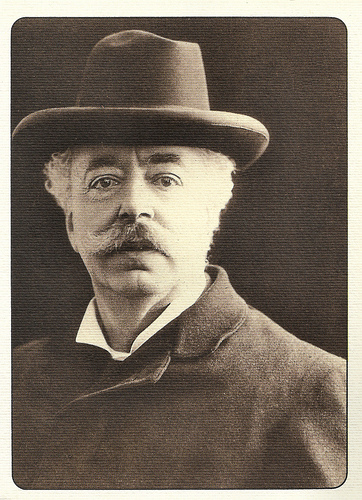
Edmondo de Amicis. Italian postcard by Intermail, Bergamo. Photo: Bompiani, Sonzogno. Italian author Edmondo de Amicis (1846-1908) was the author of the 1886 children's novel Cuore (Heart). De Amicis was a novelist, journalist, short story writer, and poet. Cuore is his best known work to this day, having been inspired by his own children Furio and Ugo who had been schoolboys at the time. It is set during the Italian unification, and includes several patriotic themes. It was issued by Treves on 18 October 1886, the first day of school in Italy, and rose to immediate success.
Edmondo de Amicis wrote Cuore in a diary form as told by Enrico Bottini, an 11-year-old primary school student in Turin with an upper class background who is surrounded by classmates of working class origin. The entire chronological setting corresponds to the third-grade season of 1881-1882. Enrico says it has been four years since death of Victor Emmanuel II, king of Italy, and the succession by Umberto I, and also tells about the death of Giuseppe Garibaldi, which happened in 1882. Enrico's parents and older sister Silvia interact with him as written in his diary. As well as his teacher who assigns him with homework that deals with several different stories of children throughout the Italian states who should be seen as role models – these stories are then given in the book as Enrico comes upon reading them. Every story revolves around a different moral value, the most prominent of which are helping those in need, having great love and respect for family and friends, and patriotism. These are called 'The Monthly Stories' and appear at the end of every school month.
Sources: Film Affinity and IMDb. For the full film, see Europeana.eu.

Italian postcard. Alterocca, Terni. Gloria Film. Card for Valor civile/Civic Value (Umberto Paradisi, 1916). Caption: When he saw from the river bank that his friend was fighting in the river, already taken by the terror of death...

Italian postcard by Alterocca, Terni. Photo: Gloria Film. Card for Valor civile/Civic Value (Umberto Paradisi, 1916). Caption: he furiously fought with the wave that wanted to tear him down, he remained obstinate, invincible in his holy plight.
Risking his life to save that of a fellow
In the silent short Valor civile/Civic Value (Umberto Paradisi, 1916), Ermanno Roveri plays a Piedmont boy who risks his life to save that of a fellow (Antonio Monti) who is drowning in the river Po.
Later in the town hall, there is a solemn ceremony of handing over the medal for civil valour. And the winner is ...
Roveri and Monti had also appeared together in another short film of the Cuore series, Il piccolo scrivano fiorentino/The little scribe from Florence (Leopoldo Carlucci, 1915). Monti would also play in the diva film La Moglie di Claudio/The Wife of Claudius (Gero Zambuto, Giovanni Pastrone, 1918) starring Pina Menichelli, and a dozen other films till 1924.
In the Cuore films, the heroes are young Italian school boys who sacrifice themselves for their country and fight against the enemies at all time, even in distant wars. The Piedmont boy however survives his courageous action.
Valor civile/Civic Value (Umberto Paradisi, 1916) was again produced by Film Artistica Gloria and the cinematography was done by Giacomo Farò.

Italian postcard by Alterocca, Terni. Photo: Gloria Film. Card for Valor civile/Civic Value (Umberto Paradisi 1916). Caption: The young swimmer liberated the victim from the giant river and brought him to the river's edge.

Italian postcard by Alterocca, Terni. Photo: Gloria Film. Card for Valor civile/Civic Value (Umberto Paradisi 1916). Caption: ... and a boy of eight or nine years old, pushed forward by a woman, threw himself on the decorated one.
Inspired by his own children

Edmondo de Amicis. Italian postcard by Intermail, Bergamo. Photo: Bompiani, Sonzogno. Italian author Edmondo de Amicis (1846-1908) was the author of the 1886 children's novel Cuore (Heart). De Amicis was a novelist, journalist, short story writer, and poet. Cuore is his best known work to this day, having been inspired by his own children Furio and Ugo who had been schoolboys at the time. It is set during the Italian unification, and includes several patriotic themes. It was issued by Treves on 18 October 1886, the first day of school in Italy, and rose to immediate success.
Edmondo de Amicis wrote Cuore in a diary form as told by Enrico Bottini, an 11-year-old primary school student in Turin with an upper class background who is surrounded by classmates of working class origin. The entire chronological setting corresponds to the third-grade season of 1881-1882. Enrico says it has been four years since death of Victor Emmanuel II, king of Italy, and the succession by Umberto I, and also tells about the death of Giuseppe Garibaldi, which happened in 1882. Enrico's parents and older sister Silvia interact with him as written in his diary. As well as his teacher who assigns him with homework that deals with several different stories of children throughout the Italian states who should be seen as role models – these stories are then given in the book as Enrico comes upon reading them. Every story revolves around a different moral value, the most prominent of which are helping those in need, having great love and respect for family and friends, and patriotism. These are called 'The Monthly Stories' and appear at the end of every school month.
Sources: Film Affinity and IMDb. For the full film, see Europeana.eu.
Published on March 06, 2019 22:00
March 5, 2019
Mouschy (1918)
German actress, writer and producer Hedda Vernon starred in more than 60 films of the early silent period. During the 1910s she was such a popular film star that she got her own Hedda-Vernon serial. One of her hits was Mouschy aka Mouchy (Hubert Moest, 1918), an Eiko Film production in which her co-star was Paul Hartmann.
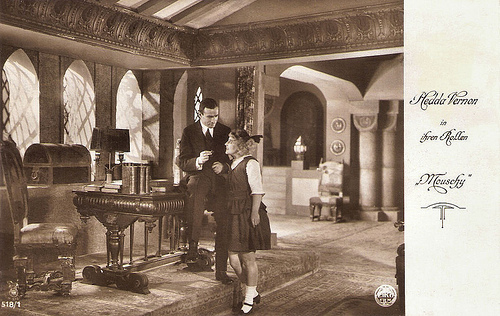
German postcard by Rotophot in the Film-Sterne series, no. 518/1. Photo: Eiko Film. Hedda Vernon and probably Theodor Becker in Mouschy aka Mouchy (Hubert Moest, 1918).
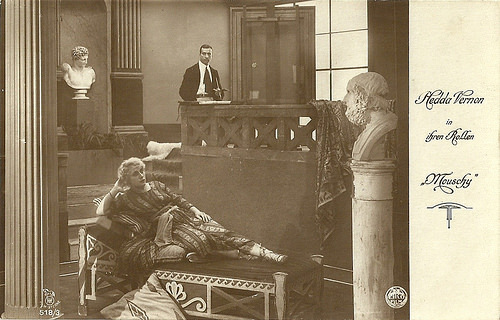
German postcard by Rotophot in the Film-Sterne series, no. 518/3. Photo: Eiko Film. Hedda Vernon and probably Theodor Becker in Mouschy (Hubert Moest, 1918).
Under the direction of her husband
In Mouschy (Hubert Moest, 1918), Hedda Vernon plays an orphan girl who is in love with a count (Theodor Becker). But he needs to marry rich. So Mouchy becomes the wife of the forester ( Paul Hartmann ). The script was written by Ruth Goetz and director Hubert Moest.
In 1913, Vernon had married Hubert Moest, who was also working as an actor. She was signed by the Eiko film and worked until the end of the First World War, mainly under the direction of her husband.
He founded in 1919 his own production company Moest production. For the Moest films Die roten Schuhe/The Red Shoes (1917) and Das Todesgeheimnis/The Death Secrets (1918) ,Vernon also wrote the screenplay. In 1920, her marriage to Moest ended in a divorce.
In Mouschy (Hubert Moest, 1918), but also earlier in Zofia (Hubert Moest, 1915), Hedda Vernon played a fifteen year old girl although she was double that age at the time. On the postcards it looks a bit silly. However, such ‘child parts’ were normal for actresses in the 1910s and 1920s.
In the cast of Mouschy were also Friedrich Kühne and Eva Speyer. Producer was Franz Vogel and the cinematography was done by Hans Karl Gottschalk. Not much more is known about the film.
Mouschy (Hubert Moest, 1918) premiered at the Berlin Tauentzienpalast in August 1918, only a few months before the end of the First World War.
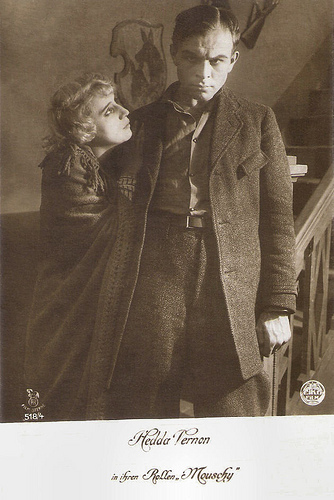
German postcard by Rotophot in the Film-Sterne series, no. 518/4. Photo: Eiko Film. Hedda Vernon and Paul Hartmann in Mouschy aka Mouchy (Hubert Moest, 1918).
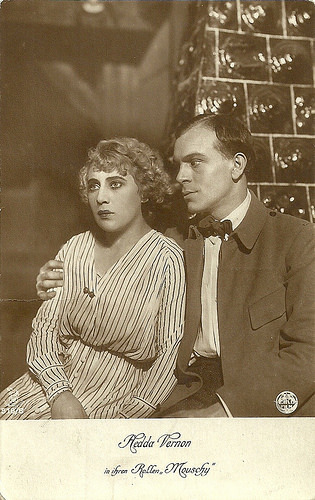
German postcard by Rotophot in the Film-Sterne series, no. 518/6. Photo: Eiko Film. Hedda Vernon and Paul Hartmann in Mouschy (Hubert Moest, 1918).
Sources: Wikipedia (German) and IMDb.

German postcard by Rotophot in the Film-Sterne series, no. 518/1. Photo: Eiko Film. Hedda Vernon and probably Theodor Becker in Mouschy aka Mouchy (Hubert Moest, 1918).

German postcard by Rotophot in the Film-Sterne series, no. 518/3. Photo: Eiko Film. Hedda Vernon and probably Theodor Becker in Mouschy (Hubert Moest, 1918).
Under the direction of her husband
In Mouschy (Hubert Moest, 1918), Hedda Vernon plays an orphan girl who is in love with a count (Theodor Becker). But he needs to marry rich. So Mouchy becomes the wife of the forester ( Paul Hartmann ). The script was written by Ruth Goetz and director Hubert Moest.
In 1913, Vernon had married Hubert Moest, who was also working as an actor. She was signed by the Eiko film and worked until the end of the First World War, mainly under the direction of her husband.
He founded in 1919 his own production company Moest production. For the Moest films Die roten Schuhe/The Red Shoes (1917) and Das Todesgeheimnis/The Death Secrets (1918) ,Vernon also wrote the screenplay. In 1920, her marriage to Moest ended in a divorce.
In Mouschy (Hubert Moest, 1918), but also earlier in Zofia (Hubert Moest, 1915), Hedda Vernon played a fifteen year old girl although she was double that age at the time. On the postcards it looks a bit silly. However, such ‘child parts’ were normal for actresses in the 1910s and 1920s.
In the cast of Mouschy were also Friedrich Kühne and Eva Speyer. Producer was Franz Vogel and the cinematography was done by Hans Karl Gottschalk. Not much more is known about the film.
Mouschy (Hubert Moest, 1918) premiered at the Berlin Tauentzienpalast in August 1918, only a few months before the end of the First World War.

German postcard by Rotophot in the Film-Sterne series, no. 518/4. Photo: Eiko Film. Hedda Vernon and Paul Hartmann in Mouschy aka Mouchy (Hubert Moest, 1918).

German postcard by Rotophot in the Film-Sterne series, no. 518/6. Photo: Eiko Film. Hedda Vernon and Paul Hartmann in Mouschy (Hubert Moest, 1918).
Sources: Wikipedia (German) and IMDb.
Published on March 05, 2019 22:00
March 4, 2019
Luke Perry (1966-2019)
American producer, director, writer, film and TV actor Luke Perry died on 4 March 2019 at St. Joseph's Hospital in Burbank, California, from complications of a stroke he suffered last week. Luke had a prolific acting career on TV and in films. He became a household name as Dylan McKay on the hit coming-of-age series Beverly Hills 90210 (1990-1995; 1998-2000). He also starred as Fred Andrews on the drama series Riverdale (2017). He was 52.

Italian postcard by Gruppo Editoriale Il Vecchio, Genova. Photo: publicity still for the TV-seriesBeverly Hills 90210.
Seemingly Bad Boy
Luke Perry was born Coy Luther Perry III in Mansfield, Ohio in, 1966. His parents were Ann Bennett, a homemaker, and Coy Luther Perry Jr., a steelworker.
He was raised in the small community of Fredericktown. Perry moved to Los Angeles to pursue acting soon after graduating from high school. There he worked a series of odd jobs as he tried to break into the business.
After appearing in the music video Be Chrool to Your Scuel for the band Twisted Sister alongside Alice Cooper, he scored an appearance as Ned Bates on the soap opera Loving (1987-1988), which required him to move to New York City.
Perry then landed a role on another soap, this time portraying Kenny on Another World (1988-1989). But it was his role as seemingly bad boy Dylan McKay on Beverly Hills 90210 in 1990 which made Perry a popular teen idol.
Perry had auditioned for the role of Steve Sanders, but the role eventually went to Ian Ziering before Perry was cast as Dylan McKay. Perry's character was not an original cast member of the show, and he was first featured in the show's second episode. He was originally intended to only appear in one story arc, for one or two episodes.
Fox was initially reluctant to have him included as a regular, but producer Aaron Spelling felt differently and gave Perry a bigger role during the first two years until the network was won over. The actor famously left the show in Season 6, seeking to break away from the Dylan character and to pursue more mature roles, but he returned in Season 9, apparently due to financial reasons.
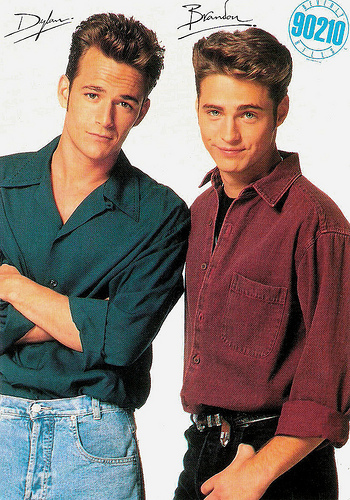
Italian postcard by Gruppo Editoriale Il Vecchio, Genova. Photo: publicity still for the TV-series Beverly Hills 90210, with Luke Perry and Jason Priestley.
A Valley Girl Cheerleader named Buffy
Luke Perry also appeared often in the cinema. In 1992, he won a co-starring role in the film version of Joss Whedon's Buffy The Vampire Slayer (Fran Rubel Kuzui, 1992), with Kristy Swanson.
It follows a Valley girl cheerleader named Buffy who learns that it is her fate to hunt vampires. It was a moderate success at the box office but received mixed reception from critics.
The film was taken in a different direction from the one its writer Joss Whedon intended, and five years later, he created the darker and acclaimed TV series of the same name.
Perry played roles in such films as Terminal Bliss (Jordan Alan, 1992), the biographical drama 8 Seconds (John G. Avildsen, 1994) about rodeo legend Lane Frost, and the crime drama Normal Life (John McNaughton, 1996) with Ashley Judd. He had a small role in Luc Besson's Science-Fiction adventure The Fifth Element (1997) with Bruce Willis and Milla Jovovich.
Perry guest-starred as gay characters in the sitcoms Spin City (1997) and Will & Grace (2005); he appeared as Carter Heywood's (Michael Boatman) ex-boyfriend who subsequently fell in love with a woman on Spin City and played a geeky birdwatcher who caught the eye of Jack McFarland (Sean Hayes) on Will & Grace.
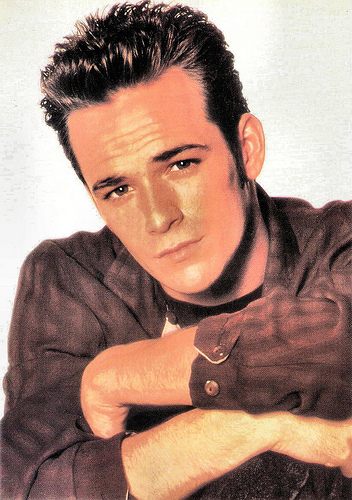
Italian postcard by Gruppo Editoriale Il Vecchio, Genova. Photo: publicity still for the TV-series Beverly Hills 90210.
It was television that showed him the most love
Luke Perry made his Broadway debut in 2001 as Brad in a revival of 'The Rocky Horror Show'. He also starred in the London West End adaptation of 'When Harry Met Sally'. But it was television that showed the actor the most love.
From 2001 to 2002, he starred in the prison drama Oz, as the Reverend Jeremiah Cloutier. From 2002 to 2004 he acted in the post-apocalyptic TV series Jeremiah. And in 2006 Perry co-starred in the ensemble drama series Windfall, about a group of friends who win the lottery.
In 2008, Perry guest-starred as rapist Noah Sibert in the television series Law & Order: SVU, and he also guest-starred as cult leader Benjamin Cyrus in an episode of Criminal Minds.
From 2017 until his death, Perry took on the role as Archie Andrews' (K.J. Apa) dad Fred in the hit drama series Riverdale, based on the characters from the Archie comics.
Perry also played a role in Quentin Tarantino's upcoming Charles Manson film, Once Upon a Time in Hollywood. It is one of the most anticipated and promising film projects of the year with also Al Pacino, Brad Pitt and Leonardo DiCaprio in the cast.
In 1993, Perry married actress Rachel 'Minnie' Sharp and the couple welcomed son Jack (1997) and daughter Sophie (2000). They divorced a decade later. At the time of his death, Perry was engaged to Wendy Madison Bauer.

Italian postcard by Gruppo Editoriale Il Vecchio, Genova. Photo: publicity still for the TV-series Beverly Hills 90210 with Luke Perry, Jason Priestley, Ian Ziering and Brian Austin Green.
Sources: Lisa Respers France (CNN), Westerns... All' Italiana, Wikipedia and .

Italian postcard by Gruppo Editoriale Il Vecchio, Genova. Photo: publicity still for the TV-seriesBeverly Hills 90210.
Seemingly Bad Boy
Luke Perry was born Coy Luther Perry III in Mansfield, Ohio in, 1966. His parents were Ann Bennett, a homemaker, and Coy Luther Perry Jr., a steelworker.
He was raised in the small community of Fredericktown. Perry moved to Los Angeles to pursue acting soon after graduating from high school. There he worked a series of odd jobs as he tried to break into the business.
After appearing in the music video Be Chrool to Your Scuel for the band Twisted Sister alongside Alice Cooper, he scored an appearance as Ned Bates on the soap opera Loving (1987-1988), which required him to move to New York City.
Perry then landed a role on another soap, this time portraying Kenny on Another World (1988-1989). But it was his role as seemingly bad boy Dylan McKay on Beverly Hills 90210 in 1990 which made Perry a popular teen idol.
Perry had auditioned for the role of Steve Sanders, but the role eventually went to Ian Ziering before Perry was cast as Dylan McKay. Perry's character was not an original cast member of the show, and he was first featured in the show's second episode. He was originally intended to only appear in one story arc, for one or two episodes.
Fox was initially reluctant to have him included as a regular, but producer Aaron Spelling felt differently and gave Perry a bigger role during the first two years until the network was won over. The actor famously left the show in Season 6, seeking to break away from the Dylan character and to pursue more mature roles, but he returned in Season 9, apparently due to financial reasons.

Italian postcard by Gruppo Editoriale Il Vecchio, Genova. Photo: publicity still for the TV-series Beverly Hills 90210, with Luke Perry and Jason Priestley.
A Valley Girl Cheerleader named Buffy
Luke Perry also appeared often in the cinema. In 1992, he won a co-starring role in the film version of Joss Whedon's Buffy The Vampire Slayer (Fran Rubel Kuzui, 1992), with Kristy Swanson.
It follows a Valley girl cheerleader named Buffy who learns that it is her fate to hunt vampires. It was a moderate success at the box office but received mixed reception from critics.
The film was taken in a different direction from the one its writer Joss Whedon intended, and five years later, he created the darker and acclaimed TV series of the same name.
Perry played roles in such films as Terminal Bliss (Jordan Alan, 1992), the biographical drama 8 Seconds (John G. Avildsen, 1994) about rodeo legend Lane Frost, and the crime drama Normal Life (John McNaughton, 1996) with Ashley Judd. He had a small role in Luc Besson's Science-Fiction adventure The Fifth Element (1997) with Bruce Willis and Milla Jovovich.
Perry guest-starred as gay characters in the sitcoms Spin City (1997) and Will & Grace (2005); he appeared as Carter Heywood's (Michael Boatman) ex-boyfriend who subsequently fell in love with a woman on Spin City and played a geeky birdwatcher who caught the eye of Jack McFarland (Sean Hayes) on Will & Grace.

Italian postcard by Gruppo Editoriale Il Vecchio, Genova. Photo: publicity still for the TV-series Beverly Hills 90210.
It was television that showed him the most love
Luke Perry made his Broadway debut in 2001 as Brad in a revival of 'The Rocky Horror Show'. He also starred in the London West End adaptation of 'When Harry Met Sally'. But it was television that showed the actor the most love.
From 2001 to 2002, he starred in the prison drama Oz, as the Reverend Jeremiah Cloutier. From 2002 to 2004 he acted in the post-apocalyptic TV series Jeremiah. And in 2006 Perry co-starred in the ensemble drama series Windfall, about a group of friends who win the lottery.
In 2008, Perry guest-starred as rapist Noah Sibert in the television series Law & Order: SVU, and he also guest-starred as cult leader Benjamin Cyrus in an episode of Criminal Minds.
From 2017 until his death, Perry took on the role as Archie Andrews' (K.J. Apa) dad Fred in the hit drama series Riverdale, based on the characters from the Archie comics.
Perry also played a role in Quentin Tarantino's upcoming Charles Manson film, Once Upon a Time in Hollywood. It is one of the most anticipated and promising film projects of the year with also Al Pacino, Brad Pitt and Leonardo DiCaprio in the cast.
In 1993, Perry married actress Rachel 'Minnie' Sharp and the couple welcomed son Jack (1997) and daughter Sophie (2000). They divorced a decade later. At the time of his death, Perry was engaged to Wendy Madison Bauer.

Italian postcard by Gruppo Editoriale Il Vecchio, Genova. Photo: publicity still for the TV-series Beverly Hills 90210 with Luke Perry, Jason Priestley, Ian Ziering and Brian Austin Green.
Sources: Lisa Respers France (CNN), Westerns... All' Italiana, Wikipedia and .
Published on March 04, 2019 22:00
March 3, 2019
Harry Belafonte
Singer, actor, composer, author, and producer Harry Belafonte (1927) is one of the most successful African-American artists in history. In 1954, he became the first Black performer to receive a Tony Award, and in 1957 the first African-American man to receive an Emmy Award, with his first solo TV special 'Tonight with Belafonte' (1959). As the 'King of Calypso', he popularised the Caribbean musical style internationally in the 1950s. His breakthrough album Calypso (1956) is the first million selling album by a single artist and his hit The Banana Boat Song has become an evergreen. He also starred in several films, most notably in Otto Preminger's hit musical Carmen Jones (1954), Island in the Sun (Robert Rossen, 1957), Odds Against Tomorrow (Robert Wise, 1959), Robert Altman's Kansas City (1996), Bobby (Emilio Estevez, 2006) and recently Spike Lee's BlacKkKlansman (2018). Throughout his career he has been an advocate for humanitarian causes, such as the anti-apartheid movement and USA for Africa.
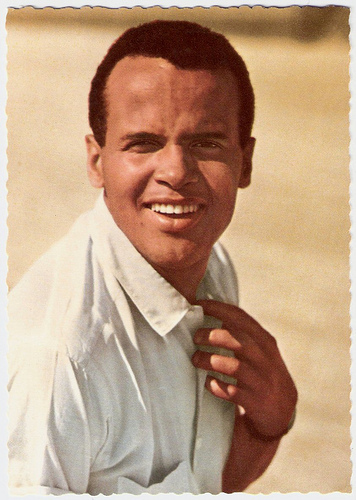
German postcard by Ufa (Universum-Film Aktiengesellschaft), Berlin-Tempelhof, no. CK 232. Retail price: 30 Pfg. Photo: Fried Agency.
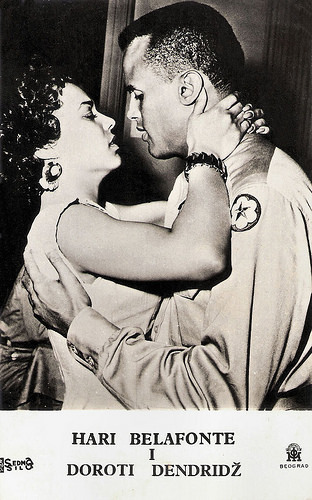
Yugoslavian postcard by IOM, Beograd. Photo: Sedmo Silo. Publicity still for Carmen Jones (Otto Preminger, 1954) with Dorothy Dandridge .
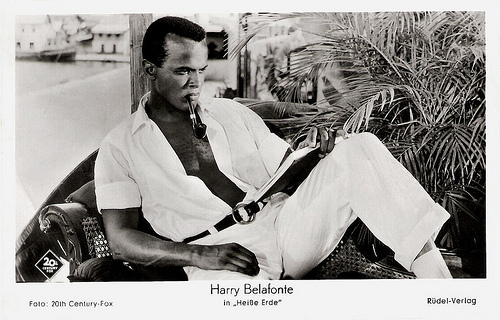
German postcard by Rüdel-Verlag, Hamburg-Bergedorf, no. 2186. Photo: 20th Century Fox. Publicity still for Island in the Sun (Robert Rossen, 1957).
The King of Calypso
Harry Belafonte was born Harold George Bellanfanti Jr. at Lying-in Hospital in 1927, in Harlem, New York. He was the son of Melvine (née Love), a housekeeper, and Harold George Bellanfanti Sr., who worked as a chef. His mother was born in Jamaica, the child of a Scottish white mother and a black father. His father also was born in Jamaica, the child of a black mother and Dutch Jewish father of Sephardi origins.
From 1932 to 1940, he lived with one of his grandmothers in her native country of Jamaica, where he attended Wolmer's Schools. When he returned to New York City, he attended George Washington High School after which he joined the Navy and served during World War II.
In the 1940s, he was working as a janitor's assistant in NYC when a tenant gave him, as a gratuity, two tickets to see the American Negro Theater. He fell in love with the art form and also met Sidney Poitier. The financially struggling pair regularly purchased a single seat to local plays, trading places in between acts, after informing the other about the progression of the play.
At the end of the 1940s, he took classes in acting at the Dramatic Workshop of The New School in New York with the influential German director Erwin Piscator alongside Marlon Brando , Tony Curtis, Walter Matthau, Bea Arthur, and Sidney Poitier, while performing with the American Negro Theatre in such plays as 'Days of Our Youth' (1946). In 1954, he would receive a Tony Award for his participation in the Broadway revue 'John Murray Anderson's Almanac'.
Belafonte started his career in music as a club singer in New York to pay for his acting classes. The first time he appeared in front of an audience at the Village Vanguard in New York, he was backed by the Charlie Parker band, which included Charlie Parker himself, Max Roach and Miles Davis, among others. At first, he was a pop singer, launching his recording career on the Roost label in 1949, but later he developed a keen interest in folk music, learning material through the Library of Congress' American folk songs archives. With guitarist and friend Millard Thomas, Belafonte soon made his debut at the legendary jazz club The Village Vanguard.
In 1952, he received a contract with RCA Victor. His first widely released single, which went on to become his 'signature' song with audience participation in virtually all his live performances, was 'Matilda' (1953). His breakthrough album 'Calypso' (1956) became the first LP in the world to sell over 1 million copies within a year. It spent 31 weeks at number 1, 58 weeks in the top ten, and 99 weeks on the U.S. charts. The album introduced American audiences to calypso music, which had originated in Trinidad and Tobago in the early 20th century.
Belafonte was dubbed the 'King of Calypso', a title he wore with reservations since he had no claims to any Calypso Monarch titles. One of the songs included in the album is the now famous 'Banana Boat Song' (listed as 'Day O' on the original release), which reached number five on the pop charts. His other smash hit was 'Jump in the Line'. Many of the compositions recorded for Calypso, including 'Banana Boat Song', gave songwriting credit to Irving Burgie.
His triumphant success as an entertainer in the arts did not protect Belafonte from racial discrimination, particularly in the South. As a result, he refused to perform in the southern region of the United States from 1954 until 1961.
Belafonte's first film role was in Bright Road (Gerald Mayer, 1953), in which he appeared alongside Dorothy Dandridge . In this low-budget film adapted from the Christopher Award-winning short story 'See How They Run' by Mary Elizabeth Vroman, Dandridge starred as an idealistic first-year elementary school teacher trying to reach out to a problem student. Belafonte played the principal of the school.
The two subsequently starred in Otto Preminger's hit musical Carmen Jones (1954). The screenplay by Harry Kleiner was based on the lyrics and book by Oscar Hammerstein II, from the 1943 stage musical of the same name, set to the music of Georges Bizet's 1875 opera 'Carmen'. Ironically, Belafonte's singing in the film was dubbed by an opera singer, as Belafonte's own singing voice was seen as unsuitable for the role.
Using his star clout, Belafonte was subsequently able to realise several then-controversial film roles. Island in the Sun (Robert Rossen, 1957) is about race relations and interracial romance set in the fictitious island of Santa Marta. The film was controversial at the time of its release for its hints of an affair between Belafonte's character and the character played by Joan Fontaine. The film also starred James Mason , Dorothy Dandridge and Joan Collins .
In 1959, he starred in and produced the Film Noir Odds Against Tomorrow (Robert Wise, 1959), in which he played a bank robber uncomfortably teamed with a racist partner (Robert Ryan). He also co-starred with Inger Stevens in the Science-Fiction doomsday film The World, the Flesh and the Devil (Ranald MacDougall, 1959).
Belafonte was offered the role of Porgy in Porgy and Bess (Otto Preminger, 1959), based on the 1935 opera Porgy and Bess by George Gershwin, DuBose Heyward, and Ira Gershwin. Here he would have once again starred opposite Dorothy Dandridge , but he refused the role because he objected to its racial stereotyping. Sidney Poitier would play the role in the film. Dissatisfied with the film roles available to him, he returned to music during the 1960s.
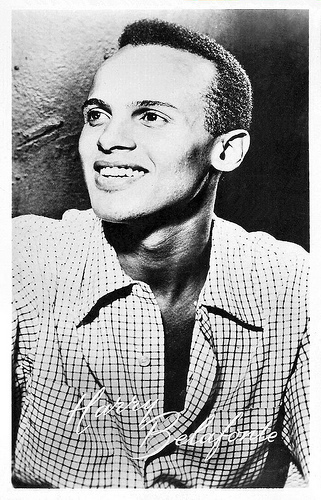
Dutch postcard by Uitgeverij Takken, Utrecht, no. 2054.
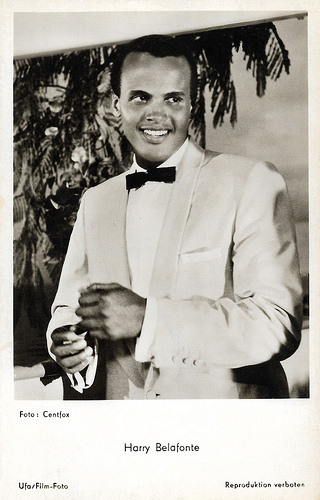
German postcard by Ufa/Film-Foto, Berlin-Tempelhof, no. FK 3791. Photo: Centfox. Publicity still for Island in the Sun (Robert Rossen, 1957).
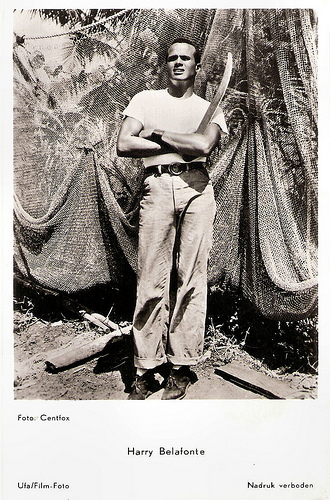
Dutch postcard by Gebr. Spanjersberg N.V., Rotterdam, no. 3793. Photo: Centfox. Publicity still for Island in the Sun (Robert Rossen, 1957).
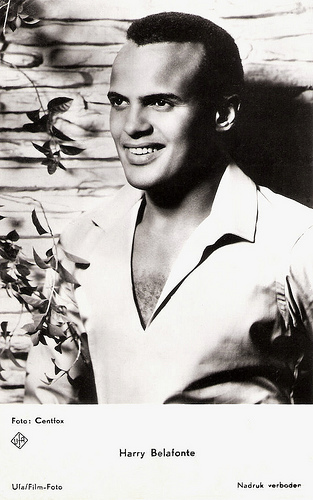
Dutch postcard by Gebr. Spanjersberg N.V., Rotterdam, no. 4022. Photo: Centfox. Publicity still for Island in the Sun (Robert Rossen, 1957).
The Banana Boat Song
While primarily known for calypso, Harry Belafonte has recorded in many different genres, including blues, folk, gospel, show tunes, and American standards. His second-most popular hit, which came immediately after 'The Banana Boat Song', was the comedic tune 'Mama Look at Bubu', also known as 'Mama Look a Boo-Boo' (originally recorded by Lord Melody in 1955), in which he sings humorously about misbehaving and disrespectful children. It reached number eleven on the pop chart.
In 1959, he starred in Tonight With Belafonte, a nationally televised special that featured Odetta. Belafonte was the first Jamaican American to win an Emmy, for Revlon Revue: Tonight with Belafonte (1959). Belafonte recorded for RCA Victor from 1953 to 1974. Two live albums, both recorded at Carnegie Hall in 1959 and 1960, enjoyed critical and commercial success. From his 1959 album, 'Hava Nagila' became part of his regular routine and one of his signature songs.
He was one of many entertainers recruited by Frank Sinatra to perform at the inaugural gala of President John F. Kennedy in 1961. That same year he released his second calypso album, 'Jump Up Calypso', which went on to become another million seller. During the 1960s he introduced several artists to American audiences, most notably South African singer Miriam Makeba and Greek singer Nana Mouskouri. His album 'Midnight Special' (1962) included a young harmonica player named Bob Dylan.
As The Beatles and other stars from Britain began to dominate the pop charts, Belafonte's commercial success diminished. His 'Belafonte at The Greek Theatre' was his last album to appear in Billboard's Top 40. His last hit single, 'A Strange Song', was released in 1967 and peaked at number 5 on the charts. Belafonte has received Grammy Awards for the albums 'Swing Dat Hammer' (1960) and 'An Evening with Belafonte/Makeba' (1965). The latter album dealt with the political plight of black South Africans under apartheid.
In 1967, Belafonte was the first non-classical artist to perform at the prestigious Saratoga Performing Arts Center (SPAC) in Upstate New York, soon to be followed by concerts there by The Doors, The 5th Dimension, The Who, and Janis Joplin. In February 1968, Belafonte guest hosted The Tonight Show substituting for Johnny Carson. Among his interview guests were Martin Luther King Jr. and Sen. Robert F. Kennedy.
During the 1960s, he appeared on TV specials alongside such artists as Julie Andrews , Petula Clark , Lena Horne, and Nana Mouskouri. In 1968, Belafonte appeared on a Petula Clark TV special on NBC. In the middle of a song, Clark smiled and briefly touched Belafonte's arm. The show's sponsor, Plymouth Motors, wanted to cut out the segment, but Clark, who had ownership of the special, told NBC that the performance would be shown intact or not at all. American newspapers published articles reporting the controversy and, when the special aired, it grabbed huge ratings.
In the early 1970s, Belafonte returned to the cinema in two films with Sidney Poitier. The Western Buck and the Preacher (Sidney Poitier, 1972) broke Hollywood Western traditions by casting blacks as central characters and portraying both tension and solidarity between African Americans and Native Americans in the late 19th century. Buck and the Preacher was one of the first films directed by an African American and to be based on a band of African Americans fighting against the White majority. The film was produced by Belafonte Enterprises, Columbia Pictures Corporation, and E & R Productions Corp.
Uptown Saturday Night (Sidney Poitier, 1974) is an action comedy crime film written by Richard Wesley and starring Sidney Poitier, Bill Cosby and Harry Belafonte. Although the film received mixed reviews, it was a commercial success and was part of the Blaxploitation wave. Later, Cosby and Poitier teamed up again, without Belafonte, for the sequels Let's Do It Again (Sidney Poitier, 1975) and A Piece of the Action (Sidney Poitier, 1977).
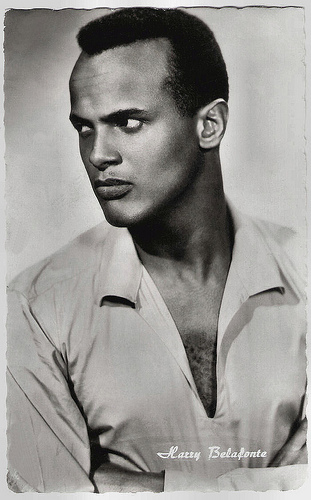
Dutch postcard, no. 2099. Photo: Centfox. Publicity still for Island in the Sun (Robert Rossen, 1957).
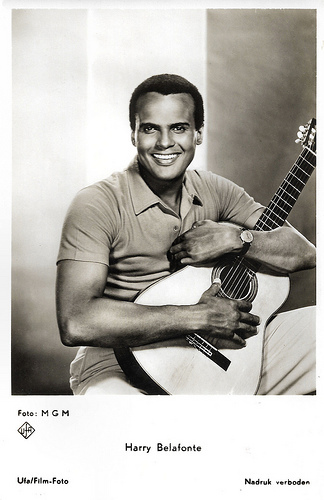
Dutch postcard by D.R.C., Holland, no. 1172. Photo: MGM /Ufa.
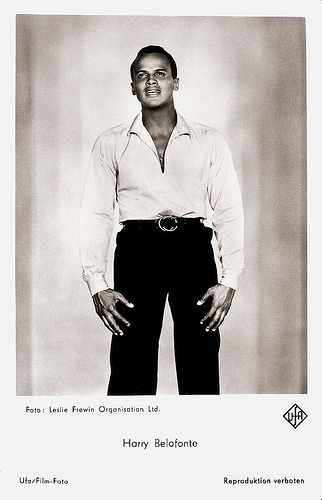
German postcard by Ufa/Film-Foto, Berlin-Tempelhof, no. FK 4282. Photo: Leslie Frewin Organisation Ltd.
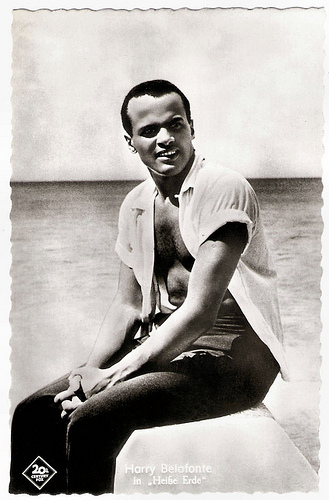
German postcard by Kolibri-Verlag, Minden/Westf., no. 2945. Photo: 20th Century Fox. Publicity still for Island in the Sun (Robert Rossen, 1957).
Always outspoken in his beliefs
Harry Belafonte's recording activity slowed after he left RCA in the mid-1970s. RCA released his fifth and final Calypso album, 'Calypso Carnival' in 1971. From the mid-1970s to early 1980s, Belafonte spent the greater part of his time touring Japan, Europe, Cuba and elsewhere. In 1977, he released the album 'Turn the World Around' at Columbia Records. The album, with a strong focus on world music, was never issued in the United States.
He subsequently was a guest star on a memorable episode of The Muppet Show (1978), in which he performed his signature song 'Day-O' on television for the first time. However, the episode is best known for Belafonte's rendition of the spiritual song 'Turn the World Around', from the album of the same name, which he performed with specially made Muppets that resembled African tribal masks. Belafonte reprised the song at John Henson's memorial in 1990.
In 1984, Belafonte produced and scored the musical film Beat Street (Stan Lathan, 1984). Set in the South Bronx, the film follows the lives of a pair of brothers and their group of friends, all of whom are devoted to various elements of early hip hop culture. The cast included Rae Dawn Chong and Guy Davis. Together with Arthur Baker, Belafonte produced the gold-certified soundtrack of the same name. Beat Street's impact was felt internationally as well as throughout the United States. In Germany, for example, films as Beat Street are credited with introducing the hip hop movement to the country.
In 1985, he was one of the organisers behind the Grammy Award winning song 'We Are the World', a multi-artist effort to raise funds for Africa, and performed in the Live Aid concert that same year. Belafonte's involvement in 'USA for Africa' resulted in renewed interest in his music, culminating in a record deal with EMI. He subsequently released his first album of original material in over a decade, 'Paradise in Gazankulu', (1988). The album contains ten protest songs against the South African former Apartheid policy and is his last studio album.
As UNICEF Goodwill Ambassador, Belafonte attended in 1988 a symposium in Harare, Zimbabwe, to focus attention on child survival and development in Southern African countries. As part of the symposium, he performed a concert for UNICEF. A Kodak video crew filmed the concert, which was released as a 60-minute concert video titled Global Carnival. Also in 1988, Tim Burton used 'The Banana Boat Song' and 'Jump in the Line' in his film Beetlejuice (Tim Burton, 1988).
Belafonte appeared with John Travolta in the film drama White Man's Burden (1995), about racism in an alternative America where black and white Americans have reversed cultural roles. The film was written and directed by Desmond Nakano. The film revolves around Louis Pinnock (Travolta), a white factory worker, who kidnaps Thaddeus Thomas (Belafonte), a black factory owner for firing him over a perceived slight. The film gained a negative reception from the critics and was not a box office success.
For Robert Altman's jazz age drama Kansas City (1996), he won the New York Film Critics Circle Award for Best Supporting Actor. Kansas City, which stars Jennifer Jason Leigh and Miranda Richardson, is also notable for its musical score being integrated into the film, with modern-day musicians recreating the Kansas City jazz of 1930s. For instance, Craig Handy played the role of Coleman Hawkins, Geri Allen played Mary Lou Williams, and James Carter played Ben Webster.
Following a lengthy recording hiatus, 'An Evening with Harry Belafonte and Friends' (1997), a soundtrack and video of a televised concert, were released by Island Records. 'The Long Road to Freedom: An Anthology of Black Music', a huge multi-artist project recorded by RCA during the 1960s and 1970s, was finally released by the label in 2001. Belafonte went on the Today Show to promote the album on 11 September 2001, and was interviewed by Katie Couric just minutes before the first plane hit the World Trade Center. The album was nominated for the 2002 Grammy Awards for Best Boxed Recording Package, for Best Album Notes, and for Best Historical Album.
On television, Harry Belafonte starred as an Associate Justice of the Supreme Court of the United States in the TV drama Swing Vote (David Anspaugh, 1999) with Andy Garcia. In 2006, Belafonte appeared in the film Bobby, Emilio Estevez's ensemble drama about the assassination of Robert F. Kennedy. Belafonte played Nelson, a friend of an employee of the Ambassador Hotel (Anthony Hopkins).
Belafonte received the Kennedy Center Honors in 1989. He was awarded the National Medal of Arts in 1994 and he won a Grammy Lifetime Achievement Award in 2000. He performed sold-out concerts globally through the 1950s to the 2000s. Owing to illness, he was forced to cancel a reunion tour with Nana Mouskouri planned for the spring and summer of 2003 following a tour in Europe. His last concert was a benefit concert for the Atlanta Opera on 25 October 2003. In a 2007 interview, he stated that he had since retired from performing. In 2017 Harry Belafonte released 'When Colors Come Together', an anthology of his music for Sony Legends produced by his son David Belafonte. David wrote a remake of 'Island In The Sun', arranged by longtime Belafonte musical director Richard Cummings featuring Harry Belafonte's grandchildren Sarafina and Amadeus and a children's choir.
Always outspoken in his beliefs, Belafonte achieved widespread attention for his political views in 2002 when he began making a series of negative comments about President George W. Bush and the Iraq War. Belafonte created controversy in October 2002 when he made disparaging remarks about Secretary of State Colin Powell. Far from being upset, Powell reportedly took the remarks good-humoured, refusing to inflame the situation any further. Belafonte's other controversial political statements on of U.S. foreign policy have included opposing the U.S. embargo on Cuba, praising Soviet peace initiatives, attacking the U.S. invasion of Grenada, praising the Abraham Lincoln Brigade, honouring Ethel and Julius Rosenberg and praising Fidel Castro. On a Martin Luther King Day speech at Duke University in 2006, Belafonte compared the American government to the 9/11 terrorists.
Belafonte and his first wife Marguerite Byrd were married from 1948 to 1957. They have two daughters: Adrienne and Shari, who also worked as an actress. In 1957, Belafonte married his second wife Julie Robinson, a former dancer with the Katherine Dunham Company who was of Jewish descent. They had two children, David and Gina. David, the only son of Harry Belafonte, is a former model and actor and is an Emmy-winning and Grammy nominated music producer and the executive director of the family-held company Belafonte Enterprises Inc. As a music producer, David has been involved in most of Belafonte's albums and tours and productions. After 47 years of marriage, Belafonte and Robinson got a divorce. In April 2008, Harry Belafonte married photographer Pamela Frank.
Recently, Belafonte returned to the cinema in Spike Lee's biographical crime film BlacKkKlansman (2018) as an elderly civil rights pioneer. Set in 1970s Colorado Springs, the plot follows the first African-American detective in the city's police department as he sets out to infiltrate and expose the local chapter of the Ku Klux Klan. BlacKkKlansman premiered at the 2018 Cannes Film Festival, where it won the Grand Prix. Belafonte appears in the film recounting the lynching of Jesse Washington, a black teenage farmhand who was lynched in the county seat of Waco, Texas, on 15 May 1916, in what became a well-known example of racially motivated lynching. In 2019, the film won an Oscar for Best Adapted Screenplay. It was written by Charlie Wachtel, David Rabinowitz, Kevin Willmott and Spike Lee.
Trailer for Bright Road (1953). Source: Department of Afro-American Research Arts Culture (YouTube).
Harry Belafonte sings the title song from Island In The Sun (1957) on TV. Source: Kester 1940 (YouTube).
'Day-O' (The Banana Boat Song) in Beetlejuice (1988). Source: Lipebianc (YouTube).
Harry Belafonte and The Muppets perform 'Earth Song'. Source: LenușTM (YouTube).
Sources: Wikipedia and .

German postcard by Ufa (Universum-Film Aktiengesellschaft), Berlin-Tempelhof, no. CK 232. Retail price: 30 Pfg. Photo: Fried Agency.

Yugoslavian postcard by IOM, Beograd. Photo: Sedmo Silo. Publicity still for Carmen Jones (Otto Preminger, 1954) with Dorothy Dandridge .

German postcard by Rüdel-Verlag, Hamburg-Bergedorf, no. 2186. Photo: 20th Century Fox. Publicity still for Island in the Sun (Robert Rossen, 1957).
The King of Calypso
Harry Belafonte was born Harold George Bellanfanti Jr. at Lying-in Hospital in 1927, in Harlem, New York. He was the son of Melvine (née Love), a housekeeper, and Harold George Bellanfanti Sr., who worked as a chef. His mother was born in Jamaica, the child of a Scottish white mother and a black father. His father also was born in Jamaica, the child of a black mother and Dutch Jewish father of Sephardi origins.
From 1932 to 1940, he lived with one of his grandmothers in her native country of Jamaica, where he attended Wolmer's Schools. When he returned to New York City, he attended George Washington High School after which he joined the Navy and served during World War II.
In the 1940s, he was working as a janitor's assistant in NYC when a tenant gave him, as a gratuity, two tickets to see the American Negro Theater. He fell in love with the art form and also met Sidney Poitier. The financially struggling pair regularly purchased a single seat to local plays, trading places in between acts, after informing the other about the progression of the play.
At the end of the 1940s, he took classes in acting at the Dramatic Workshop of The New School in New York with the influential German director Erwin Piscator alongside Marlon Brando , Tony Curtis, Walter Matthau, Bea Arthur, and Sidney Poitier, while performing with the American Negro Theatre in such plays as 'Days of Our Youth' (1946). In 1954, he would receive a Tony Award for his participation in the Broadway revue 'John Murray Anderson's Almanac'.
Belafonte started his career in music as a club singer in New York to pay for his acting classes. The first time he appeared in front of an audience at the Village Vanguard in New York, he was backed by the Charlie Parker band, which included Charlie Parker himself, Max Roach and Miles Davis, among others. At first, he was a pop singer, launching his recording career on the Roost label in 1949, but later he developed a keen interest in folk music, learning material through the Library of Congress' American folk songs archives. With guitarist and friend Millard Thomas, Belafonte soon made his debut at the legendary jazz club The Village Vanguard.
In 1952, he received a contract with RCA Victor. His first widely released single, which went on to become his 'signature' song with audience participation in virtually all his live performances, was 'Matilda' (1953). His breakthrough album 'Calypso' (1956) became the first LP in the world to sell over 1 million copies within a year. It spent 31 weeks at number 1, 58 weeks in the top ten, and 99 weeks on the U.S. charts. The album introduced American audiences to calypso music, which had originated in Trinidad and Tobago in the early 20th century.
Belafonte was dubbed the 'King of Calypso', a title he wore with reservations since he had no claims to any Calypso Monarch titles. One of the songs included in the album is the now famous 'Banana Boat Song' (listed as 'Day O' on the original release), which reached number five on the pop charts. His other smash hit was 'Jump in the Line'. Many of the compositions recorded for Calypso, including 'Banana Boat Song', gave songwriting credit to Irving Burgie.
His triumphant success as an entertainer in the arts did not protect Belafonte from racial discrimination, particularly in the South. As a result, he refused to perform in the southern region of the United States from 1954 until 1961.
Belafonte's first film role was in Bright Road (Gerald Mayer, 1953), in which he appeared alongside Dorothy Dandridge . In this low-budget film adapted from the Christopher Award-winning short story 'See How They Run' by Mary Elizabeth Vroman, Dandridge starred as an idealistic first-year elementary school teacher trying to reach out to a problem student. Belafonte played the principal of the school.
The two subsequently starred in Otto Preminger's hit musical Carmen Jones (1954). The screenplay by Harry Kleiner was based on the lyrics and book by Oscar Hammerstein II, from the 1943 stage musical of the same name, set to the music of Georges Bizet's 1875 opera 'Carmen'. Ironically, Belafonte's singing in the film was dubbed by an opera singer, as Belafonte's own singing voice was seen as unsuitable for the role.
Using his star clout, Belafonte was subsequently able to realise several then-controversial film roles. Island in the Sun (Robert Rossen, 1957) is about race relations and interracial romance set in the fictitious island of Santa Marta. The film was controversial at the time of its release for its hints of an affair between Belafonte's character and the character played by Joan Fontaine. The film also starred James Mason , Dorothy Dandridge and Joan Collins .
In 1959, he starred in and produced the Film Noir Odds Against Tomorrow (Robert Wise, 1959), in which he played a bank robber uncomfortably teamed with a racist partner (Robert Ryan). He also co-starred with Inger Stevens in the Science-Fiction doomsday film The World, the Flesh and the Devil (Ranald MacDougall, 1959).
Belafonte was offered the role of Porgy in Porgy and Bess (Otto Preminger, 1959), based on the 1935 opera Porgy and Bess by George Gershwin, DuBose Heyward, and Ira Gershwin. Here he would have once again starred opposite Dorothy Dandridge , but he refused the role because he objected to its racial stereotyping. Sidney Poitier would play the role in the film. Dissatisfied with the film roles available to him, he returned to music during the 1960s.

Dutch postcard by Uitgeverij Takken, Utrecht, no. 2054.

German postcard by Ufa/Film-Foto, Berlin-Tempelhof, no. FK 3791. Photo: Centfox. Publicity still for Island in the Sun (Robert Rossen, 1957).

Dutch postcard by Gebr. Spanjersberg N.V., Rotterdam, no. 3793. Photo: Centfox. Publicity still for Island in the Sun (Robert Rossen, 1957).

Dutch postcard by Gebr. Spanjersberg N.V., Rotterdam, no. 4022. Photo: Centfox. Publicity still for Island in the Sun (Robert Rossen, 1957).
The Banana Boat Song
While primarily known for calypso, Harry Belafonte has recorded in many different genres, including blues, folk, gospel, show tunes, and American standards. His second-most popular hit, which came immediately after 'The Banana Boat Song', was the comedic tune 'Mama Look at Bubu', also known as 'Mama Look a Boo-Boo' (originally recorded by Lord Melody in 1955), in which he sings humorously about misbehaving and disrespectful children. It reached number eleven on the pop chart.
In 1959, he starred in Tonight With Belafonte, a nationally televised special that featured Odetta. Belafonte was the first Jamaican American to win an Emmy, for Revlon Revue: Tonight with Belafonte (1959). Belafonte recorded for RCA Victor from 1953 to 1974. Two live albums, both recorded at Carnegie Hall in 1959 and 1960, enjoyed critical and commercial success. From his 1959 album, 'Hava Nagila' became part of his regular routine and one of his signature songs.
He was one of many entertainers recruited by Frank Sinatra to perform at the inaugural gala of President John F. Kennedy in 1961. That same year he released his second calypso album, 'Jump Up Calypso', which went on to become another million seller. During the 1960s he introduced several artists to American audiences, most notably South African singer Miriam Makeba and Greek singer Nana Mouskouri. His album 'Midnight Special' (1962) included a young harmonica player named Bob Dylan.
As The Beatles and other stars from Britain began to dominate the pop charts, Belafonte's commercial success diminished. His 'Belafonte at The Greek Theatre' was his last album to appear in Billboard's Top 40. His last hit single, 'A Strange Song', was released in 1967 and peaked at number 5 on the charts. Belafonte has received Grammy Awards for the albums 'Swing Dat Hammer' (1960) and 'An Evening with Belafonte/Makeba' (1965). The latter album dealt with the political plight of black South Africans under apartheid.
In 1967, Belafonte was the first non-classical artist to perform at the prestigious Saratoga Performing Arts Center (SPAC) in Upstate New York, soon to be followed by concerts there by The Doors, The 5th Dimension, The Who, and Janis Joplin. In February 1968, Belafonte guest hosted The Tonight Show substituting for Johnny Carson. Among his interview guests were Martin Luther King Jr. and Sen. Robert F. Kennedy.
During the 1960s, he appeared on TV specials alongside such artists as Julie Andrews , Petula Clark , Lena Horne, and Nana Mouskouri. In 1968, Belafonte appeared on a Petula Clark TV special on NBC. In the middle of a song, Clark smiled and briefly touched Belafonte's arm. The show's sponsor, Plymouth Motors, wanted to cut out the segment, but Clark, who had ownership of the special, told NBC that the performance would be shown intact or not at all. American newspapers published articles reporting the controversy and, when the special aired, it grabbed huge ratings.
In the early 1970s, Belafonte returned to the cinema in two films with Sidney Poitier. The Western Buck and the Preacher (Sidney Poitier, 1972) broke Hollywood Western traditions by casting blacks as central characters and portraying both tension and solidarity between African Americans and Native Americans in the late 19th century. Buck and the Preacher was one of the first films directed by an African American and to be based on a band of African Americans fighting against the White majority. The film was produced by Belafonte Enterprises, Columbia Pictures Corporation, and E & R Productions Corp.
Uptown Saturday Night (Sidney Poitier, 1974) is an action comedy crime film written by Richard Wesley and starring Sidney Poitier, Bill Cosby and Harry Belafonte. Although the film received mixed reviews, it was a commercial success and was part of the Blaxploitation wave. Later, Cosby and Poitier teamed up again, without Belafonte, for the sequels Let's Do It Again (Sidney Poitier, 1975) and A Piece of the Action (Sidney Poitier, 1977).

Dutch postcard, no. 2099. Photo: Centfox. Publicity still for Island in the Sun (Robert Rossen, 1957).

Dutch postcard by D.R.C., Holland, no. 1172. Photo: MGM /Ufa.

German postcard by Ufa/Film-Foto, Berlin-Tempelhof, no. FK 4282. Photo: Leslie Frewin Organisation Ltd.

German postcard by Kolibri-Verlag, Minden/Westf., no. 2945. Photo: 20th Century Fox. Publicity still for Island in the Sun (Robert Rossen, 1957).
Always outspoken in his beliefs
Harry Belafonte's recording activity slowed after he left RCA in the mid-1970s. RCA released his fifth and final Calypso album, 'Calypso Carnival' in 1971. From the mid-1970s to early 1980s, Belafonte spent the greater part of his time touring Japan, Europe, Cuba and elsewhere. In 1977, he released the album 'Turn the World Around' at Columbia Records. The album, with a strong focus on world music, was never issued in the United States.
He subsequently was a guest star on a memorable episode of The Muppet Show (1978), in which he performed his signature song 'Day-O' on television for the first time. However, the episode is best known for Belafonte's rendition of the spiritual song 'Turn the World Around', from the album of the same name, which he performed with specially made Muppets that resembled African tribal masks. Belafonte reprised the song at John Henson's memorial in 1990.
In 1984, Belafonte produced and scored the musical film Beat Street (Stan Lathan, 1984). Set in the South Bronx, the film follows the lives of a pair of brothers and their group of friends, all of whom are devoted to various elements of early hip hop culture. The cast included Rae Dawn Chong and Guy Davis. Together with Arthur Baker, Belafonte produced the gold-certified soundtrack of the same name. Beat Street's impact was felt internationally as well as throughout the United States. In Germany, for example, films as Beat Street are credited with introducing the hip hop movement to the country.
In 1985, he was one of the organisers behind the Grammy Award winning song 'We Are the World', a multi-artist effort to raise funds for Africa, and performed in the Live Aid concert that same year. Belafonte's involvement in 'USA for Africa' resulted in renewed interest in his music, culminating in a record deal with EMI. He subsequently released his first album of original material in over a decade, 'Paradise in Gazankulu', (1988). The album contains ten protest songs against the South African former Apartheid policy and is his last studio album.
As UNICEF Goodwill Ambassador, Belafonte attended in 1988 a symposium in Harare, Zimbabwe, to focus attention on child survival and development in Southern African countries. As part of the symposium, he performed a concert for UNICEF. A Kodak video crew filmed the concert, which was released as a 60-minute concert video titled Global Carnival. Also in 1988, Tim Burton used 'The Banana Boat Song' and 'Jump in the Line' in his film Beetlejuice (Tim Burton, 1988).
Belafonte appeared with John Travolta in the film drama White Man's Burden (1995), about racism in an alternative America where black and white Americans have reversed cultural roles. The film was written and directed by Desmond Nakano. The film revolves around Louis Pinnock (Travolta), a white factory worker, who kidnaps Thaddeus Thomas (Belafonte), a black factory owner for firing him over a perceived slight. The film gained a negative reception from the critics and was not a box office success.
For Robert Altman's jazz age drama Kansas City (1996), he won the New York Film Critics Circle Award for Best Supporting Actor. Kansas City, which stars Jennifer Jason Leigh and Miranda Richardson, is also notable for its musical score being integrated into the film, with modern-day musicians recreating the Kansas City jazz of 1930s. For instance, Craig Handy played the role of Coleman Hawkins, Geri Allen played Mary Lou Williams, and James Carter played Ben Webster.
Following a lengthy recording hiatus, 'An Evening with Harry Belafonte and Friends' (1997), a soundtrack and video of a televised concert, were released by Island Records. 'The Long Road to Freedom: An Anthology of Black Music', a huge multi-artist project recorded by RCA during the 1960s and 1970s, was finally released by the label in 2001. Belafonte went on the Today Show to promote the album on 11 September 2001, and was interviewed by Katie Couric just minutes before the first plane hit the World Trade Center. The album was nominated for the 2002 Grammy Awards for Best Boxed Recording Package, for Best Album Notes, and for Best Historical Album.
On television, Harry Belafonte starred as an Associate Justice of the Supreme Court of the United States in the TV drama Swing Vote (David Anspaugh, 1999) with Andy Garcia. In 2006, Belafonte appeared in the film Bobby, Emilio Estevez's ensemble drama about the assassination of Robert F. Kennedy. Belafonte played Nelson, a friend of an employee of the Ambassador Hotel (Anthony Hopkins).
Belafonte received the Kennedy Center Honors in 1989. He was awarded the National Medal of Arts in 1994 and he won a Grammy Lifetime Achievement Award in 2000. He performed sold-out concerts globally through the 1950s to the 2000s. Owing to illness, he was forced to cancel a reunion tour with Nana Mouskouri planned for the spring and summer of 2003 following a tour in Europe. His last concert was a benefit concert for the Atlanta Opera on 25 October 2003. In a 2007 interview, he stated that he had since retired from performing. In 2017 Harry Belafonte released 'When Colors Come Together', an anthology of his music for Sony Legends produced by his son David Belafonte. David wrote a remake of 'Island In The Sun', arranged by longtime Belafonte musical director Richard Cummings featuring Harry Belafonte's grandchildren Sarafina and Amadeus and a children's choir.
Always outspoken in his beliefs, Belafonte achieved widespread attention for his political views in 2002 when he began making a series of negative comments about President George W. Bush and the Iraq War. Belafonte created controversy in October 2002 when he made disparaging remarks about Secretary of State Colin Powell. Far from being upset, Powell reportedly took the remarks good-humoured, refusing to inflame the situation any further. Belafonte's other controversial political statements on of U.S. foreign policy have included opposing the U.S. embargo on Cuba, praising Soviet peace initiatives, attacking the U.S. invasion of Grenada, praising the Abraham Lincoln Brigade, honouring Ethel and Julius Rosenberg and praising Fidel Castro. On a Martin Luther King Day speech at Duke University in 2006, Belafonte compared the American government to the 9/11 terrorists.
Belafonte and his first wife Marguerite Byrd were married from 1948 to 1957. They have two daughters: Adrienne and Shari, who also worked as an actress. In 1957, Belafonte married his second wife Julie Robinson, a former dancer with the Katherine Dunham Company who was of Jewish descent. They had two children, David and Gina. David, the only son of Harry Belafonte, is a former model and actor and is an Emmy-winning and Grammy nominated music producer and the executive director of the family-held company Belafonte Enterprises Inc. As a music producer, David has been involved in most of Belafonte's albums and tours and productions. After 47 years of marriage, Belafonte and Robinson got a divorce. In April 2008, Harry Belafonte married photographer Pamela Frank.
Recently, Belafonte returned to the cinema in Spike Lee's biographical crime film BlacKkKlansman (2018) as an elderly civil rights pioneer. Set in 1970s Colorado Springs, the plot follows the first African-American detective in the city's police department as he sets out to infiltrate and expose the local chapter of the Ku Klux Klan. BlacKkKlansman premiered at the 2018 Cannes Film Festival, where it won the Grand Prix. Belafonte appears in the film recounting the lynching of Jesse Washington, a black teenage farmhand who was lynched in the county seat of Waco, Texas, on 15 May 1916, in what became a well-known example of racially motivated lynching. In 2019, the film won an Oscar for Best Adapted Screenplay. It was written by Charlie Wachtel, David Rabinowitz, Kevin Willmott and Spike Lee.
Trailer for Bright Road (1953). Source: Department of Afro-American Research Arts Culture (YouTube).
Harry Belafonte sings the title song from Island In The Sun (1957) on TV. Source: Kester 1940 (YouTube).
'Day-O' (The Banana Boat Song) in Beetlejuice (1988). Source: Lipebianc (YouTube).
Harry Belafonte and The Muppets perform 'Earth Song'. Source: LenușTM (YouTube).
Sources: Wikipedia and .
Published on March 03, 2019 22:00
Paul van Yperen's Blog
- Paul van Yperen's profile
- 13 followers
Paul van Yperen isn't a Goodreads Author
(yet),
but they
do have a blog,
so here are some recent posts imported from
their feed.



